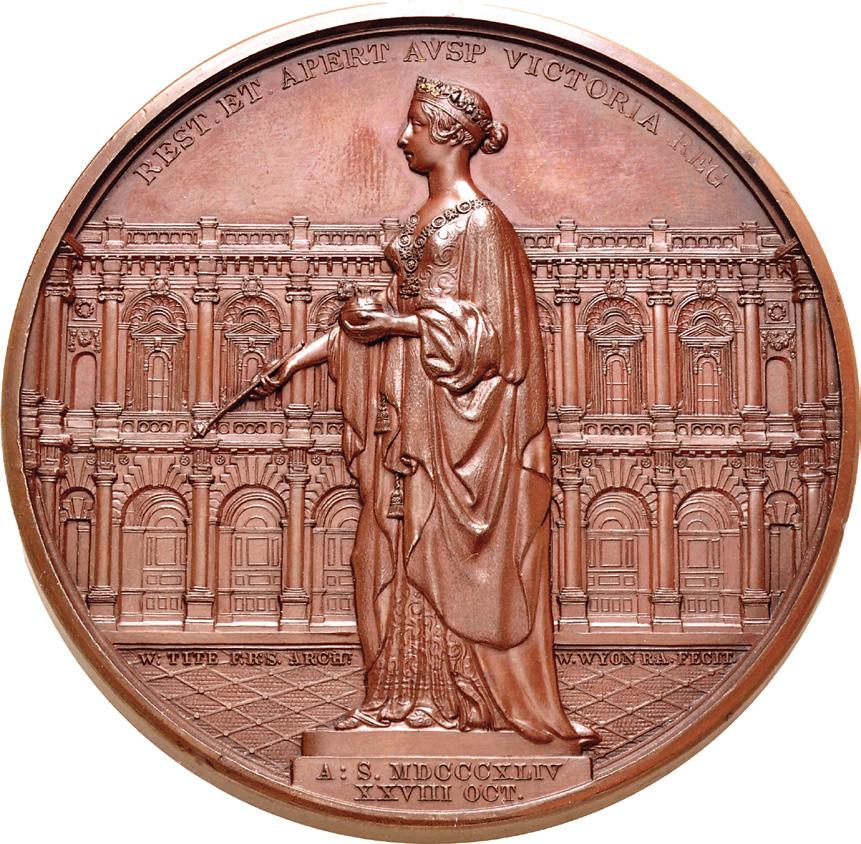
149 minute read
Coins for Sale
GREEK
563026. CALABRIA, Tarentum. Circa 302 BC. AR Nomos (22mm, 7.88 g, 6h). Nude youth, holding rein in left hand and crowning himself with wreath held aloft in right, on horseback right; below, sÅ above Ionic capital / Phalanthos, holding serpent in extended right hand, riding dolphin left; tÅrÅs to right, ˚o@ below. Fischer-Bossert Group 75, – (V378/R742 [unlisted die combination]); Vlasto 654, 656, and 658 (same obv. die); HN Italy 942; SNG ANS 1025 (same rev. die). Light iridescent tone, underlying luster, die break on reverse. EF. $4750
564444. CALABRIA, Tarentum. Circa 290-281 BC. AR Nomos (20mm, 7.95 g, 8h). Nude warrior, holding shield and two spears in left hand, preparing to cast a third spear held aloft in right hand, riding horse leaping right; s5Â below / Phalanthos, nude, holding distaff in right hand, riding dolphin left; to right, eagle, with wings closed, standing left; f5¬5s to left, waves below. Fischer-Bossert Group 78b, 1079 (V406/R828); Vlasto 574 (same dies); HN Italy 933; SNG ANS 981 (same dies); Côte I 231 (same dies). Lightly toned, underlying luster. EF. Excellent details on obverse. An impressive coin in hand. $4950
553983. CALABRIA, Tarentum. Circa 280 BC. AR Nomos (24mm, 7.85 g, 10h). Nude youth, holding rein in left hand, right hand placing laurel wreath on head of horse standing right, upon which he sits; sÅ to left, f5¬5>År≈os in two lines below / Phalanthos, nude, holding grape bunch in extended right hand, riding dolphin left; Å˝Å below. Vlasto 673; HN Italy 960; SNG ANS 1052. Iridescent tone, hairline flan crack, a little porosity on obverse. EF. Struck on a broad flan. $3500
553984. CALABRIA, Tarentum. Circa 240-228 BC. AR Nomos (20mm, 6.47 g, 12h). Reduced standard. Warrior, wearing military attire, holding Nike, who crowns him, in extended right hand, on horse rearing right; * to upper left, ˚Ŭ¬5˚rÅ>t˙s in two lines below / Phalanthos, nude, holding Nike, who crowns him, in extended right hand, and cradling trident in left arm, riding dolphin left; “ to right, tÅr[Ås] below. Vlasto 969; HN Italy 1059; SNG ANS 1262. Attractive light toning over lustrous surfaces. Superb EF. Exceptional for issue. $5250 13
Artistic Herakleia Nomos
564443. LUCANIA, Herakleia. Circa 390-340 BC. AR Nomos (21mm, 7.73 g, 1h). Head of Athena right, wearing triplependant earring, pearl necklace, and crested Attic helmet decorated with Skylla hurling a stone; d>˚>f to right / Herakles standing facing, upper torso turned right, wrestling with the Nemean Lion; club and ˚Ŭ to left, ^˙rå[k¬˙5W˜] to right; between Herakles’ legs, owl standing right, head facing. Work 39 (same dies); Van Keuren 50; HN Italy 1377; SNG ANS 63 = Sartiges 28 (same obv. die); SNG Lloyd 272 (same dies); Gillet 125; McClean 824 (same obv. die); Pozzi 148 (same dies); Ward 44 (same obv. die). Attractive deep iridescent tone. Good VF. Struck from wonderfully engraved dies for this type. $14,500
554909. LUCANIA, Metapontion. Circa 470-440 BC. AR Nomos (19.5mm, 7.86 g, 1h). Ear of barley with eight grains; Åt[Eµ] up left field; to right, grasshopper downward / Incuse ear of barley with seven grains. Noe 258 (same dies as illustration); HN Italy 1486; SNG Lloyd 317 (same dies); BMC 26 (same dies); Bement 162 (same dies); de Luynes 453 (same dies); McClean 906 (same dies). In NGC encapsulation 5745586-007, graded Ch AU, Strike: 4/5, Surface: 4/5. $3750
561908. LUCANIA, Sybaris. Circa 446-440 BC. AR Drachm (15mm, 2.65 g, 9h). Head of Athena right, wearing crested Attic helmet decorated on the bowl with a laurel wreath / Bull standing right, head left; sU∫År5 in exergue. HN Italy 1750; SNG ANS –; SNG Ashmolean 858. Lightly toned, some porosity, minor roughness in spots. Good VF. Very rare. $7750
564445. BRUTTIUM, Kroton. Circa 530-500 BC. AR Nomos (27mm, 8.26 g, 12h). Spread incuse type. Tripod, legs surmounted by wreaths and terminating in lion’s feet, between which are two serpents rising, spiral ornaments below the bowl; all set on basis of three lines, the center dotted; J®o to left / Incuse tripod as obverse, but no serpents or spiral ornaments. Gorini 1; Attianese 4; HN Italy 2075; SNG ANS 238–42; SNG Lloyd 592. Lightly toned. Choice EF. Well centered and excellent metal. $15,000
Ex Roma XIV (21 September 2017), lot 34.
Signed by Kratesippos
561909. BRUTTIUM, Rhegion. Circa 420-415/0 BC. AR Tetradrachm (23mm, 17.08 g, 6h). Reverse die signed by the engraver Kratesippos. Facing head of lion / Laureate head of Apollo right; olive sprig to left, r˙˝5@os to right, ˚rÅ[tE]/ oPP[5s] in two lines below chin. Herzfelder 64 (D36b/R53); HN Italy 2494; BMC 26 (same dies); Jameson 460 (same dies); Ognina 301–2 (same dies). Toned with iridescence on reverse. Good VF. $19,500
Ex Nomisma 55 (4 April 2017), lot 2; Tkalec (29 February 2000), lot 22; Triton I (2 December 1997), lot 178; A.D. Moretti Collection, reportedly purchased in 1952.
This magnificent tetradrachm is from a series at Rhegion that is regarded as having the most finely engraved dies of all the numismatic output of the mint. The artist Kratesippos is thought to have been one of the first engravers of this period.
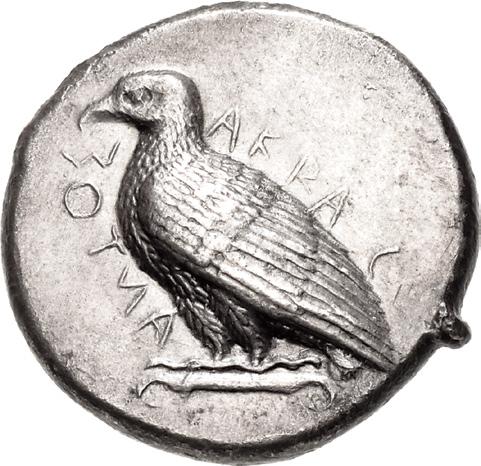
563027. SICILY, Akragas. Circa 465/0–445/0 BC. AR Tetradrachm (26mm, 17.08 g, 6h). Sea eagle standing left; Å˚RÅ1sotNÅ around / Crab within incuse circle; spiral floral ornament below. Westermark, Coinage, Period II, Group III, 416 (O16/R80); HGC 2, 79; SNG Lockett 695 (same obv. die); Basel 254 (same dies). Toned, traces of find patina, some faint cleaning marks. Good VF. $14,500 15
Artistic Excellence

563028. SICILY, Akragas. Circa 420-415 BC. AR Tetradrachm (26.5mm, 16.95 g, 10h). Sea eagle, wings raised, standing left on dead hare, upturned left on rock below; Å˚rÅ˝-Å@t5@-o-@ around / Crab; scallop shell to left, conch shell to right; below, grouper left. Westermark, Coinage, Period III, 530 (O1/R2); HGC 2, 81; SNG Lloyd 822; BMC 59; Basel 257; Boston MFA 235 = Warren 201; Gulbenkian 163 = Rizzo pl. I, 16; Gulbenkian 164 = Locker-Lampson 59; Kraay & Hirmer 173; Jameson 508; McClean 2044; Winterthur 577 = Pozzi 390 (all from the same dies). Toned, a few faint cleaning marks, light scratch in field on reverse. Good VF. Rare and artistic. $24,500
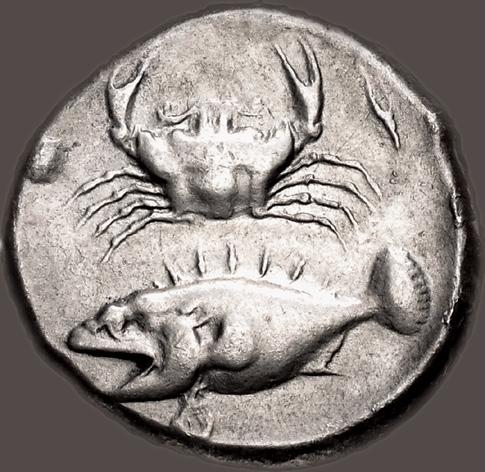

566432. SICILY, Entella. Punic issues. Circa 407-398 BC. AR Tetradrachm (24mm, 17.21 g, 7h). Forepart of horse advancing right; above, Nike flying right, crowning horse with open wreath held in both hands; barley grain to right / Palm tree with two date clusters, tDJteQ (QRTḤDT = “Carthage” in Punic) across lower field. Jenkins, Punic, Series 1, 25 corr. (O7/ R25; rev. legend); CNP 649b; HGC 2, 261. Lightly toned. Good VF. Well centered. $12,500
Ex MDC Monaco 3 (1 December 2017), lot 65; Astarte I (11 May 1998), lot 90.
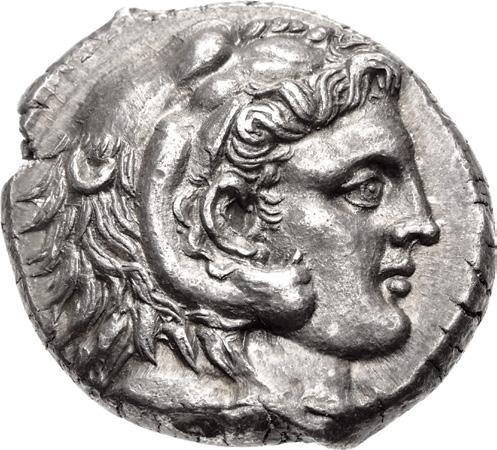
566372. SICILY, Entella. Punic issues. Circa 300-289 BC. AR Tetradrachm (26mm, 16.94 g, 11h). Head of Herakles right, wearing lion skin / Head of horse left; palm tree to right, †nJM∆M` (Punic ‘MHMḤNT) below. Jenkins, Punic, Series 5a, 319 (O103/R262); CNP 271; HGC 2, 293 corr. (varying legend); SNG Ashmolean 2165 (same dies); SNG Lloyd 1644 (same dies); Ward 361 (same dies). Attractively toned, underlying luster. EF. A spectacular portrait of Herakles. $17,500

Spectacular Gela Didrachm
563010. SICILY, Gela. Circa 490/85-480/75 BC. AR Didrachm (20mm, 8.70 g, 6h). Nude warrior riding right, preparing to cast javelin held aloft in his right hand / Forepart of man-headed bull right; 1E¬A above. Jenkins, Gela, Group Ib, 11 (O6’/ R5); HGC 2, 362; SNG München 254 (same dies); Jameson 582 (same dies). Beautiful light toning, underlying luster, die break on reverse. Choice EF. Perfectly centered. A spectacular coin and among the finest known for the series. $19,500
Ex Triton I (2 December 1997), lot 204.
Ex Berlin and Löbbecke Collections
566224. SICILY, Gela. Circa 420-415 BC. AR Tetradrachm (24.5mm, 17.58 g, 11h). Charioteer, holding kentron in right hand and reins in both, driving slow quadriga right; above, Nike flying left, crowning horses with [wreath held in both hands]; in exergue, heron standing right / Forepart of man-headed bull right; ˝E¬Ås above. Jenkins, Gela, Group VIII, 468 (O90/ R180); HGC 2, 354; SNG ANS 90; SNG Copenhagen 269; SNG Lloyd 971; BMC 50; de Luynes 957; McClean 2258; Ward 153; Weber 1324 (all from the same dies). Handsome old cabinet tone. Good VF. $12,500
Ex Gorny & Mosch 244 (6 March 2017), lot 56; Doubletten des Königsliche Münzkabinett Berlin (J. Hirsch XXVI, 23 May 1910), lot 69; Arthur Löbbecke Collection.

564447. SICILY, Gela. Circa 420-415 BC. AR Tetradrachm (26mm, 17.39 g, 7h). Charioteer, holding kentron in right hand and reins in both, driving slow quadriga right; above, Nike flying left, crowning charioteer with [wreath held in both hands]; in exergue, heron flying right / Forepart of man-headed bull right; sŬE˝ above. Jenkins, Gela, Group VIII, – (O92/R183 [unlisted die combination]); HGC 2, 356; SNG ANS 94–5 var. (ethnic not retrograde; same obv. die); SNG Lockett 770 = Pozzi 440 var. (same; same obv. die). Lightly toned over lustrous surfaces, some die rust on obverse. Superb EF. New die combination for series. $37,500
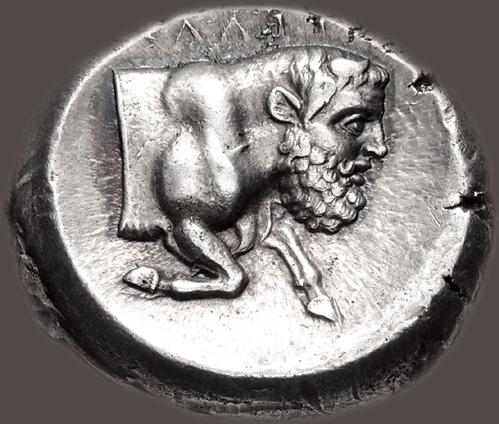
The Liberation of Katane
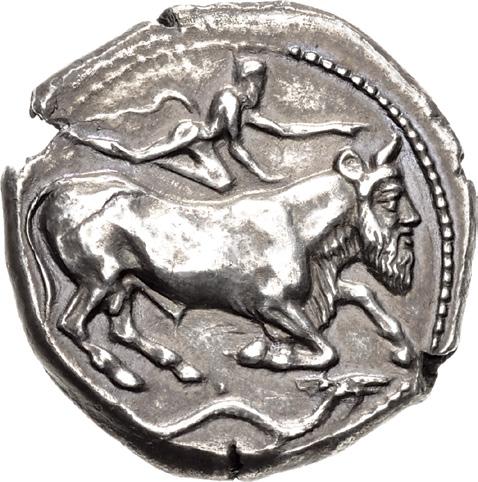
563142. SICILY, Katane. Circa 461-450 BC. AR Tetradrachm (26mm, 16.81 g, 10h). River-god Amenanos as a manheaded bull kneeling right; above, satyr running right, hands extended and raised before him; in exergue, ketos right / Nike running left, wearing long chiton, holding a fillet in her extended right hand; ˚ÅtÅ-˜-Å5o˜ clockwise around from upper left. Mirone 19 (same dies); HGC 2, 560; Basel 323 (same dies); Kraay & Hirmer 28; Rizzo pl. IX, 14 (same obv. die); Triton XXIII, lot 94 (same dies). Toned, light smoothing in fields on obverse, slight roughness and double struck on reverse. Near EF. Rare. $17,500
This tetradrachm is from the first coinage struck at Katane following the liberation of the city from Syracusan domination in the late 460s BC. The obverse of this series features the local river god Amenanos in the guise of a man-headed bull. On the reverse, the spirited figure of Nike holding a diadem appears to have an agonistic significance, as well as an allusion to the recent victory of the native Katanaians and the recovery of their city. Nearly all published examples of this issue have double-struck reverses.
564448. SICILY, Messana (as Zankle). Circa 500-493 BC. AR Litra (11mm, 0.59 g). Dolphin left within sickle-shaped harbor; Îån below / Nine-part incuse square with scallop shell in center. Gielow 72–8; HGC 2, 768. Find patina. Good VF. $2450

564449. SICILY, Messana. 412-408 BC. AR Tetradrachm (26mm, 17.33 g, 11h). Charioteer, holding kentron in left hand and reins in right, driving slow biga of mules left; above, Nike flying right, crowning charioteer with wreath held in extended right hand and fillet in left / Hare springing right; below, grain stalk left; µEssÅn5os in exergue. Caltabiano Series XVA, 615 (D220/R242); HGC 2, 797 (same obv. die as illustration); SNG ANS 378 (same obv. die); SNG Lloyd 1104 (same dies); Jameson 657 (same dies); Rizzo pl. XXVII, 5 (same obv. die). Lightly toned over lustrous surfaces. EF. $24,500

564480. SICILY, Panormos (as Ziz). Circa 370-360 BC. AR Tetradrachm (23mm, 17.13 g, 11h). Charioteer, holding kentron in extended right hand, reins in left, driving fast quadriga left; above, Nike, wearing long chiton, flying right, crowning charioteer with wreath she holds with both hands; sign of Tanit in central field, in exergue, swan flying left / Head of Arethousa right, hair in band, wearing single-pendant earring and linear necklace; four dolphins swimming around. Jenkins, Punic 39 (O10’/R33); HGC 2, 1014 corr. (some are anepigraphic); Jameson 1070 (same dies); Weber 1486 (same dies). Iridescent tone, compact flan, a couple of light scratches on reverse. Near EF. $7500
541292. SICILY, Syracuse. Dionysios I. 405-367 BC. AR Tetradrachm (23mm, 17.35 g, 9h). Unsigned dies in the style of Eukleidas. Struck circa 400/395-390 BC. Charioteer, holding kentron in right hand and reins in both, driving fast quadriga left; [above, Nike flying right, crowning charioteer with wreath held in both hands]; in exergue, dolphin left, its dorsal fin breaking the exergual line / Head of Arethousa left, hair in broad band and welling upwards in wavy locks, wearing double hoop earring and linear necklace; [s-U-rÅ˚-o-s-5W-@ above], four dolphins around. Fischer-Bossert, Coins 92 (O33/R64); Tudeer 92; HGC 2, 1345; SNG ANS 297 (same dies); SNG Lockett 979 = Dewing 858 = Pozzi 624 (same dies); Dewing 857 (same dies); Jameson 808 (same dies); Nanteuil 364 (same dies). Toned, struck from worn obverse die (as all Tudeer 92 pieces). Good VF. Fine style. $7500

Ex Weise Collection; Freeman & Sear 14 (21 June 2007), lot 118.
555887. CARTHAGE. Circa 350-320 BC. AV Stater (18mm, 9.22 g, 10h). Carthage mint. Wreathed head of Tanit left, wearing triple-pendant earring, and necklace with eleven pendants / Horse standing right; three pellets to right of foreleg. Jenkins & Lewis Group IIIf, 31 (same dies); MAA 4; CNP 1.5f. Lustrous, slight die wear. EF. Fine style. $15,000
555886. CARTHAGE. Circa 350-320 BC. AV Stater (18.5mm, 9.18 g, 5h). Carthage mint. Head of Tanit left, wearing wreath of grain ears, triple-pendant earring, and necklace with eight pendants / Horse standing right on exergual line; three pellets to right of foreleg (faintly visible). Jenkins & Lewis Group IIIh; CNP 1.5f; MAA 4. Lustrous, slight die wear. EF. Fine style. $15,000
541326. SKYTHIA, Geto-Dacians. Koson. Mid 1st century BC. AV Stater (20mm, 8.39 g, 12h). Roman consul accompanied by two lictors advancing left; û to left / Eagle standing left on scepter, holding wreath; pellet below raised claw. Hourmouziadis dies B/c; Iliescu 1; RPC I 1701A; HGC 3, 2049. Superb EF. $2750
Ex CNG inventory 736925 (February 2004).
Debate continues to swirl around this gold stater type, issued somewhere in Thrace or the Black Sea region in the name of an unrecorded dynast named Koson, but with a monogram and types suggesting a connection to the Marcus Junius Brutus, one of Julius Caesar’s assassins. The historian Appian records that Brutus struck gold coins from treasures consigned to him by Polemocratia, widow of a Thracian dynast named Sadalas. The great German historian Theodore Mommson, backed by the Austrian numismatist J.H. Eckhel, read the obverse monogram as a ligature of BR and assigned it to Brutus, an interpretation reinforced by the obverse type, a rough imitation of a denarius struck by Brutus as moneyer in 54 BC (the eagle on the obverse copies a rare denarius of Q. Pomponius Rufus, circa 70 BC). Max Bahrfelft, in an article in a Berlin journal of 1912, rejected this theory and instead associated the type with a Geto-Dacian dynast named Cotiso, cited by Appian and Suetonius as a contemporary of Octavian and Mark Antony. RPC retains the Thrace / Brutus attribution, although rather ambivalently noting “the Scythian origin is probably the correct one.”
566438. THRACE, Ainos. Circa 461/0-459/8 BC. AR Tetradrachm (22.5mm, 15.97 g, 1h). Head of Hermes right, wearing petasos with pelleted rim / Goat standing right; Å5@5 above, facing head of Silenos to lower right; all within incuse square. May, Ainos, Group VIII, 39 var. (A–/P31 [unlisted obv. die]); AMNG II 261; HGC 3, 1266; SNG Lockett 1153 (same rev. die). Toned, light pitting. Near EF. $17,000

Artistic Inebriated Dionysos

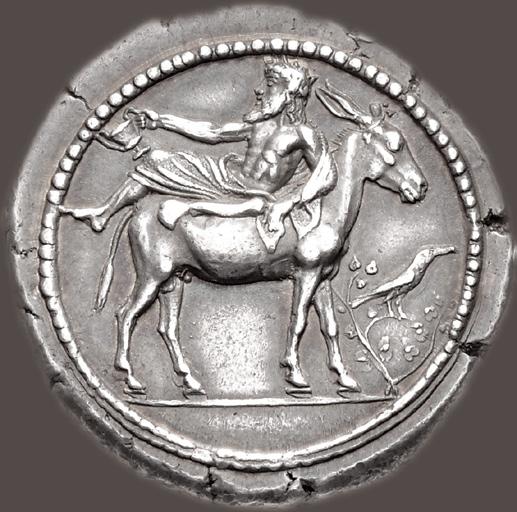
564452. MACEDON, Mende. Circa 460-423 BC. AR Tetradrachm (28.5mm, 17.28 g, 6h). Inebriated Dionysos, wearing chiton draped from his waist, holding in right hand a kantharos propped on his right knee, reclining left on the back of an ass standing right; to right, crow standing right on branches / µE@-dÅ-5-o@ within linear square around vine of six grape clusters within linear square; all within shallow incuse square. Noe, Mende 62/58 (same obv./rev. dies); HGC 3, 545; SNG ANS 337 (same dies). Iridescent tone. Superb EF. An exceptional example. $75,000

The city of Mende, located on the Pallene Peninsula on the eastern shore of the Thermaic Gulf, was, according to Thucydides (4.123.1), founded by Eretria in the 8th century. It later founded colonies of its own: Neapolis on the eastern coast of Pallene, and Eion at the mouth of the river Strymon near Amphipols. Mende’s wealth is indicated by the high amounts of tribute paid to the Delian Confederacy: eight talents until 451-450 BC, and then amounts ranging form five to nine talents after 438-437 BC. During the Peloponnesian War (431-404 BC) Mende originally sided with Athens, but then, on the urging of the oligarchs, went over to the Spartan general Brasidas. It eventually returned to the Athenian side, but is not mentioned in connection with the Peace of Nicias. From 415-414 BC, Mende again appears in the Athenian Tribute Lists, but by the fourth century the city was only minting copper coins.The Dionysiac types of Mende proclaim it as a famous wine producing city, as attested by its amphoras that have been found throughout the Mediterranean. On this delightful coin, Dionysos, who rules wine and winemaking, is shown being carried home drunken from a symposium, a type of careless joy that links the world of men with the Olympians – at least until the morning.
Ex Comtesse de Béhague and Montagu Collections
563012. KINGS of MACEDON. Alexander I. 498-454 BC. AR Stater (24.5mm, 13.34 g, 2h). Light Milesian standard. Aigai mint(?). Struck circa 476/5-460/50 BC. Warrior, wearing kausia, holding two spears in left hand and rein in right, on horseback right / Forepart of goat right in linear square within incuse square. Raymond 115a (A23/P21); AMNG III/2, 33; SNG ANS 24; SNG Alpha Bank 45; Boston MFA 628 = Warren 619 (same dies); Gillet 775 = Jameson 971 (same dies). Toned, a couple small scrapes on the obverse. VF. Rare. $15,000
Ex Leu 72 (12 May 1998), lot 173; Comtesse de Béhague Collection (Vinchon, 14 April 1984), lot 97; Sotheby’s (27 July 1937), lot 34; Hyman Montagu Collection (Part I, Sotheby, Wilkinson & Hodge, 23 March 1896), lot 208.
The paucity of evidence for the early history of the Macedonian region in the Greek authors indicates an apparent disinterest in the region prior to the accession of Philip II. Apart from mythology, in which the region was populated by wild half-humans, Herodotos, in his limited descriptions of this period, interchanges Thrace and Macedon as well as Thracian and Macedonian, so that the entire region and its inhabitants seemed in their origins a nebulous, semi-barbaric group. In fact, the author’s description belied the actual close relationship between the two. A number of tribal groups inhabited the mountainous northern region of Macedon, Paionia, and Thrace; all of them were headed by chieftains who eventually adopted the nominal title of baσiλeyς, such as Getas of the Edones. At the same time, these groups entered into a monetary alliance based upon a common weight standard, common denominations, and common numismatic designs emphasizing regional mythological associations, such as Ares-Diomedes, Hermes-Apollo, and Dionysos, as well as the inclusion of specific symbols, such as the kerykeion. By the end of the Persian wars this alliance weakened, in part because of the internal strife over Medizing, in part because of the rise of the Macedonian royal house.
According to Herodotos (8.137-139), the origin of the Macedonian royal house can be traced to three Argive brothers of the house of Temenos and members of the Heraklidai who had invaded the Peloponnesos after the Trojan War. Exiled from their home, they had been forced to wander northward, eventually settling in Lebaia in far northern Macedon, where they hired themselves to the local king out as herders. The youngest of these three, Perdikkas, tended the sheep and goats, considered to be the least important task. An omen, however, demonstrated his future greatness and, upon report to the king, the young men were once again forced into exile. Before leaving, they demanded their due. Replying that they could have the sunlight coming through the smoke hole in the roof, Perdikkas marked the circle of sunlight on the ground with his knife and gathered it up within his garment. Understanding this to mean that the boy would eventually rule all the lands under the sun, the king tried to have the young men killed. Saved from this fate, they made their way to Edessa near the region of the Bisaltai (according to the later author Justin, through the agency of a goat, for whom they renamed the city Aigai), and from there established the future Macedonian royal house.
By the end of the sixth century BC, the Macedonian royal house became the influential power in the regional alliance; it had already been in diplomatic contact with the Peisistratid tyranny in Athens. The wars with Persia further extended Macedon’s importance, especially that of its young prince, Alexander I, the son of Amyntas. An astute politician, Alexander deftly maneuvered through this precarious situation. Although he early on offered his sister’s hand in marriage to a Persian to offset punishment for his revenge against the high handedness of a Persian embassy in 514-513 BC, Alexander maintained an aloof but cordial relationship with the Persians as they moved through the region in 492 BC, forcing the other tribes to Medize. At the same time, he worked towards a stronger association with the Greeks. Herodotos (9.44) says that on the eve of the battle at Plataia, Alexander entered the Athenian camp to report that a delay in engaging the Persians would help to further diminish their already low supplies. In return, he hoped the Greeks (in particular the Athenians) would assist him when the time came, thereby forging a relationship between the rising power in the north with the rising Greek city-state.
As Raymond has cogently argued, the types of Alexander’s coinage reflect the position of the developing Macedonian state. The earliest types draw from those of the Thraco-Macedonian alliance of which Macedon was a part. Uninscribed issues, earlier assigned to the Bisaltai, must now be assigned to Alexander at the stage when Macedon remained an equal member of the alliance and had not yet achieved pre-eminent power in the region. Similar issues inscribed with his name are later and fall into the period after the Persian Wars when Alexander, confident in his support from the Athenians after Plataia, began to consolidate Macedonian control over the other tribes.
Attractive Lifetime Tetradrachm

531638. KINGS of MACEDON. Alexander III ‘the Great’. 336-323 BC. AR Tetradrachm (26.5mm, 17.19 g, 8h). Myriandros or Issos mint. Struck under Menes or Philotas, circa 324/3-323 BC. Head of Herakles right, wearing lion skin / Zeus Aëtophoros seated left; ü in left field, m throne. Price 3221 corr. (monogram in left field); Newell, Myriandros 20, obv. die IX; McClean 3426 (same obv. die). Slight die shift on reverse. EF. Very high relief. $5950
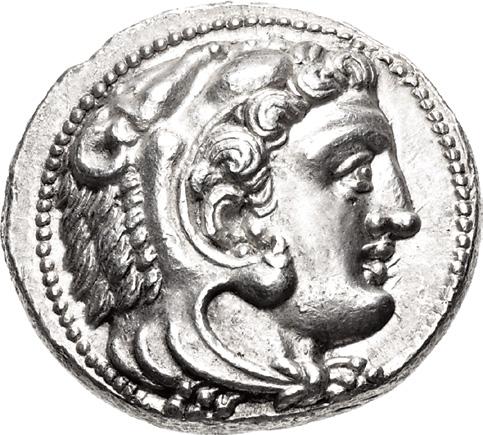
564453. KINGS of MACEDON. temp. Alexander III – Philip III. Circa 330/25-320 BC. AV Stater (18mm, 8.58 g, 12h). Uncertain mint in western Asia Minor. Struck circa 335/25-320 BC. Head of Athena right, wearing single-pendant earring, necklace, and triple-crested Corinthian helmet adorned with a serpent / ŬE$Å@droU, Nike standing left, holding wreath in extended right hand, cradling stylis in left arm; below left wing, eagle standing left. Price 3125; Troxell, New, Group III, 31 (dies 17/n); Saida 23 (same dies). Underlying luster. Choice EF. Well centered and struck. $17,775
Ex Gemini VII (9 January 2011), lot 272.
561910. KINGS of MACEDON. Philip III Arrhidaios. 323-317 BC. AV Stater (19mm, 8.60 g, 5h). In the types of Philip II. Pella mint. Struck under Antipater or Polyperchon, circa 323-318/7 BC. Head of Apollo right, wearing laurel wreath / f5¬5ππoU, charioteer, holding kentron in right hand, reins in left, driving fast biga right; kantharos below. Le Rider Group IIIA, 465 (D209/R342); SNG ANS 175 (same dies). Underlying luster, trace deposits. EF. Well centered. Wonderful portrait. $11,500
Ex Nomos 19 (17 November 2019), lot 81.
Ex Hunt Collection
563029. KINGS of MACEDON. temp. Philip III – Kassander. Circa 323/2-315 BC. AV Stater (17.5mm, 8.58 g, 1h). In the name and types of Philip II. Amphipolis mint(?). Head of Apollo right, wearing laurel wreath / f5¬5ππoU, charioteer, holding kentron in right hand, reins in left, driving fast biga right; trident head below. Le Rider Group IIIA, 204–6 var. (D92/R– [unlisted rev. die]); Hunt II 357 (this coin); Paeonian Hoard 5 (same obv. die); Weber 2042 (same obv. die). Underlying luster. EF. Well centered. $11,500
Ex Triton XXII (8 January 2019), lot 196; Numismatica Ars Classica 66 (17 October 2012), lot 33; Nelson Bunker Hunt Collection (Part II, Sotheby’s, 21 June 1990), lot 357.
566187. KINGS of MACEDON. Perseus. 179-168 BC. AR Tetradrachm (30.5mm, 15.52 g, 12h). Reduced standard. Pella or Amphipolis mint; Au-, mintmaster. Struck circa 179-178 BC. Diademed head right / ∫Å%5-¬EW% ∏Er-%EW%, eagle standing right, wings spread, on thunderbolt; x above, Q (mintmaster’s monogram) to right, h between legs; all within oak wreath, star below. Mamroth, Perseus 23. Toned, with some deep iridescence, light scratches under tone on obverse, trace deposits on reverse. Good VF. $2250
The last independent king of Macedon, Perseus inherited the throne from his father Philip V after the latter had his pro-Roman son Demetrius executed. Thus the tone was set from the outset of his reign for an eventual clash which proved fatal to the Antigonid monarchy and Macedonian independence. Perseus skillfully rebuilt the Macedonian army and undertook a network of marriage alliances during the first years of his reign, which the Romans watched with rising alarm. The Third Macedonian War broke out in 171 BC, and for a time Perseus employed guerrilla tactics which gave him the initiative and kept the Romans on their heels. Like his father, though, he chose to risk all in a single pitched battle at Pydna and lost badly to the Roman general Lucius Aemilius Paullus. Perseus surrendered and was allowed to live out his life in comfortable captivity in Rome; the Macedonian Kingdom was divided into four theoretically autonomous Republics which were soon subsumed into direct Roman rule. The coinage of Perseus is one of the more attractive of the Hellenistic series.
Very Rare Wappenmünzen Drachm – Ex Bement and Consul Weber Collections
566441. ATTICA, Athens. Circa 515-510 BC. AR Drachm (14mm, 4.05 g). “Wappenmünzen” type. Hindquarter of horse standing right / Quadripartite incuse square, divided diagonally. Seltman pl. IV, ζ–η; Svoronos, Monnaies, pl. I, 26–8; HGC 4, 1618; BMC Central Greece, p. 136, 1–3; Bement 1083 = Consul Weber 1633 (this coin); Pozzi 1510. Deeply toned, granular surfaces, scratches on reverse. VF. Very rare. $15,000
Ex Kampmann (3 May 1984), lot 23; Clarence S. Bement Collection (Naville VI, 28 January 1924), lot 1083; Consul Eduard Friedrich Weber Collection (J. Hirsch XXI, 16 November 1908), lot 1633.
Choice Group E Tetradrachm
564451. ATTICA, Athens. Circa 485/0 BC. AR Tetradrachm (21mm, 17.17 g, 8h). Head of Athena right, wearing crested Attic helmet and round earring / Owl standing right, head facing; olive sprig to left, AQE to right; all within incuse square. Seltman Group E, unlisted dies; Asyut Group VI; Svoronos, Monnaies, pl. 2, 10; HGC 4, 1591. VF. Well centered, showing full crest. Choice for issue. $19,500
Very Rare Transitional Issue
564361. ISLANDS off ATTICA, Aegina. Circa 456/45-431 BC. AR Stater (21mm, 12.36 g, 9h). Land tortoise, head in profile, with segmented shell / Large square incuse with heavy skew pattern. Meadows, Aegina, Group IIIb; Milbank pl. II, 13; HGC 6, 437 var. (head not in profile); SNG Copenhagen 517 var. (same); Dewing 1683 var. (same); Gillet 948 var. (same); Jameson 1200 var. (same); Pozzi 1635 var. (same). Attractive iridescent tone, light scratch on obverse. Good VF. Well centered on a broad flan. Very rare with head in profile. $19,500
The head of the land tortoise on this massive coinage is typically engraved shown from above, with the tortoise looking forward. Very rarely are they encountered with the head shown in profile. The profile head was canonical on the earlier, sea turtle coinage, thus the land tortoise coins of this variety may represent a short transitional issue at the beginning of this period.
564450. CORINTHIA, Corinth. Circa 350/45-285 BC. AR Stater (21.5mm, 8.54 g, 7h). Pegasos flying left; J below / Head of Athena left, wearing Corinthian helmet; to right, @ within wreath. Ravel Period V, 1069; Pegasi 386; BCD Corinth 128; HGC 4, 1848. Attractively toned with deep red iridescence, underlying luster. EF. $4250
563030. SIKYONIA, Sikyon. Circa 335-330 BC. AR Stater (24mm, 12.18 g, 3h). Chimaera standing left, raising left forepaw; wreath above, sE below / Dove flying left; 5 to left; all within wreath. BCD Peloponnesos 219; HGC 5, 201; BMC 56. Attractively toned, with some iridescence. Choice EF. Well centered and struck. A wonderful coin in hand. $15,000
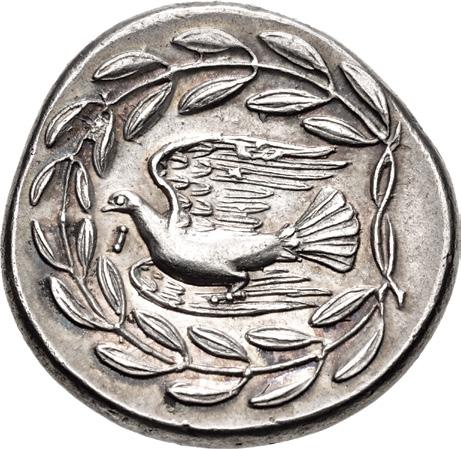

564362. KINGS of PONTOS. Mithradates VI Eupator. Circa 120-63 BC. AR Tetradrachm (33.5mm, 16.41g, 12h). Pergamon mint. Dated BE 231 (67/6 BC). Diademed head right / Stag grazing left; ∫Å%5¬EW% above, Â5QrÅdÅtoU>EU∏Åtoro% in two lines below; star-in-crescent to left, â to right, Ŭs (date) in exergue; all within Dionysiac wreath of ivy and fruit. Callataÿ p. 22, dies D77/R– (unlisted rev. die); HGC 7, 340; DCA 692; SNG BN 826 (same obv. die). Toned. EF. Fine style. Extremely rare date, one of only eight known. $15,000
Ex Jonathan P. Rosen Collection; Roma XIV (21 September 2017), lot 275; Roma VII (22 March 2014), lot 759.
536879. MYSIA, Kyzikos. Circa 550-450 BC. EL Stater (20mm, 16.01 g). Half length bust of winged female figure (Harpy?) left, touching her chin with her left hand, and holding tunny in her right / Quadripartite incuse square. Von Fritze I 75; Greenwell 98; Boston MFA 1448 = Warren 1519; SNG BN 205; Gulbenkian –; Jameson –; Myrmekion 2; Rosen 454; Weber –. Near EF. Well centered on a broad flan. $8750
563013. IONIA, Miletos. Circa 350-340 BC. AR Tetradrachm (23mm, 15.34 g, 12h). Head of Apollo right, wearing laurel wreath / Lion standing left, head right; star above, s (civic monogram) to left, ¬˙@Å5os in exergue. D-L Period I, 80 var. (V9/R– [unlisted rev. die]); Marcellesi 2; SNG von Aulock –; SNG Copenhagen –. Attractive light toning, two tiny bumps at edge on obverse, trace deposits on reverse. EF. Perfectly centered on a broad flan. Very rare magistrate. Choice for issue. $18,500
561911. IONIA, Uncertain. Circa 650-600 BC. EL Trite – Third Stater (12mm, 4.61 g). Lydo-Milesian standard. Globular surface with cluster of pellets / Two incuse squares. Weidauer –; Traité I 3; Elektron –; Rosen 253; SNG Kayhan –; SNG von Aulock 7761; Boston MFA 1749; Pozzi 2350. Toned. EF. Rare. $7500
563031. CARIA, Mylasa. Circa 500 BC. AR Stater (18mm, 11.01 g). Forepart of lion left, o on shoulder / Incuse square bisected by thick line. Konuk, Coin M1; HN Online 41; SNG von Aulock 2336; Karl 166. Patch of find patina on reverse. EF. Well centered. Quite attractive in hand. $4750
566375. ISLANDS off CARIA, Rhodos. Rhodes. Circa 250-229 BC. AR Didrachm (20mm, 6.76 g, 12h). Timotheos, magistrate. Radiate head of Helios facing slightly right / Rose with bud to right; t5ÂoQEos above, term to left, r-o flanking stem. Ashton 209; HN Online 396; HGC 6, 1439. Iridescent tone, underlying luster. Near EF. $1975

536874. ISLANDS off CARIA, Rhodos. Rhodes. Circa 229-205 BC. AR Tetradrachm (25mm, 13.56 g, 12h). Ameinias, magistrate. Radiate head of Helios facing slightly right / Rose with bud to right; rod5o@ above; to left, prow right; ÅÂE5@5Å% flanking stem. Ashton 212; HN Online 387; HGC 6, 1432. Lightly toned. EF. $4750
Ex Douglas O. Rosenberg Collection (Classical Numismatic Group 109, 12 September 2018), lot 178, purchased from Edward J. Waddell, September 1989.
563032. ISLANDS off CARIA, Rhodos. Rhodes. Circa 88/42 BC-AD 14. AR Drachm (20.5mm, 4.18 g, 6h). Attic standard. Radiate head of Helios facing slightly right / Rose seen from above; palm frond above, r-o flanking, grain ear below. Ashton & Weiss 97 (A23/P96); HN Online 419; HGC 6, 1456. Choice EF. Well centered on a broad flan. $1450
From the “Exceptional Private Collection”
563014. DYNASTS of LYCIA. Kherei. Circa 410-390 BC. AR Stater (18.5mm, 8.41 g, 1h). Telmessos mint. Head of Athena right, wearing crested Attic helmet decorated with spiral palmette and three olive leaves; X (KH in Lycian) between neck guard and crest / Bearded head of Herakles right, wearing lion skin; efr[gE] (KHER[ÊI] in Lycian) before, tf¬f∫fCECf (TELEBEHIHE in Lycian) behind; all within incuse square. Mørkholm & Zahle II 52 = SNG Copenhagen Supp. 451 (same dies); Falghera –; Reuter –; SNG von Aulock 4198 (same dies). Attractively toned, some granularity. Good VF. Fine style. $8250
Ex “Exceptional Private Collection” (Leu 76, 27 October 1999), lot 203; Münzen & Medaillen AG 53 (29 November 1977), lot 124.

564455. CYPRUS, Salamis. Nikodamos. Circa 460-450 BC. AR Stater (21mm, 11.17 g, 1h). Ram couchant right; above, oinochoe above rvs1 (pa-si-le-wo in Cypriot); F^èô† (se-ni-ko-ta-mo in Cypriot) below / Head of ram left; èò5s1 (pa-si | ni-ko in Cypriot) above, ankh-like symbol and olive branch below. Masson & Amandry p. 33, pl. II, 4–5 = Kunstfreund 169 = Gillet 1169 var. (on reverse, barley grain rather than legend above, no ankh-like symbol below); otherwise unpublished. Lightly toned. Good VF. Well centered. Apparently unique. $23,500
Ex Dr. Albert Potts Collection (Roma XVI, 26 September 2018), lot 358.
559337. SELEUKID EMPIRE. Seleukos I Nikator. 312-281 BC. AR Tetradrachm (25.5mm, 17.01 g, 7h). Seleukeia on the Tigris II mint. Struck circa 296/5-281 BC. Laureate head of Zeus right / ∫Ås5¬EWs sE¬EU˚oU, Athena, wearing chiton, brandishing spear overhead in right hand, shield on left arm, in quadriga of horned elephants right; H to right, Q in exergue. SC 130.30 var. (control mark in exergue) and 130.42 var. (monogram to right); HGC 9, 18a. Lightly toned, slightly off center, patch of find patina and cleaning marks on reverse. Good VF. Rare variety. $2250 28
Pedigreed to 1925
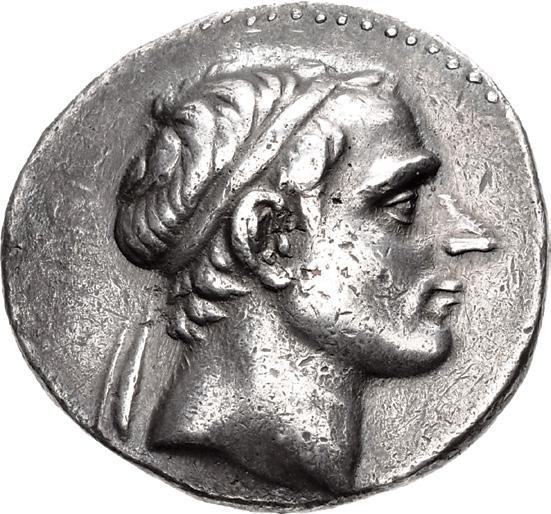
565854. SELEUKID EMPIRE. Antiochos III ‘the Great’. 222-187 BC. AR Tetradrachm (30.5mm, 16.55 g, 12h). Uncertain Mint 68, in northern Mesopotamia. Struck circa 192/0-187 BC. Diademed head right / [∫]Å%5¬EW% Å@-t5ocoU, Apollo Delphios, testing arrow in right hand, resting left hand on grounded bow, seated left on omphalos; Ås to outer left. SC 1133.4b; WSM 845α (A3/P6 – this coin, illustrated); HGC 9, 447ff. Toned, with slight blue iridescence, small area of deposit under tone on reverse. VF. Rare. $4500
Ex MNL Collection (Classical Numismatic Group 109, 12 September 2018), lot 264; Sincona 17 (21 May 2014), lot 64; Peus 282 (30 October 1973), lot 169; Glendining (9 March 1931), lot 1147; Ars Classica X (15 June 1925), lot 977.

563033. SELEUKID EMPIRE. Kleopatra Thea & Antiochos VIII. 125-121 BC. AR Tetradrachm (28mm, 16.93 g, 12h). Ptolemaïs (Ake) mint. Dated SE 189 (124/3 BC). Jugate busts right of Kleopatra Thea, wearing diadem, veil, and stephane, and Antiochos VIII, wearing diadem; all within fillet border / ∫`%5¬5%%˙% ˚2Eo∏`tr`% QE`% ˚`5 ∫`%52EW% `@t-5ocoU, Zeus Nikephoros seated left; † to outer left, Q∏r (date) in exergue. SC 2271.2; LSM 16; HGC 9, 1182d. Attractively toned, slightly off center on obverse. Good VF. $3750

560382. PHOENICIA, Tyre. 126/5 BC-AD 65/6. AR Shekel (28.5mm, 14.37 g, 1h). Dated CY 50 (77/6 BC). Laureate bust of Melkart right, lion skin around neck / Eagle standing left on prow; palm frond in background; to left, l@ (date) above club; & to right, b (B in Phoenician) between legs; tUroU 5Er&% ˚&5 &%U¬oU around. DCA-Tyre 178; HGC 10, 358; DCA 919. Lightly toned. Choice EF. Well centered on a broad flan. $6250

Ex Kenneth Brattlie Collection; Goldberg 41 (27 May 2007), lot 2761.
566191. PHOENICIA, Tyre. 126/5 BC-AD 65/6. AR Half Shekel (23mm, 7.03 g, 1h). Lifetime of Christ issue. Dated CY 159 (AD 33/4). Laureate bust of Melkart right, lion skin around neck / Eagle standing left on prow; palm frond in background; to left, r@Q (date) above club; to right, ˚r above O; Å (Phoenician A) between legs, tUroU 5Er&% ˚&5 &%U¬oU around. DCA-Tyre 878; RPC I 4693; HGC 10, 358; DCA 922. Toned, light scratches and marks. Good VF. Very rare. $7950
Ex Kölner Münzkabinett 95 (17 May 2011), lot 221.
According to the traditional chronology, this coin was struck in the year of Jesus Christ’s crucifixion.
536898. JUDAEA, Jewish War. 66-70 CE. AR Shekel (23mm, 14.17 g, 12h). Jerusalem mint. Dated year 2 (67/8 CE). Omer cup; @c (“Y[ear] 2” in Hebrew = date) above, L!Rc¥ LQc (“Shekel of Israel” in Hebrew) around / Sprig of three pomegranates; YcurQY 2¥Lcur¥ (“Jerusalem the holy” in Hebrew) around. Deutsch 8 (O1/R8); Meshorer 193; Kadman 8; Hendin 1358; Bromberg 63 (same obv. die); Shoshana I 20202; Sofaer 7–8; Spaer 167–8. Lightly toned. EF. $8250
536904. JUDAEA, Jewish War. 66-70 CE. AR Shekel (24mm, 14.17 g, 11h). Jerusalem mint. Dated year 2 (67/8 CE). Omer cup; @c (“Y[ear] 2” in Hebrew = date) above, L!Rc¥ LQc (“Shekel of Israel” in Hebrew) around / Sprig of three pomegranates; YcurQY 2¥Lcur¥ (“Jerusalem the holy” in Hebrew) around. Deutsch 89 (O6/R85); Meshorer 193; Kadman 8; Hendin 1358; Bromberg 63; Shoshana I 20202; Sofaer 7–8; Spaer 167–8. Lightly toned. EF. $9750
560625. PERSIA, Achaemenid Empire. temp. Darios I to Xerxes I. Circa 505-480 BC. AV Daric (14.5mm, 8.34 g). LydoMilesian standard. Sardes mint. Persian king or hero, wearing kidaris and kandys, quiver over shoulder, in kneeling-running stance right, drawing bow / Incuse punch. Carradice Type II (pl. XI, 11); Meadows, Administration 319; BMC Arabia –; Sunrise 19. Underlying luster. Good VF. Well centered. $9750
560738. PERSIA, Achaemenid Empire. temp. Xerxes I to Darios II. Circa 485-420 BC. AV Daric (14mm, 8.41 g). LydoMilesian standard. Sardes mint. Persian king or hero, wearing kidaris and kandys, quiver over shoulder, in kneeling-running stance right, holding spear and bow / Incuse punch. Carradice Type IIIb, Group A/B (pl. XIII, 27); Meadows, Administration 321; BMC Arabia pl. XXIV, 26; Sunrise 24. Underlying luster. Good VF. Well centered. $1950
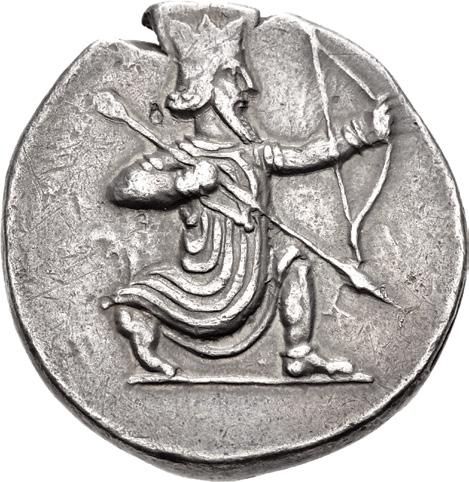
536883. PERSIA, Achaemenid Empire. temp. Artaxerxes III to Darios III. Circa 350-333 BC. AR Tetradrachm (24.5mm, 15.35 g). Chian standard. Uncertain mint in western Asia Minor (Ionia or Sardes?). Persian king, wearing kidaris and kandys, in kneeling-running stance right, holding spear in right hand, bow in left / Incuse rectangle, containing pattern possibly depicting relief map of the hinterland of Ephesos. Johnston, Earliest 6; Meadows, Administration 328; Mildenberg, Münzwesen pp. 25–6 and pl. XII, 110; BMC Ionia p. 324, 3 and 6; Jameson 1787; Pozzi 3138. Lightly toned, area of flat strike at top of obverse. Good VF. $8750

Ex Triton XIX (5 January 2016), lot 323.
Johnston has interpreted this remarkable reverse design as a relief map of the hinterland of Ephesos, which would make it the earliest Greek map and first physical relief map known. On the right (north) are the mountains Tmolos and Messogis between the river valleys of the Caÿster and Maeander, to the left of which are three mountain ridges (Madranbaba Dagi, Karincali Dagi, and Akaba Tepesi). Johnston follows Six in suggesting that the coins were probably struck under the Persian general Memnon at Ephesos, circa 336-334 BC, in order to pay his army after he had captured the city, but before his defeat by Alexander at the Battle of Granicus in 334. However, Johnston’s theory has been the subject of some doubt, most notably by Leo Mildenberg.
An Offering of Ptolemaic Coinage

564363. PTOLEMAIC KINGS of EGYPT. Ptolemy I Soter. As satrap, 323-305/4 BC. AR Tetradrachm (28mm, 17.09 g, 11h). In the name and types of Alexander III of Macedon. Memphis or Alexandreia mint. Struck circa 323-317 BC. Head of Herakles right, wearing lion skin / ŬE$Å@droU, Zeus Nikephoros seated left; rose in left field, d5-o below throne. CPE 19; Svoronos –; Zervos Issue 2C, dies 207/f; Price 3971 var. (position of letters on rev.). Attractive old collection tone over lustrous surfaces, a touch of horn silver at edge. EF. A wonderful coin in hand. $12,500
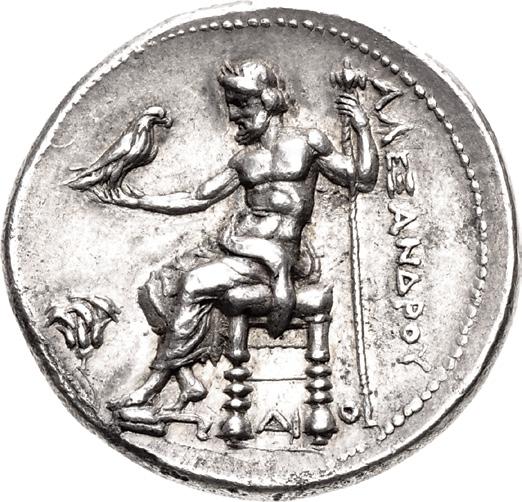
Ex Leu 79 (31 October 2000), lot 507; Münzen und Medaillen AG FPL 195 (Nov.-Dec. 1959), no. 349.
O. Zervos, in his original 1967 ANS Museum Notes article, thought these early Egyptian Alexanders were struck much earlier, but he later clarified his position in his 1974 Ph.D. dissertation, stating that he thought that they began in 324-322 BC, though most likely after Alexander III’s death. His analysis of the hoards somewhat supports his contention, but the evidence is not conclusive. M. Price, in his 1991 corpus on the Alexander coinage, thought that the minting of Alexanders began upon the conquest of Egypt in 332, but this early date is not supported by the evidence. G. Le Rider, in his 1997 review of Alexander’s coinage and finances, agreed with a late date for the beginning of Alexanders in Egypt, though slightly earlier, circa 325/4 BC. C. Lorber, in an article in NC 2005, came to a similar conclusion regarding the late start of production, agreeing with Zervos that is was more likely after Alexander’s death, circa 323 BC. Zervos, Price, and Lorber all think that the coinage began at Memphis, which had produced imitation Athenian tetradrachms under the Persians, and was later transferred to Alexandreia, while Le Rider thought it was at Alexandreia from the onset. Undoubtedly, the construction of Alexandreia was completed during the reign of Kleomenes, Ptolemy’s predecessor as satrap, and Le Rider argued that Kleomenes would have established his headquarters there, as well as his mint. Although Lorber, in CPE, attributes the initial issues to Memphis, the question remains open. All examples of this early Ptolemaic issue were struck from dies of remarkable beauty, the present specimen exemplifying this artistry and boasting a splendid state of preservation.

564482. PTOLEMAIC KINGS of EGYPT. Ptolemy I Soter. As satrap, 323-305/4 BC. AR Tetradrachm (27.5mm, 17.08 g, 11h). In the name and types of Alexander III of Macedon. Arados mint. Struck circa 320/19-315 BC. Head of Herakles right, wearing lion skin / ŬE$Å@droU, Zeus Aëtophoros seated left, legs crossed; 1 in left field. Price 3426; SNG Saroglos 592 (both attributed to Byblos mint). Iridescent tone, some roughness, flan flaws on reverse. EF. $2000
Ex Sotheby’s (10 May 1978) lot 55.
After defeating an invasion by the Macedonian regent Perdikkas in 321/0 BC, Ptolemy I Soter took the opportunity to send his armies into the Levant to secure his northern flank. Judaea, Phoenicia, and Koele Syria came under his control until 315 BC, when Antigonos I Monopthalmos ejected his forces. The major mint cities of Sidon, Tyre and Arados continued striking coins of the Alexander type during this interlude; as Ptolemy was still technically acting as satrap for the successors of Alexander, he did not attempt to place his personal stamp on the coins of these cities. Cathy Lorber notes Sidon and Tyre were striking for Ptolemy during his satrapy. While the status of Arados, one of the northernmost Phoenician cities, is less certain, numismatic evidence suggests it too was at least temporarily under Ptolemaic control at this time. The Levant would continue as a battleground between Ptolemy and Antigonos until the latter’s death in 301 BC, after which it was divided between Ptolemy and Seleukos I Nikator.
Cryptic Delta

528822. PTOLEMAIC KINGS of EGYPT. Ptolemy I Soter. 305/4-282 BC. AR Tetradrachm (27mm, 14.20 g, 12h). Alexandreia mint. Struck 294-282 BC. Diademed head right, wearing aegis around neck, tiny d behind ear / ∫Å%5¬EW% πto¬EµÅ5oU, eagle standing left on thunderbolt; to left, r above 1. CPE 158; Svoronos 248; SNG Copenhagen 68. Lovely old collection toning with iridescence around the devices, a couple of faint scratches. Near EF. Well struck. $3750
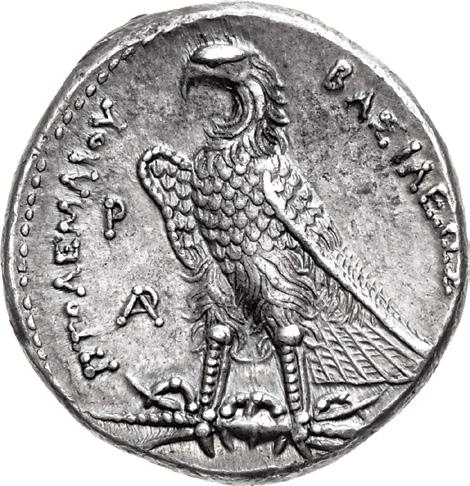
Ex Sotheby’s (7 March 1996), lot 125.
In 305/4 BC, Ptolemy I assumed the title of Basileos, or King, of Egypt and the lands under its control. A decade later, he initiated a new coinage with a diademed portrait of himself on the obverse and a Macedonian eagle, standing on a thunderbolt, on the reverse. Ptolemy thus became one of the first kings in history to place his own portrait on his coinage, a precedent still followed today. The obverse of this marvelous tetradrachm shows Ptolemy wearing the royal diadem and the aegis. In a curl of hair behind his ear is a tiny Greek letter Δ, or delta. This has been identified by Zervos and Hazard as the furtive signature of a singularly talented die engraver. However, according to Cathy Lorber in Coins of the Ptolemaic Empire (New York, 2018), the long span of time over which the delta appears, and the enormous number of dies that feature it, makes this unlikely: “It is more plausible that the letter Δ and other similar cryptic marks served some internal control function. They could, for example, designate die engraving workshops within the mint, or private contractors who provided dies to the mint, or the approval of an administrator.” (CPE vol. 1, p. 37)
524443 551412

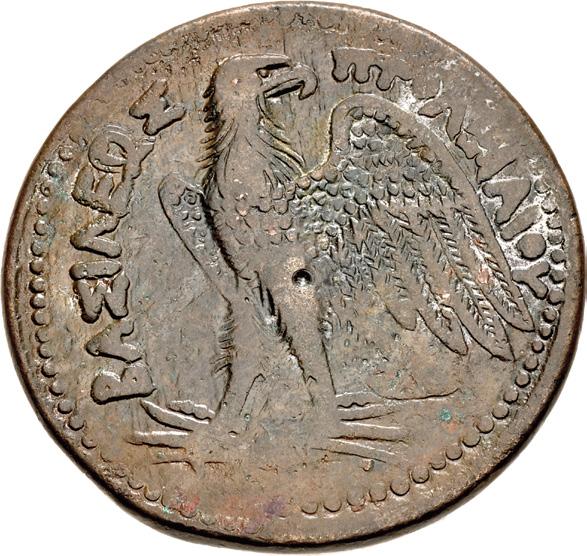
522443. PTOLEMAIC KINGS of EGYPT. Ptolemy I Soter. 305/4-282 BC. AR Tetradrachm (26.5mm, 13.65 g, 1h). Uncertain mint 10 on Cyprus (Salamis or Kition). Struck circa 294-282 BC. Diademed head right, wearing aegis around neck, tiny d behind ear / ∫Å%5¬EW% πto¬EµÅ5oU, eagle standing left on thunderbolt; to left, st above ,. CPE 235; Svoronos 368; SNG Copenhagen 87. Toned, some porosity, small die break on nose. Good VF. $795
Cyprus was one of the Ptolemaic Kingdom’s earliest and longest-lasting possessions. After becoming satrap of Egypt in 322 BC, Ptolemy I brought Cyprus and its city-states into his sphere, but was soon opposed by Antigonus I Monopthalmos and his son, Demetrios Poliorketes. The island traded hands several times during the Wars of the Diadochi until Ptolemy I finally recaptured it in 294 BC. The petty kingdoms of Salamis, Kition, Amathon, Paphos and other island cities were abolished and brought under the direct rule of a viceroy appointed by the Ptolemaic king. Two mints were established on the island, probably at Salamis and Kition, although Lorber notes that the lack of any distinctive ethnic or mintmark on the earliest coins of these mints makes it impossible to be sure. Cyprus remained under Ptolemaic rule until it was seized by the Romans in 58 BC. 551412. PTOLEMAIC KINGS of EGYPT. Ptolemy III Euergetes. 246-222 BC. Æ Octobol (47mm, 93.25 g, 11h). Alexandreia mint. Series 4B. Horned head of Zeus Ammon right, wearing taenia / ∫Å%5¬EW% πto¬EµÅ5oU, eagle with open wings standing left, head right, on thunderbolt; E between legs. CPE B365; Svoronos 446 (Ptolemy II); SNG Copenhagen 142. Light brown patina with small areas of red and hard green. VF. Among the largest and heaviest of Ptolemaic bronzes. $995
Under Ptolemy II, Egypt underwent a currency reform in the 260s BC that introduced a range of bronze denominations, all significantly larger and heavier than any struck coins issued before in the Greek world. According to Lorber, “the weights of existing bronze coinage were increased by 50%... The motive was almost certainly to inspire confidence in the new coinage by bringing its face value closer to the intrinsic value of the bronze, opening the way for the bronze coinage to play a more important role in the economy and ultimately to replace silver coinage.” Among the newly resized series was a coin about 42mm in diameter and weighing about 70 grams, which Lorber terms a drachm, and an even larger piece of about 47 mm in diameter and weighing 90 grams or more. “In terms of Greek monetary units it must have had the face value of an octobol” (eight obols, or 1.33 drachmae). Although introduced by Ptolemy II, control marks indicate most of these massive pieces were apparently struck in the reign of his successor, Ptolemy III Euergetes.

561064. PTOLEMAIC KINGS of EGYPT. Ptolemy III Euergetes. 246-222 BC. Æ Drachm (42mm, 72.62 g, 12h). Alexandreia mint. Series 5B. Horned head of Zeus Ammon right, wearing taenia / ∫Å%5¬EW% πto¬EµÅ5oU, eagle with closed wings standing left on thunderbolt; filleted cornucopia to left, ^ between legs. CPE B395; Svoronos 964; SNG Copenhagen 171–2. Brown surfaces. Good VF. An impressive large bronze. $1750
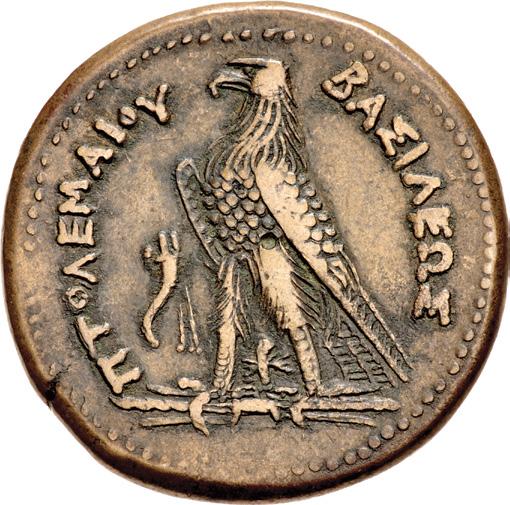
Ex Kölner Münzkabinett 63 (16 November 1995), lot 164.
566376. PTOLEMAIC KINGS of EGYPT. Ptolemy III Euergetes. 246-222 BC. Æ Triobol (34mm, 34.52 g, 11h). Alexandreia mint. Series 5B. Horned head of Zeus Ammon right, wearing taenia / ∫Å%5¬EW% πto¬EµÅ5oU, eagle with closed wings standing left on thunderbolt; filleted cornucopia to left, ^ between legs. CPE B396; Svoronos 965; SNG Copenhagen 173–5. Brown surfaces, small edge split. Good VF. $1750
Ptolemaic Control at Ainos – Extremely Rare Portrait of Ptolemy III

565950. PTOLEMAIC KINGS of EGYPT. Ptolemy III Euergetes. 246-222 BC. AR Tetradrachm (26mm, 13.96 g, 11h). Ainos mint. Time of the Third Syrian War, circa 245-241 BC. Diademed and draped bust right / ∫Å%5¬E[W%] πto¬EµÅ5oU, eagle standing left on thunderbolt; to left, crude cult figure of Hermes Perpharaios facing on double basis; monogram to right. CPE –, cf. 754A (illegible reverse monogram) and CPE 757 (portrait of Ptolemy I, similar control and monogram); cf. Svoronos 931β (as CPE 754a). Minor surface marks. Good VF. Extremely rare. $8500

This piece, a remarkable provincial tetradrachm bearing a portrait of Ptolemy III Euergetes rather than the dynastic founder, Ptolemy I Soter, apparently dates from a period of Ptolemaic control of Thrace during the Third Syrian War, 246-241 BC. While Ptolemy was launching an invasion of the Seleukid Kingdom, his allied generals also fought battles in the Aegean, where they were defeated, and Thrace, where Ptolemaic forces were successful in seizing territory formally occupied by the Seleukids and Antigonids. The exact timing of these battles remains uncertain, but a decree recorded in Ainos in 242 BC names Ptolemy III and his family, indicating Ptolemaic control of the city. The rare Ptolemaic tetradrachms of Ainos are designated by the control symbol, a crude cult figure of Hermes that also appeared on earlier coins of Lysimachos from the city. Polybios implies that Ainos remained under Ptolemaic control at least until the reign of Ptolemy IV began in 222 BC, but no coins are known from the city for reigns later than Ptolemy III’s.
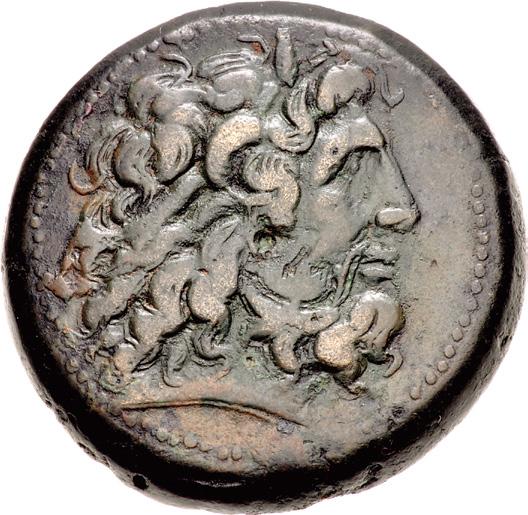
551413. PTOLEMAIC KINGS of EGYPT. Ptolemy IV Philopator. 222-205/4 BC. Æ Drachm (43mm, 70.16 g, 12h). Alexandreia mint. Series 5E, circa 219-205/4 BC. Horned head of Zeus Ammon right, wearing taenia / ∫Å%5¬EW% πto¬EµÅ5oU, eagle with closed wings standing left on thunderbolt; filleted cornucopia to left, %E between legs. CPE B502; Svoronos 992; SNG Copenhagen 205-6. Dark brown patina with areas of green. VF. $700

Rare Ptolemy IV Portrait
531644. PTOLEMAIC KINGS of EGYPT. Ptolemy IV Philopator. 222-205/4 BC. AR Tetradrachm (25mm, 14.14 g, 12h). Posthumous issue under Ptolemy V. Uncertain military mint in Phoenicia. Struck circa 202-200 BC. Diademed and draped bust right / ∫Å%5¬EW% [∏t]o¬EÂÅ5oU, eagle standing right on [thunderbolt]; Q to left, @5 between legs. Svoronos –; Mørkholm, Portrait, Group IX, – (A13/R– [obverse die unlisted with this issue, reverse die unlisted]); BMC –; SNG Copenhagen –; CNG 38, lot 568 (same dies). Toned, slightly off center. Near EF. Very rare. $22,500

Ex Weise Collection; Triton VIII (11 January 2005), lot 589; Robert Schonwalter Collection (Triton V, 16 January 2002), lot 1541.

553986. PTOLEMAIC KINGS of EGYPT. Ptolemy V Epiphanes. 204-180 BC. AR Tetradrachm (26mm, 14.14 g, 12h). Alexandreia mint. Diademed head of Ptolemy I right, aegis around neck / ∫Å%5¬EW% πto¬EµÅ5oU, eagle standing left on thunderbolt; no control marks. Olivier 3640–2 (obv. die D45); Svoronos 1231; SNG Copenhagen 244–5. Satiny surfaces with residual luster in fields, hairline flan crack, some light scratches, tiny pit on obverse. EF. Excellent details. $2950
Ascending the throne at the age of 5 in 204 BC, Ptolemy V Epiphanes faced a kingdom in crisis: A native Egyptian uprising under a rebel Pharaoh controlled much of Upper Egypt, the government of Alexandreia was paralyzed by infighting between rival courtiers, and the Seleukid and Macedonian kingdoms launched invasions of Egypt’s outlying provinces. The young king’s government was at first in the hands of his prime minister, the widely reviled Agathokles, who was toppled in 202 BC. The viziers who followed him proved incompetent and the Ptolemaic regime seemed near dissolution. After Ptolemy V came of age in 196 BC, an event marked by the creation of the Rosetta Stone, he took a more active role in government and conditions within the kingdom began to stabilize. He cut a deal with the Egyptian priestly caste that enabled him to defeat the rebels and regain control of upper Egypt. Marriage to the Seleukid princess Kleopatra I brought peace with Antiochos III. However, as he approached his 30th birthday Ptolemy began preparing for a renewed war with Syria, and a cabal of courtiers worried that their wealth would be seized to fund it procured his poisoning. His 6-year-old son Ptolemy VI inherited a shaky throne under virtually the same circumstances his father had faced.
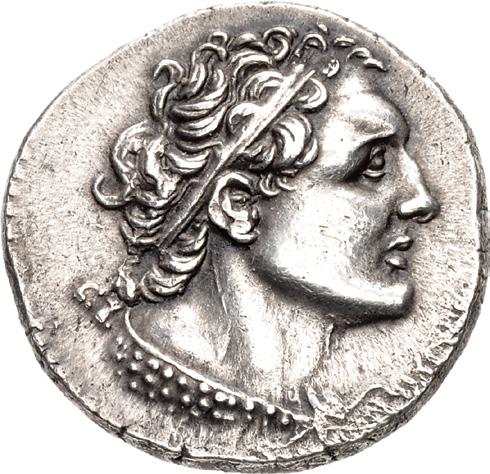
563016. PTOLEMAIC KINGS of EGYPT. Ptolemy VI Philometor. First sole reign, 180-170 BC. AR Tetradrachm (27mm, 14.24 g, 12h). Kition mint. Dated RY 7 (175/4 BC). Diademed head of Ptolemy I right, aegis around neck / ∫Å%5¬EW% πto¬EµÅ5oU, eagle standing left on thunderbolt; lz (date) to left, ˚5 to right. Olivier 1097–1115 (D209/R638); Svoronos 1355; SNG Copenhagen –; DCA 42 (same dies as illustration). Attractively toned, minor die wear on reverse (diagnostic for die). Near EF. $3950
Ptolemy VI Philometor (”mother-loving”) inherited the throne at the age of six under a darkening cloud, after his father’s apparent murder by a palace clique. Although his reign would witness wild swings in fortune, he proved one of the more energetic and successful Ptolemaic rulers and the last truly capable man to hold the title of Pharaoh. Although badly defeated by the Seleukid King Antiochos IV Epiphanes during the Sixth Syrian War of 170-168 BC, Roman intervention saved his kingdom and preserved his throne. Exiled in 164 BC after a coup led by his scheming brother, Ptolemy VIII Physcon (”potbelly”), he sought refuge in Rome and eventually managed a triumphant return to power in 163 BC. His second reign was much more successful than the first. Egypt entered a period of stability and prosperity that saw the Roman orator Cato the Elder praise Ptolemy VI as a just and beneficent ruler. Through skillful manipulation of dynastic politics, he stirred up chaos in the Seleukid Empire and occupied a large swath of their territory, winning complete revenge for his humiliation of two decades previous. At the height of his success in 145 BC, he suffered an apparently minor fall from his horse, but rapidly worsened and died three days later. Not until Kleopatra VII would the Ptolemaic realm again be as powerful and influential in world affairs.
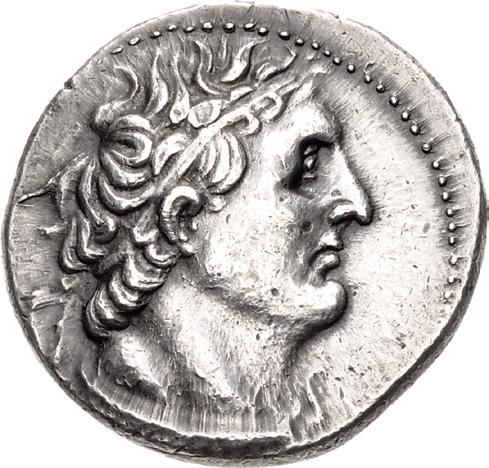
563015. PTOLEMAIC KINGS of EGYPT. Ptolemy VI Philometor. First sole reign, 180-170 BC. AR Tetradrachm (26.5mm, 14.43 g, 12h). Uncertain mint in Cyprus. Dated year 84 of an uncertain era (179/8 BC). Diademed head of Ptolemy I right, aegis around neck / ∫Å%5¬EW% [πto]¬EµÅ5oU, eagle standing left on thunderbolt; ∏d (date) to left. Olivier 127–133 (D16/R57); Mørkholm, Ptolemaic 112–8 (A23/P82); Svoronos 1106; SNG Copenhagen 545 (same obv. die); DCA 73; McClean 9798 (same dies). Attractive light iridescent toning, minor marks. Near EF. Struck from dies of bold style, with a wonderful portrait and eagle. $1500
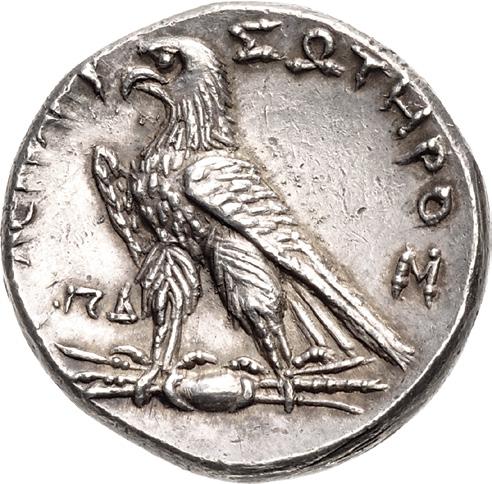
Although struck late in the Ptolemaic period, the exceptional portrait of Ptolemy I on this coin proves die engravers of superior talent continued to produce coins at the empire’s provincial mints, in this case Cyprus. The portrait is a close match for quality to the earliest issues of Ptolemy I Soter, which are rightly hailed as exemplars of Hellenistic portraiture. Another distinctive feature is the use of the epithet Soter (ΣΩΤΗΡΟΣ) in the reverse legend, marking it as a tribute to the dynastic founder.
566377. PTOLEMAIC KINGS of EGYPT. Ptolemy VI Philometor. First sole reign, 180-170 BC. AR Tetradrachm (27.5mm, 13.36 g, 12h). Uncertain mint in Cyprus. Dated year 90 of an uncertain era (173/2 BC). Diademed head of Ptolemy I right, aegis around neck / ∫Å%5¬EW% πto¬EµÅ5oU, eagle standing left on thunderbolt; r (date) to left. Olivier 205 (D38/ R102) = Mørkholm, Ptolemaic 166 (A42/P121) = SNG Lockett 3414 (same dies); Svoronos 1112 and 1205; SNG Copenhagen 547; DCA 73. Toned, some roughness. Good VF. $1750
533809. PTOLEMAIC KINGS of EGYPT. Ptolemy VI Philometor. First sole reign, 180-170 BC. Æ (21mm, 6.96 g, 12h). Quasi-municipal issue. Marathos mint. Dated CY 86 (174/3 BC). Laureate and draped bust of Hermes, with Ptolemaic features, right, kerykeion over shoulder / Marathos standing slightly left, holding aphlaston; zzzzzzÓÓÓÓ (date [in Phoenician]) to left, †eM (mrt [Amrit = Marathos] in Phoenician) to right, M (m in Phoenician) to inner left and lower right. Duyrat, Ateliers 246 (D24/R29); HGC 10, 194; DCA 832. Green-brown patina, smoothed. EF. $350
Ex Jack A. Frazer Collection; Classical Numismatic Review XVIII.2 (2nd Qtr. 1993), no. 135.
Ptolemy VI was the last Ptolemaic monarch to successfully ay claim to Phoenicia, a region that repeatedly changed hands between the Ptolemaic and Seleukid dynasties over 200 years of intermittent warfare. A dashing figure who led his armies in person, Ptolemy VI is not represented by portrait on any properly Egyptian coins, but may have been depicted on coins of the Phoenician cities he conquered. Though some modern commentators now disagree with the earlier identification of the portrait here as Ptolemy VI, it certainly has Ptolemaic features comparable to the portraits of Ptolemy I found on contemporary tetradrachms struck at Alexandreia. The idea that it is Ptolemy as Hermes is strengthened by fact that there are contemporary bronzes at Marathos that depict a veiled female bust that must have been modeled on the ubiquitous silver and gold issues of Alexandreia depicting either Arsinoe or Berenike.

563118. PTOLEMAIC KINGS of EGYPT. Ptolemy VI Philometor. Second sole reign, 163-145 BC. AR Tetradrachm (26.5mm, 14.21 g, 12h). Alexandreia mint. Diademed head of Ptolemy I right, aegis around neck / ∫Å%5¬EW% πto¬EµÅ5oU, eagle standing left on thunderbolt; no control marks. Olivier 3965–8 (obv. die D71); Svoronos 1489; SNG Copenhagen 262–8. Old collection tone, patches of find patina. Near EF. With a sculptural portrait and a beautifully detailed reverse. $3750
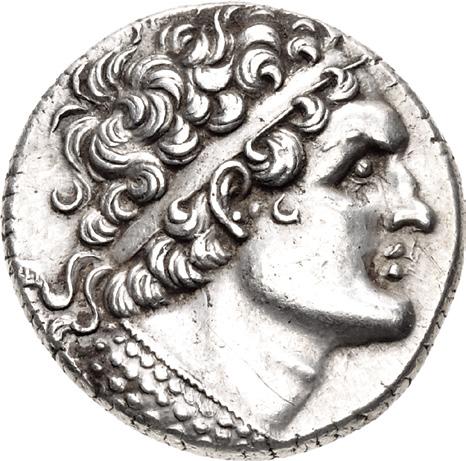
563017. PTOLEMAIC KINGS of EGYPT. Ptolemy VI Philometor. Second sole reign, 163-145 BC. AR Tetradrachm (25.5mm, 14.26 g, 12h). Paphos mint. Dated RY 29 (153/2 BC). Diademed head of Ptolemy I right, aegis around neck / ∫Å%5¬EW% πto¬EµÅ5oU, eagle standing left on thunderbolt; l˚Q (date) to left, ∏Å to right. Olivier 2097–8 (D352/R1181); Svoronos 1441; SNG Copenhagen –; DCA 46. Lightly toned, deposits. EF. High relief portrait of great style. $3250
561000. PTOLEMAIC KINGS of EGYPT. Ptolemy VI Philometor. Second sole reign, 163-145 BC. AR Didrachm (22mm, 6.99 g, 1h). Uncertain mint in Cyprus. Dated year 109 of an uncertain era (154/3 BC). Diademed head of Ptolemy I right, aegis around neck / ∫Å%5¬EW% πto¬EµÅ5oU, eagle standing left on thunderbolt; r Q (date) across field. Olivier 3129–50 (obv. die D26); Mørkholm, Ptolemaic 246–57 (obv. die a20); Svoronos 1216; SNG Copenhagen 556; DCA 76. Pleasant medium toning, with a few light surface marks beneath. Good VF. $475
564483. PTOLEMAIC KINGS of EGYPT. Ptolemy VIII Euergetes II (Physcon). 145-116 BC. AR Tetradrachm (27mm, 14.14 g, 12h). Alexandreia mint. Dated RY 27 (144/3 BC). Diademed head of Ptolemy I right, aegis around neck / ∫Å%5¬EW% πto¬EµÅ5oU, eagle standing left on thunderbolt; l˚z (date) to left, ∏Å to right. Olivier 4469–70 (obv. die D43); Svoronos 1502; SNG Copenhagen 325 (same obv. die); DCA 54. Light marks, flan crack, die wear on obverse. Good VF. $950

520552. PTOLEMAIC KINGS of EGYPT. Ptolemy VIII Euergetes II (Physcon). 145-116 BC. AR Tetradrachm (26.5mm, 14.02 g, 12h). Alexandreia mint. Dated RY 31 (140/39 BC). Diademed head of Ptolemy I right, aegis around neck / ∫Å%5¬EW% πto¬EµÅ5oU, eagle standing left on thunderbolt; l¬Å (date) to left, ∏Å to right. Olivier 4482–5 (obv. die D50); Svoronos 1504; SNG Copenhagen –; DCA 54. Beautiful iridescent toning, a few scratches on reverse. Near EF. Perfectly centered and with an attractive portrait. $4000

528342. PTOLEMAIC KINGS of EGYPT. Ptolemy VIII Euergetes II (Physcon). 145-116 BC. AR Tetradrachm (26mm, 14.24 g, 12h). Alexandreia mint. Dated RY 38 (133/2 BC). Diademed head of Ptolemy I right, aegis around neck / ∫Å%5¬EW% [∏to¬]EµÅ5oU, eagle standing left on thunderbolt; l¬˙ (date) to left, ∏Å to right. Olivier 4516–9 (obv. die D66); Svoronos 1512; SNG Copenhagen 329 (same obv. die); DCA 54. A few light marks under medium cabinet tone. Good VF. A surprisingly rare variety, with only nine noted by Olivier, and three in CoinArchives. $750
564484. PTOLEMAIC KINGS of EGYPT. Ptolemy VIII Euergetes II (Physcon). 145-116 BC. AR Tetradrachm (26.5mm, 13.66 g, 12h). Alexandreia mint. Dated RY 39 (132/1 BC). Diademed head of Ptolemy I right, aegis around neck / ∫Å%5¬EW% ∏to¬EµÅ5oU, eagle standing left on thunderbolt; l¬Q (date) to left, ∏Å to right. Olivier 4522–33 (obv. die D69); Svoronos 1513; SNG Copenhagen –; DCA 54. Light iridescent tone, some redeposited silver. Near EF. $975
Pedigreed to 1930

553988. PTOLEMAIC KINGS of EGYPT. Ptolemy VIII Euergetes II (Physcon). 145-116 BC. AR Tetradrachm (27mm, 14.26 g, 12h). Paphos mint. Dated RY 27 (144/3 BC). Diademed head of Ptolemy I right, aegis around neck / ∫Å%5¬EW% πto¬EµÅ5oU, eagle standing left on thunderbolt; l˚z (date) to left, ∏Å to right. Olivier 2091 (D351/R1176 – this coin); Svoronos 1439; SNG Copenhagen 296; DCA 54. Beautifully toned, minor flan crack, light graffiti in fields on obverse. EF. $1950
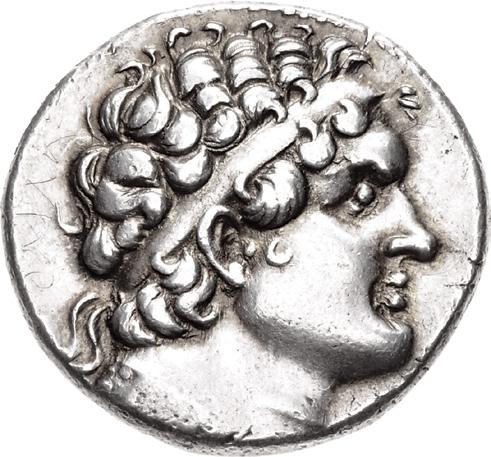
Ex Dr. Walter Stoecklin (†1975) Collection (Nomos 14, 17 May 2017), lot 190; Ars Classica XV (2 July 1930), lot 1180.
This type is also attributed to Ptolemy VI Philometor and the mint of Alexandria. The regnal dating is muddled by the profusion of overlapping reigns during this period, with Ptolemies VI and VIII, along with their mother Kleopatra I and sister Kleopatra II, at various times ruling singly, jointly, in opposition to each other, and cooperatively. Ptolemy VI began his reign at the age of six in September 180 BC, with his mother as co-ruler and regent. If figured from that point, this coin, dated regnal year 27, would have been struck in 155/4 BC. However, Ptolemy VIII joined them in October of 170 BC, which was declared the first year of a new era. If dated from then, this piece would have been struck in 144/3 BC, after Ptolemy VI’s death in battle. On balance the evidence seems to favor the attribution to Ptolemy VIII and Paphos, but further research and/or discoveries could overturn this verdict.
564485 562387 564485. PTOLEMAIC KINGS of EGYPT. Kleopatra III & Ptolemy IX Soter II (Lathyros). 117/6-108/7 BC. AR Tetradrachm (26mm, 13.31 g, 12h). Alexandreia mint. Dated RY 2 (116/5 BC). Diademed head of Ptolemy I right, aegis around neck / ∫Å%5¬EW% ∏to¬EµÅ5oU, eagle standing left on thunderbolt; l∫ (date) to left, ∏Å to right. Olivier 4808–915 (unlisted obv. die); Svoronos 1660; SNG Copenhagen 348; DCA 60. Iridescent tone, redeposited silver on obverse. Near EF. $975
562387. PTOLEMAIC KINGS of EGYPT. Kleopatra III & Ptolemy IX Soter II (Lathyros). 116-107 BC. AR Tetradrachm (24.5mm, 14.19 g, 12h). Alexandreia mint. Dated RY 8 (110/09 BC). Diademed head of Ptolemy I right, aegis around neck / ∫Å%5[¬EW]% ∏to¬EµÅ5oU, eagle standing left on thunderbolt; l˙ (date) to left, ∏Å to right. Olivier 5484–574 (unlisted obv. die); Svoronos 1669; SNG Copenhagen 352; DCA 60. Attractively toned. Good VF. $775
Ex El Medina Collection; Classical Numismatic Group XXXIII (15 March 1995), lot 516 (part of).
566193 562388 566193. PTOLEMAIC KINGS of EGYPT. Kleopatra III & Ptolemy X Alexander I. 107-101 BC. AR Tetradrachm (24mm, 13.98 g, 12h). Alexandreia mint. Dually dated RY 11 of Kleopatra and RY 8 of Ptolemy (107/6 BC). Diademed head of Ptolemy I right, aegis around neck / ∫Å%5¬EW% ∏to¬EµÅ5oU, eagle standing left on thunderbolt; to left, l5Å above ˙ (dates); ∏Å to right. Olivier 5799–822 (unlisted obv. die); Svoronos 1727; SNG Copenhagen 358; DCA 61. Toned, with some iridescence, minor flan flaws. Good VF. $795 562388. PTOLEMAIC KINGS of EGYPT. Ptolemy X Alexander I. Sole reign, 101-88 BC. AR Tetradrachm (24mm, 13.69 g, 12h). Alexandreia mint. Dated RY 14 (101/0 BC). Diademed head of Ptolemy I right, aegis around neck / ∫Å%5¬EW% ∏to¬EµÅ5oU, eagle standing left on thunderbolt; l5d (date) to left, ∏Å to right. Olivier 6072–6 (obv. die D517); Svoronos 1674; SNG Copenhagen 363; DCA 68. Lightly toned, some die wear and a couple small marks on obverse. VF. $695
Ex El Medina Collection; Classical Numismatic Group 37 (20 March 1996), lot 877.
562389. PTOLEMAIC KINGS of EGYPT. Ptolemy X Alexander I. AR Tetradrachm (24mm, 13.47 g, 12h). Alexandreia mint. Dated RY 19 (96/5 BC). Diademed head of Ptolemy I right, aegis around neck / ∫Å%5¬EW% ∏to¬EµÅ5oU, eagle standing left on thunderbolt; l5Q (date) to left, ∏Å to right. Olivier 6245–88 (unlisted obv. die); Svoronos 1679; SNG Copenhagen 368; DCA 68. Lightly toned, trace deposits and a couple light marks. VF. $525
Ex El Medina Collection; Classical Numismatic Group 37 (20 March 1996), lot 880.
562390. PTOLEMAIC KINGS of EGYPT. Ptolemy XII Neos Dionysos (Auletes). 80-51 BC. AR Tetradrachm (24.5mm, 12.58 g, 12h). Alexandreia mint. Dated RY 27 (55/4 BC). Diademed head of Ptolemy I right, aegis around neck / ∫Å%[5¬EW%] ∏to¬EµÅ5oU, eagle standing left on thunderbolt; to left, l˚z (date) above headdress of Isis; ∏Å to right. Svoronos 1836; SNG Copenhagen 394; DCA 69. Toned, a few small flan flaws. Good VF. Attractive for issue. $925
Ex El Medina Collection; Classical Numismatic Group XXXIII (15 March 1995), lot 522.
Ptolemy XII Neos Dionysos, known by his derisive nickname Auletes (“the flautist”), was a weak and self-indulgent ruler, but who possessed a peculiar genius for self-preservation that kept him in power for 25 tumultuous years. His nickname derives from his love of playing the flute at religious festivals and musical contests, which was described by the historian Strabo. An illegitimate son of Ptolemy IX Soter, he was already 37 when he attained the Egyptian throne in 80 BC. He maintained a steadfastly pro-Roman policy, paying out huge bribes, borrowing heavily from Roman grandees, and taxing his subjects abusively to cover these loans. This prompted a revolution in 58 BC, in which his daughter Berenike IV replaced him. Auletes took refuge in Rome along with his younger daughter, Cleopatra VII, and soon borrowed and bribed enough to secure Roman backing for a return to power in 55 BC. This silver tetradrachm is dated to this brief second reign, which was long enough to secure the succession of Cleopatra and her younger brother, Ptolemy XIII. As with most of the later Ptolemaic rulers, the female line proved much more capable and resolute than the male side of the dynasty.
CELTIC
558607. GAUL, Northwest. Aulerci Eburovices. Late 3rd-early 2nd century BC. AV Hemistater (18mm, 3.32 g, 9h). Celticized head of Apollo left, dotted bands with central zig-zag line on cheek; spiral ornaments below / Celticized biga right, with devoloved charioteer above; large X-like ornament to right; below, wolf with large mouth right. Scheers, Eburovices, Series Ic, Class III, 13–6; Depeyrot, NC V, 137; D&T 2395; de la Tour 7019. Good VF. Very rare, one of only 18 examples listed by Depeyrot, with nearly half in museum collections. $1350
Ex Jonathan P. Rosen Collection; Gorny & Mosch 240 (10 October 2016), lot 3.
ORIENTAL GREEK
559023. BAKTRIA, Greco-Baktrian Kingdom. Demetrios I Aniketos. Circa 200-185 BC. AR Tetradrachm (36mm, 17.01 g, 12h). Diademed and draped bust right, wearing elephant skin / ∫Å%5¬EW% to right, d˙;˙tr5oU to left, Herakles standing facing, crowning himself, holding club and lion skin; D to inner left. Bopearachchi 1F; cf. Bopearachchi & Rahman 124 (illustrated example is fourrée); SNG ANS 190; MIG Type 103c; HGC 12, 63. Lightly toned, trace deposits, scratch and minor double strike on obverse. Good VF. $7500
Ex Weise Collection, purchased from Sidney Mygind, 4 December 1999.
564456. BAKTRIA, Greco-Baktrian Kingdom. Eukratides I Megas. Circa 170-145 BC. AR Tetradrachm (32mm, 17.00 g, 12h). Helmeted, diademed, draped, and cuirassed bust right / ∫å%5GE∑% ÂE˝ÅGoU around, EUkrÅt5doU in exergue, The Dioskouroi, holding palm fronds and spears, on horses rearing right; D in lower right field. Bopearachchi 6O; Bopearachchi & Rahman –; SNG ANS 467; MIG Type 177a; HGC 12, 131. Lightly toned, traces of underlying luster, slight doubling. EF. $4000

559024. BAKTRIA, Greco-Baktrian Kingdom. Eukratides I Megas. Circa 170-145 BC. AR Tetradrachm (35mm, 16.98 g, 12h). Helmeted, diademed, draped, and cuirassed bust right / ∫å%5GE∑% ÂE˝ÅGoU around, EUkrÅt5doU in exergue, the Dioskouroi, holding palm fronds and spears, on horses rearing right; é in lower right field. Bopearachchi 6W; Bopearachchi & Rahman 247; SNG ANS 469-471; MIG Type 177f; HGC 12, 131. Lightly toned, traces of underlying luster, minor porosity. EF. $2750
CENTRAL ASIAN
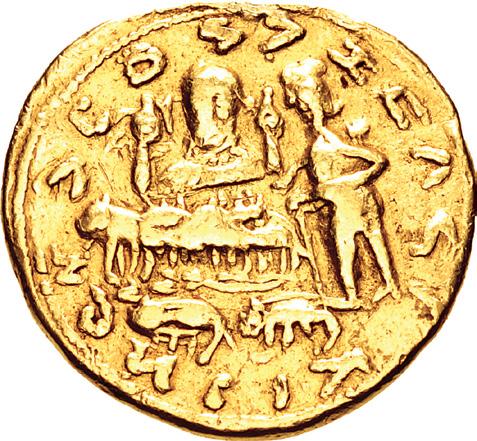
565853. LOCAL ISSUES, Uncertain. Circa 1st century BC or slightly later. AV Medal (26mm, 13.46 g, 12h). Zeus Nikephoros seated slightly left; pseudo-legend and monograms around / Male driving oxen left; below, additional pair of oxen left; above, facing half-length bust with arms raised in benedictional gesture, or holding uncertain objects (possibly grain ears); pseudo-legend around. Unpublished in the standard references. Evidence of prior mounting. VF. $6750
Ex Gorny & Mosch 121 (10 March 2003), lot 284.
This medal raises a number of challenges toward a more specific attribution. The weight of of 13.46 may represent an unkown local weight approaching a Baktrian double stater or Kushan double dinar (each of which would be 16.00g theoretical full weight). Based on the obverse figure of enthroned Zeus, it appears to have derived its model from the coinage of the later Indo-Greeks (for a comparison, see the posthumous coinage of Hermaios struck by the Indo-Skythians). Unlike that coinage, however, the figure here is holding an eagle in his right hand, which is reminiscent of the Tarsan issues of Mazaios (361/0-334 BC), or the plentiful coinage of Alexander III of Macedon. It is possible that these Greek issues continued to circulate alongside contemporary Indo-Greek coins in Central Asia long after they were struck, thereby forming the basis for such a hybrid obverse. The reverse is more of a mystery, with no known issue providing the exact model of the design. While the man driving oxen is reminiscent of pomerium issues for the founding of provincial cities in the Greco-Roman world, there is nothing like it known on the coinage of Central Asia. Furthermore, the enigmatic bust above, raising both hands in a benedictional gesture, or holding uncertain objects (possibly grain ears), suggests a local version of a grain/agricultural deity. A truly enigmatic piece.
ROMAN PROVINCIAL
Rites Of A Hasty Peace

563034. MYSIA, Pergamum. Commodus. AD 177-192. Æ Medallion (44mm, 50.85 g, 6h). M. Ai(lios) Glykonianos, strategos. Struck circa AD 180-182. ΑYΤΟ ΚΑΙ Μ ΑYΡΗ ΚΟΜΟΔΟC, laureate, draped, and cuirassed bust right / ΕΠ[Ι CΤ]Ρ Μ [Α]Ι Γ ΛV ΚΩΝΙΑΝΟY, ΠΕΡΓΑΜΗΝΩΝ/Β ΝΕΟΚΟΡΩΝ in two lines in exergue, Commodus, in military outfit, standing right on stepped podium, holding spear and erecting trophy before bound captive seated left; in foreground, victimarius standing right about to sacrifice bull left chained to podium. RPC IV.2 Online 3255; von Fritze, Pergamon, pp. 72-3 and pl. VII, 16 (only rev. illustrated – same die); SNG BN 2166 (same dies); SNG Leypold 423; SNG von Aulock –. Green patina, slight double strike on reverse, light smoothing. VF. Extremely rare, RPC cites nine examples, six of which are in public collections. $7500

This unusual reverse type celebrates sacrifices to mark a great Roman victory, indicated by the presence of a trophy and bound captive. With a likely date of issue circa AD 181-182, shortly after the start of Commodus’s sole reign, this type surely marks the conclusion of peace with the Germanic tribes ending of the Marcomannic Wars fought by his father and predecessor, Marcus Aurelius. Interesting details include the chain securing the sacrificial bull and the ax-wielding victimarius about to perform the sacrifice, who in this instance appears to be female. In fact the peace was hastily patched up by Commodus, who was anxious to return to Rome, and the Germanic wars would renew with greater intensity in the following century.
Triple Temple Reverse

563035. MYSIA, Pergamum. Caracalla. AD 198-217. Æ Medallion (43mm, 39.81 g, 6h). M. Kairel(ios) Attalos, strategos. Struck AD 214. AYTKPAT K MAPKOC AYΡ ANTΩNЄINOC, laureate and cuirassed bust right; gorgoneion on breastplate / ЄΠI CTP M KAIPЄΛ/ATT AΛO/V above, ΠЄ/PΓA/MHN/ΩN in three lines in central field, ΠPΩTΩN Γ NЄ/ΩKOPΩN in two lines in exergue, three tetrastyle temples; two seen in perspective facing left and right; upper one, containing statue of Zeus Aetophorus seated left, seen from front; AN in pediment; clippeus in pediments of left and right temples. Von Fritze, Pergamon, p. 85 and pl. VIII, 16 (only rev. illustrated – same die); SNG BN 2229 var. (legend breaks); SNG Leypold –; SNG von Aulock 1411-2 var. (same); BMC 37 and pl. XXXII, 1 (same dies). Red-brown and black-green patina, some light smoothing, two small scrapes on reverse. VF. Very rare. $7500

Caracalla’s eastern tour of AD 214 included stops at several healing shrines, where he sought a cure for a chronic malady of an unknown nature, which his ancient biographers attributed to either hypochondria or guilt and anxiety over his murder of his brother, Geta. This impressive medallion of Pergamum commemorates one such visit to the famous temple of Asklepios in that city, extant since the second century BC. The reverse depicts three temples; the two flanking structures, shown in perspective, have been identified as temples for the deified emperors Augustus and Trajan. The raised central temple, with a figure of Asklepios shown within, is inscribed AN on the pediment, surely for Antonininus, Caracalla’s official name. The meaning of this is unclear, but it suggests the venerable temple of Asklepios has also been made into a shrine to the emperor’s own divinity.

563037. MYSIA, Pergamum. Geta. AD 209-211. Æ Medallion (45mm, 49.26 g, 6h). Menogenes the Younger, strategos for the second time. Struck AD 211. · AVTOKPA · KAI · ΠΟΠΛΙOC · CЄΠTI · ΓЄTAC ·, laureate and cuirassed bust right, wearing slight beard; gorgoneion on breastplate / ЄΠI CTP · MHNO ΓЄNOVC B NЄOV · ΠЄPΓAMH/N Ω N, · B · NЄOKOPΩN in two lines in exergue, Geta right on horseback, preparing to spear prone and supplicating captive below horse; oval shield to left below horse. Von Fritze, Pergamon –; SNG BN 2217 corr. (attributed to Caracalla – same dies); SNG Leypold –; SNG von Aulock –. Green patina, slight doubling, minor smoothing. Good VF. Very rare. $6750

Ex Leu Numismatik 1 (25 October 2017), lot 117.
Though sometimes described as a Parthian, the cringing, nude enemy below the hooves of Geta’s horse is more likely intended to represent a Caledonian warrior from the recent Severan campaigns in Britannia. Geta was acclaimed as Augustus while resident in Britain, and this is the only military campaign in which he took an active role.
Olympics At Pergamum
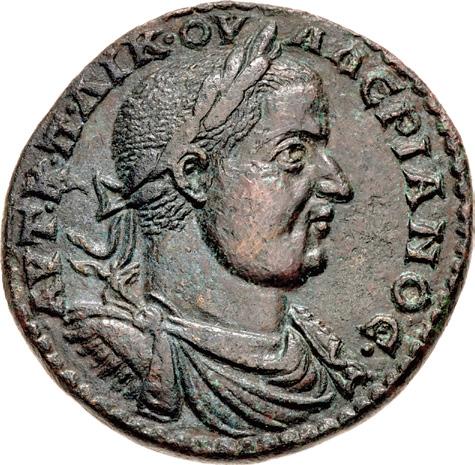
563038. MYSIA, Pergamum. Valerian I. AD 253-260. Æ Medallion (40mm, 27.79 g, 6h). Olympic Games issue. Aur(elios) Damas, Asiarch. Struck AD 253 or 257. AYT · K · Π · ΛIK · OY AΛЄPIANOC ·, laureate, draped, and cuirassed bust right / ЄΠI C AYP · ΔAMA ·/A ΠЄPΓA(MH)NΩN, · ΠΡΩTΩN · Γ ·/ NЄΩKOPΩ/N, wreath with OΛ/YMΠ/IΛ in three lines, flanked by two prize crowns, each containing a palm frond; all set on prize table; below, urn, flanked on either side by a purse and whip. Von Fritze, Pergamon, p. 81 and cf. pl. IX, 4; cf. SNG BN 2293 (same dies); SNG Leypold –; SNG von Aulock 7518 (same dies). Red-brown and green patina, some minor smoothing. Good VF. Very rare and exceptional for issue. $9500

By the mid second century BC, Pergamum had become the the most important center of sport and physical education in the Hellenistic east. Its Nikephoria games, held every three years, had nearly the prestige and appeal of great Panhellenic games, including the Olympics, upon which they were modeled. By the second century AD, the Olympic name had even been “franchised,” in a manner still poorly understood, for use at sporting contests far removed from the original quadrennial festival still held at the ancestral home of Elis, Olympia. The contests at Pergamum now honored the Roman emperors and bore the name Olympic, as attested by the reverse of this remarkable medallion, which shows the prizes awarded to the victors in the various athletic, equestrian and artistic contests, all arrayed on and around a table. The laurel wreath enclosing the name “Olympia” was likely for the winner of the premier event of the games, possibly the “stadion” foot race.
Magnificent Medallion

563039. LYDIA, Sardis. Septimius Severus. AD 193-211. Æ Medallion (40mm, 35.16 g, 12h). G(aios) I(oulios) Krispos, archon. AD 193-195. · AYT · KAIC · Λ · CЄΠ TIMI · CЄOYHPOC · Π ЄPTINAZ, laureate, draped, and cuirassed bust right / ЄΠI · Γ · I · KPICΠOY · APX/CAPΔIANΩN · ΔIC/NЄΩKOPΩN in three lines in exergue, two pentastyle temples seen in perspective facing left and right; clippeus in pediments; wreath above each. LS –; Kurth 467 (same dies); SNG Leypold –; SNG von Aulock 3155 (same dies). Dark green and brown patina, light smoothing in fields. Good VF. An impressive medallion. $35,000
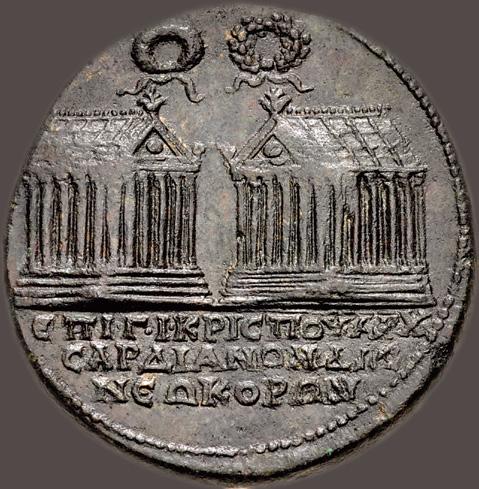
Ex Dr. P. Vogl Collection; Aufhäuser 10 (5 October 1993), lot 452 and front cover.
Sardis is one of the oldest cities in Asia Minor and was capital of the Lydian Kingdom in the 7th century BC. It remained an important metropolis into Roman times, where it was the seat of the Roman proconsul of Asia. From earliest times it was also a mint city, employing highly skilled engravers. This magnificent medallion, struck circa AD 193-195, is testament to their skill, commemorating an imperial visit to Sardis during a Severan tour of the Eastern provinces. The bust of Septimius Severus is rendered in extraordinary style, surpassing that of the Rome mint. The term neokoros was applied to cities in Asia Minor that erected temples to the divinity of an emperor. Sardis was “twice Neokorate,” with two such temples, both of which are depicted in three-quarters perspective on the reverse. Exactly which emperors were so honored is uncertain, although Antoninus Pius is likely one of them as a colossal head of his wife, Faustina Sr., was unearthed in the temple precinct.
Published in RPC
563040. SELEUCIS and PIERIA, Antioch. Otho. AD 69. Æ “As” (24mm, 8.28 g, 12h). IMP M O TIIO CΛE ΛVG, laureate head right / Large S C, pellet above; all within wreath with large central jewel and containing eight sets of leaves. McAlee 322a; RPC I 4321.6 (this coin). Black-brown surfaces, hint of smoothing. Near EF. $4000
Ex Prieur Collection
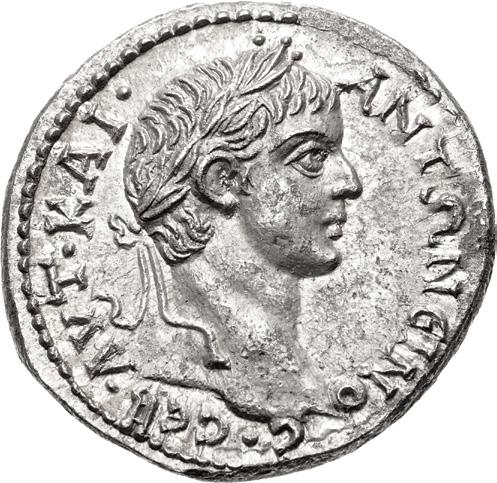
536892. SELEUCIS and PIERIA, Antioch. Caracalla. AD 198-217. AR Tetradrachm (27mm, 12.59 g, 11h). Struck AD 204. Laureate head right / Eagle standing facing, head and tail right, with wings spread, on leg and thigh of sacrificial animal. Prieur 190 (this coin); McAlee 664. Lightly toned with underlying luster. EF. Excellent young portrait. Extremely rare, two known to Prieur, and none in CoinArchives. $2250
Ex Michel Prieur Collection (Classical Numismatic Group 111, 29 May 2019), lot 534, purchased from Baldwin’s, 1991.

536890. SELEUCIS and PIERIA, Laodicea ad Mare. Septimius Severus. AD 193-211. AR Tetradrachm (26mm, 14.06 g, 12h). Struck AD 207-209. Laureate and draped bust right / Eagle standing facing, head and tail left, with wings spread, holding wreath in beak; star between legs. Prieur 1140; Prieur & Amandry Group II, 22; McAlee, Severan, Group 2, 16. Lightly toned. Near EF. $1250
Ex Michel Prieur Collection (Classical Numismatic Group 111, 29 May 2019), lot 553; Aufhäuser 10 (5 October 1993), lot 454.
Second Known
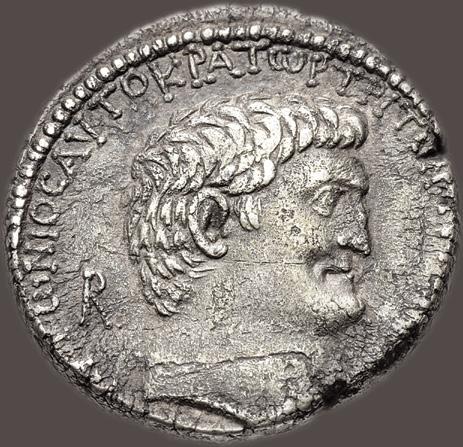

566259. SELEUCIS and PIERIA. Mark Antony & Cleopatra. Circa 36 BC. AR Tetradrachm (26mm, 15.03 g, 12h). Uncertain mint of Mark Antony & Cleopatra. BACIΛICCA KΛЄOΠATPA ΘЄA [NЄωTЄPA], diademed bust of Cleopatra right, wearing earring, necklace, and embroidered dress / [AN]TωNIOC AVTOKPATωP TPITON [TPIωN ANΔPωN], bare head of Antony right; R · to left. McAlee 176 = Prieur 29 = RPC I 4096 = CHA 1 454 = Sarnakunk (IGCH 1746) 372; Butcher, pp. 55-8; HGC 9, 1361. Iridescent toning, porosity, tiny edge split. Good VF. Excellent portraits. Apparently the second known, only the Sarnakunk coin cited in references, none in CoinArchives. Extremely rare. $95,000
The joint coinage of Antony and Cleopatra, especially their tetradrachms, presents a number of challenges in their attribution. Dated to the period of Antony’s war with the Parthians, this issue was struck in the theater of operations with the financial assistance of the Egyptians. Following the uneasy reconciliation of the Second Triumvirate at Brundisium in 40 BC, Antony gained control of Rome’s eastern provinces of Greece, Asia Minor, Syria, and Cyrene, as well as a number of client-kingdoms. Among these was Ptolemaic Egypt, one of the richest and then under the de facto rule of Cleopatra VII along with her son by Julius Caesar, Ptolemy XV Caesarion. With the rise of the Parthian Empire, beginning in the third century BC and the expansion of the Roman Republic into the Eastern Mediterranean during the second century BC, the two were in an almost perpetual war with each other for control of these client-kingdoms, especially Armenia. While Egypt remained relatively untouched by these wars, there was a great fear in Rome that the loss of this important ally would create a power vacuum, thereby threatening Rome’s eastern provinces, especially Asia. The defeat of Crassus at Carrhae in 54 BC exposed the weakness of eastern foreign policy by bringing Armenia under Parthian control. Recognizing the need to re-exert Roman control in the East and decisively check the Parthian Empire, Caesar, shortly before his assassination in 44 BC was planning a Parthian campaign. It was not until 41 BC, after the assassins had been defeated, that Rome looked to reassert its power in the East. After conquering Palmyra, which was located on the RomanParthian border, Antony left behind two legions, while he wintered in Alexandria with Cleopatra. This action prompted the Parthians to invade and rally those Republicans still remaining in Syria to join the Parthian side. Known as the Pompeian-Parthian invasion of 40 BC, it began a two year war between the Caesarians and the Parthian Empire that resulted in the restoration of Parthian-held territories, including Syria, by 38 BC. Antony then planned a full-scale invasion of Parthia. Since he was unable to rely on military support from Octavian, who had no intention of supporting him with additional legions, Antony allied himself with Cleopatra, who provided him with military and financial support. Having a force twice as large as that of Crassus almost two decades earlier, Antony’s plan was to swing north into Armenia and, having reconquered it, move southward into the Parthian heartland and conquer the capital of Ekbatana. Unfortunately this ambitious plan failed and Antony was forced to retreat into Syria by late 36 BC, having lost 40% of his army in the process. A second attempt was more successful. Again, Antony invaded Armenia with Egyptian assistance. As a result of this victory, a mock Roman triumph was held in Alexandria and, in Autumn 34 BC, the event known as the ‘Donations of Alexandria’ was held wherein Antony granted his children by Cleopatra, as well as Ptolemy XV Caesarion, the lands held by Rome and Parthia, along with numerous titles. The event proved the final breaking point of the Second Triumvirate, and caused the Final War of the Roman Republic with the defeat of Antony and Cleopatra at Actium in 31 BC.
Jupiter in Pisces – Ex Boston Museum of Fine Arts
559025. EGYPT, Alexandria. Antoninus Pius. AD 138-161. Æ Drachm (34mm, 22.15 g, 12h). Zodiac series. Dated RY 8 (AD 144/145). AVT K T AIΛ A∆P ANTωNЄINOC ЄB (sic) ЄVC, laureate head right / Jupiter in Pisces – Bust right of Zeus (Jupiter), wearing taenia and draped on left shoulder, transverse scepter across right shoulder; star of eight rays before; fish right and fish left below; L-H (date) to either side. Köln –; Dattari (Savio) 2981; K&G 35.260; RPC IV.4 Online 13555/33 (this coin cited and illustrated); Emmett 1692.8. Green patina with traces of red, light roughness. Near VF. Rare, one of the better types in the Alexandrian Zodiac series. $2750

Ex Stein A. Evensen Collection; Boston Museum of Fine Arts Collection (Gemini VI, 10 January 2010), lot 827, gift of Mr. & Mrs. Cornelius C. Vermeule, 1985.
The Great Sothic Cycle was a calendrical cycle based on the heliacal rising in July of the star Sirius (known to the Greeks as Sothis) and lasting approximately 1460 years. According to ancient Egyptian mythology, in a Golden Age, the beginning of the flooding of the Nile coincided exactly with the rising of Sirius, which was reckoned as the New Year. Only once every 1460 years did Sirius rise at exactly the same time. Thus, the coincidence of this along with the concurrent beginning of the flooding of the Nile gave the event major cosmological significance by heralding not just the beginning of a new year, but the beginning of a new eon. This event also was thought to herald the appearance of the phoenix, a mythological bird which was reborn every 500 to 1000 years out of its own ashes. According to one version of the myth, each new phoenix embalmed its old ashes in an egg of myrrh, which it then deposited in the Egyptian city of Heliopolis. So important was the advent of the new Great Sothic Cycle, both to the realignment of the heavens and its signaling of the annual flooding of the Nile, that the Egyptians celebrated it in a five-day festival, which emphasized the important cosmological significance. In the third year of the reign of Antoninus Pius (AD 139/40), a new Great Sothic Cycle began. To mark this event, the mint of Alexandria struck an extensive series of coinage, especially in large bronze drachms, each related in some astrological way to the reordering of the heavens during the advent of the new Great Sothic Cycle. This celebration would continue throughout Pius’ reign, with an immense output of coinage during the eighth year of his reign in Egypt, which included this coin type, part of the Zodiac series.
Moon in Cancer
561923. EGYPT, Alexandria. Antoninus Pius. AD 138-161. Æ Drachm (35.5mm, 26.31 g, 12h). Zodiac series. Dated RY 8 (AD 144/145). AYT K T AIΛ A∆P ANTωNINOC CЄB ЄVC, laureate head right / Moon in Cancer – Draped and diademed bust of Selene (Moon) right; star of eight rays before, crescent moon below, crab beneath all; [L]–H (date) to either side. Köln 1494; Dattari (Savio) 2964; K&G 35.270; RPC IV.4 Online 13545; Emmett 1681.8. Brown patina with touches of green and red, a couple smoothing/cleaning scratches. VF. $2000

An enormous crab came to the aid of the Lernaean Hydra in its battle with Herakles by nipping Herakles’ foot with a claw. In reward for the crab’s service, Hera set its image among the twelve signs of the Zodiac.
559026. EGYPT, Alexandria. Antoninus Pius. AD 138-161. Æ Drachm (33.5mm, 24.52 g, 12h). Dated RY 12 (AD 148/149). AVT K T AIΛ A∆P ANTωNЄINOC CЄB ЄVCЄ, laureate, draped, and cuirassed bust right / Serapis seated left on throne, holding scepter and resting hand on head of Kerberos; all within distyle temple, pediment decorated with disk and [uraei]; L ΔωΔЄ KATO (date) around. Köln 1617-8; Dattari (Savio) 8904-5; K&G 35.444; RPC IV.4 Online 13643/49 (this coin cited and illustrated); Emmett 1668.12. Dark brown patina with traces of green, some light scratches and marks. VF. $875
Ex Rocky Mountain Collection; Künker 89 (8 March 2004), lot 1796.
ROMAN REPUBLICAN
563119. M. Baebius Q.f. Tampilus. 137 BC. AR Denarius (17.5mm, 3.99 g, 12h). Rome mint. Helmeted head of Roma left; [x (mark of value) below chin, TAÂpiL to right] / Apollo, holding branch, bow and arrow, and reins, driving galloping quadriga right; rOÂ[A] below horses, [Â •] BAeBi • q [• F] in exergue. Crawford 236/1a; Sydenham 489; Baebia 12; BMCRR Rome 935; RBW 975. Toned with a hint of iridescence, a couple minor bumps on obverse. EF. $575
561912. Gargilius, Ogulnius, and Vergilius. 86 BC. AR Denarius (20mm, 3.90 g, 9h). Rome mint. Laureate head of Apollo right; thunderbolt below / Jupiter, holding thunderbolt in right hand and reins in left, driving galloping quadriga right. Crawford 350A/2; Sydenham 723; RSC 226; BMCRR Rome 2622-4; RBW 1333. Toned with some light iridescence. EF. $950
Ex Baldwin’s 57 (23 September 2008), lot 26.
Ulysses Returns
564458. C. Mamilius Limetanus. 82 BC. AR Serrate Denarius (19mm, 3.93 g, 8h). Rome mint. Draped bust of Mercury right, wearing winged petasus; to left, Â above caduceus / Ulysses, wearing pileus and mariner’s dress, walking right, leaning on staff in left hand and extending his right hand toward his dog, Argus, who advances toward him; C • ÂAÂiL downward to left, LiÂeëN upward to right. Crawford 362/1; Sydenham 741; Mamilia 6; BMCRR Rome 2725; RBW 1370 var. (obverse control letter). Lovely iridescent toning. Choice EF. $2750
Ex Matthew Curtis Collection; Classical Numismatic Review XV.4 (4th Quarter, 1990), no. 40.
The obverse and reverse of this coin refer to the lineage of the gens Mamilia, who claimed their descent from Mamilia, the daughter of Telegonus, the son of Ulysses and Circe, and a descendant of Mercury. The reverse scene depicts the moment when, returning home from his long wanderings in the guise of a beggar so as to surprise and kill the many suitors of his wife Penelope, Ulysses’ aged dog Argus recognizes him:
Soon as he perceived Long-lost Ulysses nigh, down fell his ears Clapped close, and with his tail glad sign he gave Of gratulation, impotent to rise, And to approach his master as of old. Ulysses, noting him, wiped off a tear Unmarked. . . . Then his destiny released Old Argus, soon as he had lived to see Ulysses in the twentieth year restored. (Hom. Od. 17.290 [Cowper’s translation]). At last, seeing his master after so many years, the old dog dies.
561913. C. Poblicius Q.f. 80 BC. AR Serrate Denarius (19mm, 3.95 g, 6h). Rome mint. Draped bust of Roma right, wearing helmet ornamented with gryphon’s head, and at each side a feather; u above, rOÂA to left / Hercules, naked, standing left, and strangling the Nemean lion; club on ground at his feet, bow case to left; u to upper left, C • pOBLiCi • œ • F to right. Crawford 380/1; Sydenham 768; Poblicia 9; BMCRR Rome 2899; RBW 1408 var. (control letter). Light iridescent toning, a couple minor scratches. EF. Wonderful reverse. $925
Ex Numismatica Ars Classica 51 (5 March 2009), lot 29.
563855. M. Plaetorius M.f. Cestianus. 57 BC. AR Denarius (18.5mm, 3.86 g, 3h). Rome mint. Turreted and draped bust of Cybele right; CeÍTiANuÍ and forepart of lion to left, globe below chin; all within bead and reel border / Curule chair; uncertain symbol to left; Â • pLAeTOriuÍ • AeD • Cur • ex • Í C around; all within bead and reel border. Crawford 409/2; Sydenham 808; Plaetoria 3; BMCRR Rome 3576; RBW 1484 var. (symbol on rev.). Attractive iridescent toning, slightly off center on reverse. Near EF. $695
Euterpe, Muse of Music and Poetry
564459. Q. Pomponius Musa. 56 BC. AR Denarius (17mm, 4.07 g, 8h). Rome mint. Laureate head of Apollo right; two crossed tibiae to left / Euterpe, the Muse of Music and Lyric Poetry, wearing long flowing tunic and peplum, standing right, supporting her head with her left hand by resting her elbow on column, and holding two tibiae in right hand; œ • pOÂpONi downward to left, ÂuÍA downward to right. Crawford 410/5; Sydenham 815; Pomponia 13; BMCRR Rome 3613; RBW 1487. Lovely iridescent toning, a few minor deposits. Near EF. $2250
Ex Numismatica Ars Classica 5 (25 February 1992), lot 324.
The Muses were nine divine maidens, the daughters of Zeus and Mnemosyne (”Memory”), who embodied the human arts and sciences. They were Calliope (epic poetry), Clio (history), Erato (love poetry), Euterpe (music, lyric poetry), Melpomene (tragedy), Polyhymnia (hyms), Terpsichore (dance), Thalia (comedy), and Urania (astronomy). Knowingly or not, the moneyer Q. Pomponius Musa’s denarius group, surely intended as a canting pun on his cognomen, created a “collector’s set” of coins that challenged the holder of one example to find all of its components, which included Hercules Musarum, the “host” of the assembly.
559027. The Pompeians. Cnaeus Pompey Jr. Summer 46-Spring 45 BC. AR Denarius (18.5mm, 3.90 g, 6h). Corduba mint; Marcus Poblicius, legatus pro praetore. Helmeted head of Roma right; [Â] • ROBLiCi • Leg • RrO [Rr] around; all within bead and reel border / Hispania standing right, round shield on her back, holding two spears and presenting large palm frond to Pompeian soldier standing left on prow, armed with sword; [CN • ÂAgNuÍ • i]ÂR around. Crawford 469/1a; CRI 48; Sydenham 1035; RSC 1 (Pompey the Great); BMCRR Spain 64; RBW –. Attractively toned with some light iridescence, slightly off center, minor die break on reverse. EF. $2250

564461. The Pompeians. Sextus Pompey. 42-38 BC. Æ As (30mm, 24.24 g, 12h). Uncertain Sicilian mint. Laureate head of Janus with the features of Cn. Pompeius Magnus; VgNabove / Prow of galley right; piuÍ above, iÂp in exergue. Crawford 479/1; CRI 336; Sydenham 1044; BMCRR Spain 101; RBW 1675-6. Dark green patina with traces of red. Good VF. $2250
Sextus Honors Magnus
561915. The Pompeians. Sextus Pompey. 42-38 BC. AR Denarius (18mm, 4.13 g, 5h). Massilia (Marseilles) mint; Q. Nasidius, commander of the fleet. Bare head of Pompey the Great right; trident to right; below, dolphin right; NepTuNi to left / Galley with bank of rowers right, under full sail, helmsman steering rudder, hortator standing on prow; six-rayed star to upper left; [œ •] NAÍiDiuÍ below. Crawford 483/2; CRI 235; Sydenham 1350; RSC 20 (Pompey the Great); BMCRR Sicily 21; RBW 1698. Light iridescent toning, slightly off center on reverse. EF. Among the finest known for the issue, with an excellent portrait of Pompey. $27,500
Ex Numismatica Ars Classica 92 (23 May 2016), lot 401.
Sextus Pompey came of age during the ascendancy of his father, Gnaeus Pompeius Magnus (Pompey the Great), as the leading general of Rome and the most powerful man in the Republic. After Pompey’s defeat by Julius Caesar at Pharsalus in August of 48 BC, and his treacherous murder in Egypt later that year, Sextus joined the Pompeian resistance to Caesar in Spain. Caesar’s assassination on March 15, 44 BC brought a brief revival of Senatorial control, during which Sextus relocated to Massalia in southern Gaul. In April of 43 BC, the Senate appointed him commander of the Roman fleet. Although the promotion was rescinded three months later, Sextus wasted no time in seizing Sicily and spent the next months building an impregnable power base on the island even as Rome fell under the sway of Caesar’s political heirs, the Triumvirs Antony, Octavian and Lepidus. This beautiful denarius belongs to the brief interval between Caesar’s murder and Sextus’ appointment as Praefect of the Fleet, during his sojourn at the Gallic port city of Massilia. The obverse portrait is clearly recognizable as Pompey the Great, although the legend identifies him as “son of Neptune” (an epithet won by Magnus after his defeat of the Cilician Pirates, and later claimed by Sextus himself) and provides him appropriate attributes— a dolphin and trident. The warship on the reverse appears to be a hemiola, a fast ramming vessel with two banks of oars totaling 52 a side. Interestingly, Sextus himself is not named; instead the moneyer is identified as Quintus Nasidius, a loyal Pompeian commander of naval forces who backed Sextus in his early career, only to later defect to Mark Antony.
Caesar’s First Coinage
566446. The Caesarians. Julius Caesar. April-August 49 BC. AR Denarius (18mm, 3.88 g, 7h). Military mint traveling with Caesar. Elephant advancing right, trampling on horned serpent; CAeÍAr in exergue / Emblems of the pontificate: simpulum, aspergillum, securis, and apex. Crawford 443/1; CRI 9; Sydenham 1006; RSC 49; BMCRR Gaul 27; RBW 1557. Attractive iridescent toning, a couple light marks. EF. Well centered. $7500
This is the first coinage to bear Julius Caesar’s name, and likely commenced after Caesar crossed the Rubicon in January 49 BC and seized control of the bullion stores in the public treasury left behind by the panic-stricken senate and their champion, Pompey the Great. Despite being the most widespread of all Caesar’s coins, the design is still somewhat mysterious. Authorities have even debated which side is which: Crawford describes the elephant as the obverse, but other experts dispute this. The symbolism is commonly held to show the triumph of good (elephant) over evil (serpent or dragon). Alternatively, the “horned serpent” may be intended to represent a carnyx, a serpent-shaped horn used by the Celtic tribes in Gaul, whom Caesar had recently overcome in his epic eight-year conquest, in which case the elephant would again represent Caesar himself, or the unstoppable juggernaut of Rome. Unlike Pompey, Caesar brazenly placed his own name on the coinage without having the constitutional authority to do so, as Sulla had done 33 years before. The reverse depicts the emblems of the Pontifex Maximus, an office Caesar had possessed since 63 BC.
541045. The Caesarians. Julius Caesar. Late 48-47 BC. AR Denarius (17mm, 3.87 g, 6h). Military mint traveling with Caesar in North Africa. Diademed head of Venus right / Aeneas advancing left, holding palladium and bearing Anchises on his shoulder; CAeÍAr downward to right. Crawford 458/1; CRI 55; Sydenham 1013; RSC 12; BMCRR East 31; RBW 1600. Light iridescent toning, some scratches, two small bankers’ marks on obverse. Near EF. Well struck and centered. $2500
Among the Finest Known
564364. The Caesarians. Julius Caesar. Late 46-early 45 BC. Æ Dupondius (26.5mm, 15.19 g, 12h). Rome mint; C. Clovius, prefect. Winged and draped bust of Victory right; CAeÍAr • DiC • Ter outward from lower right / Minerva advancing left, holding trophy over shoulder and spears and shield; at feet to left, snake gliding left with head erect; C • CLOui prAeF around. Crawford 476/1a; CRI 62; Sydenham 1025; BMCRR Rome 4125; RBW 1667. Attractive dark green patina with traces of red. EF. Certainly among the finest known for this issue. $15,000

Ex Vinchon (23 April 1976), lot 6; Étienne Bourgey (4 November 1913), lot 672.
Exceptional Caesar Portrait
561916. The Caesarians. Julius Caesar. 42 BC. AR Denarius (20mm, 3.81 g, 12h). Rome mint. L. Livineius Regulus, moneyer. Wreathed head right; laurel branch to left, winged caduceus to right / Bull charging right; L • LiuiNeiuÍ above, [re]guLuÍ below. Crawford 494/24; CRI 115; Sydenham 1106; RSC 27; BMCRR Rome 4274-6; RBW 1730. Attractive old cabinet toning, slightly off center. EF. A fabulous portrait of Caesar. $24,500
564486. The Republicans. Brutus. Late summer-autumn 42 BC. AR Denarius (18.5mm, 3.80 g, 12h). Military mint traveling with Brutus and Cassius in western Asia Minor or northern Greece. P. Servilius Casca Longus, moneyer. Laureate and bearded head of Neptune right; trident below; CAÍCA to left, LONguÍ to right / Victory advancing right on broken scepter, holding palm frond in left hand over left shoulder and broken diadem bound with fillet with both hands; BruTuÍ to left, iÂp to right. Crawford 507/2; CRI 212; Sydenham 1298; RSC 3; BMCRR East 63–5; RBW 1780. Attractive cabinet toning, minor flan flaw in field on obverse, edge chip and light deposits on reverse. EF. $4500
Reportedly ex Kunst und Munzen (7 October 1982), lot 386.
561917. The Republicans. Cn. Domitius L.f. Ahenobarbus. 41-40 BC. AR Denarius (19mm, 3.75 g, 8h). Uncertain mint in the region of the Adriatic or Ionian Sea. Bare head right, wearing short beard; AheNOBAr upward to right / Prow right surmounted by a military trophy; CN • DOÂiTiuÍ • iÂp around from lower left. Crawford 519/2; CRI 339; Sydenham 1177; Domitia 21; BMCRR East 94–7; RBW 1803. Lovely iridescent toning, small flan flaw on obverse. Near EF. Excellent portrait and well centered. $9500
Ex H. Schulman (14 February 1958), lot 1958.
Gnaeus Domitius Ahenobarbus commanded a fleet against the Triumvirs, achieving a minor victory in September of 42 BC. But that very day, the Triumvirs won the battle of Philippi and Ahenobarbus found himself fighting for a lost cause. He became a piratical rogue, terrorizing the ports of the Adriatic like his western counterpart, Sextus Pompey, until he signed the Pact of Brundisium in 40 BC, which reconciled him to Mark Antony in particular. His great-grandson would become the Emperor Nero (AD 54-68). The rare coinage of Ahenobarbus belongs to his stint as a “pirate king” 42-40 BC. This silver denarius bears an appropriately nautical reverse celebrating his victories at sea. The lean, bearded portrait on the obverse remains enigmatic; it may represent Gnaeus himself, or one of his ancestors.
561918. The Triumvirs. Mark Antony and Octavia. Summer-autumn 39 BC. AR Cistophorus (28mm, 11.81 g, 12h). Ephesus mint. Head of Antony right, wearing ivy wreath; lituus below; Â • ANTONiuÍ • iÂp • COÍ • DeÍig • iTer eT • TerT around; all within wreath of ivy and flowers / Draped bust of Octavia right above cista mystica, flanked by interlaced serpents with heads erect; iii • uir • r • p • C • around. CRI 262; Sydenham 1197; RSC 2; RPC I 2201. Attractively toned with some iridescence, a few light marks and scratches. Near EF. Wonderful portrait of Mark Antony. $8950

Ex Roma VII (22 March 2014), lot 979; G. Hirsch 166 (16 May 1990), lot 767; Münzen und Medaillen AG FPL 445 (June 1982), no. 44.
Shortly after the Battle of Philippi in 42 BC, cracks began to appear in the Second Triumvirate. Antony’s affair with Cleopatra, queen of Egypt, and his designs on Rome’s eastern holdings, prompted Octavian to formulate a binding agreement that would buy him time. At Brundisium a pact was signed, bringing about a reconciliation and some semblance of peace. As a condition of this reconciliation, Antony was married to Octavian’s widowed sister, Octavia. She stayed with him in Athens while he continued to prepare for a war against Parthia, and where, in 39 BC, he was associated with the “New Dionysus”. In 37 BC, she helped negotiate the Pact of Tarentum, which renewed the triumvirate until 33 BC. Antony, by this time, however, had renewed his affair with Cleopatra. He remained in the East, where he married the queen, and subsequently fathered several children. In 32 BC, as a renewal of civil war became imminent, Antony divorced Octavia. In the aftermath of Antony’s death, Octavia, known for her loyalty and nobilty, brought Antony’s surviving children to Rome to live with her.
564462. The Triumvirs. Mark Antony. Autumn 32-spring 31 BC. AR Denarius (16.5mm, 3.77 g, 5h). Legionary type. Patrae(?) mint. Praetorian galley right; ANT Aug above, iii uir • r • p • C below / Aquila between two signa; LeG iu across lower field. Crawford 544/17; CRI 352; Sydenham 1219; RSC 30; BMCRR East 195; RBW –. Deep cabinet toning, slightly off center on obverse. Choice EF. $5750
Ex Douglas O. Rosenberg Collection (Triton XXII, 8 January 2019), lot 965, purchased from Münzen und Medaillen AG, 12 July 2001; William N. Rudman Collection (illustrated in Schaefer photofile, binder 14, p. 79).
564463. The Triumvirs. Mark Antony. Autumn 32-spring 31 BC. AR Denarius (17mm, 3.54 g, 6h). Legionary type. Patrae(?) mint. Praetorian galley right; ANT Aug above, iii uir • r • p • C below / Aquila between two signa; LeG u across lower field. Crawford 544/18; CRI 354; Sydenham 1221; RSC 32; BMCRR East 196; RBW 1840; FFC 36 (this coin illustrated). Lovely iridescent toning, small spot of weak strike on reverse. Choice EF. $3000
Ex Alba Longa (Jose Fernandez Molina) Collection; Antiqua FPL II (ND [1995]), 24f.
555913. The Triumvirs. Octavian and Divus Julius Caesar. 38 BC. Æ Sestertius or Dupondius (30mm, 21.29 g, 9h). Mint in southern Italy(?). Bare head of Octavian right, wearing slight beard; CAeÍA[r] to right, Diui • F to left / Wreathed head of Divus Julius Caesar right; DiuOÍ to right, [iuL]iuÍ to left. Crawford 535/1; cf. Alföldi & Giard 34 (for type); CRI 308; Sydenham 1335; RPC I 620; RBW 1822. Brown patina with touches of green and red, “adjustment” marks. Good VF. $2750
564464. The Triumvirs. Octavian. Autumn 32-summer 31 BC. AR Denarius (19mm, 3.75 g, 12h). Uncertain Italian mint, possibly Rome. Diademed head of Pax right; cornucopia to left, olive branch to right / Octavian, in military attire, walking right, holding transverse spear in left hand over left shoulder, and raising right hand in adlocutio; [C]AeÍAr Diui • F across field. CRI 400; RIC I 253; RSC 72; BMCRR Rome 4329, 4331-2 = BMCRE 611, 613-4; BN 6-11. Light iridescent toning. Choice EF. $5250
566196. Augustus. 27 BC-AD 14. AR Denarius (18mm, 3.89 g, 6h). Uncertain Spanish mint (Colonia Caesaraugusta?). Struck circa 19-18 BC. Head right, wearing oak wreath / CAESAR above, AVGVSTVS below, S P above and Q R below shield inscribed CL•V; laurel branches flanking. RIC I 36a; ACIP 4037; RSC 51; BMCRE 354-5 = BMCRR Rome 4446-7; BN 1333-7 (Nimes). Lightly toned, hairline flan crack, traces of deposits. Near EF. $4750
564466. Gaius (Caligula), with Divus Augustus. AD 37-41. AR Denarius (18mm, 3.70 g, 1h). Lugdunum (Lyon) mint. 1st emission, AD 37. C CΛESΛR ΛVG GERM P M TR POT COS, bare head of Gaius (Caligula) right / Radiate head of Divus Augustus right; two stars flanking. RIC I 2; Lyon 157 (D–/R29 [unlisted obv. die]); RSC 11; BMCRE 4-5; BN 3-8. Attractive cabinet tone, a few marks and light scratches. Good VF. $8750
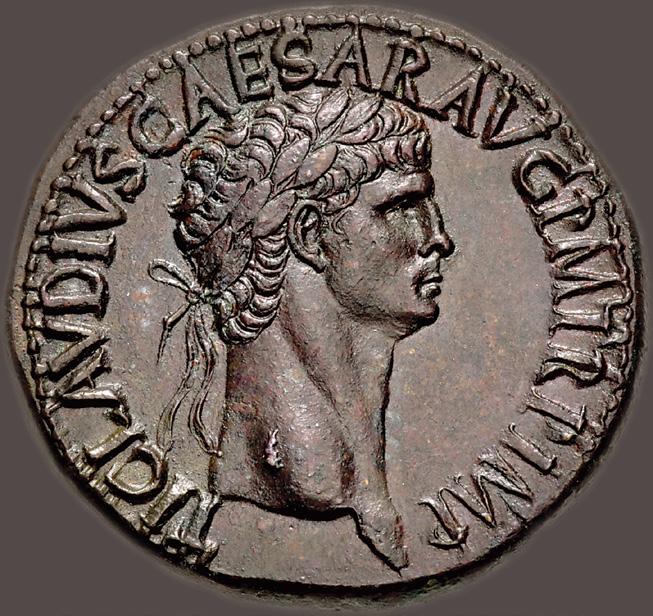
564467. Claudius. AD 41-54. Æ Sestertius (36mm, 30.62 g, 6h). Rome mint. Struck AD 41-42. TI CLAVDIVS CAESAR AVG P M TR P IMP, laureate head right / EX S C/ O B/ CIVES/ SERVATOS in four lines within oak wreath. RIC I 96; von Kaenel Type 54; BMCRE 115-6; BN 152-61. Wonderful reddish-brown patina. EF. Exceptional and one of the finest known of this type. $19,500
Ex Triton VI (14 January 2003), lot 820; Classical Numismatic Group XXXII (7 December 1994), lot 357 and front cover coin.
559028. Claudius. AD 41-54. Æ As (30.5mm, 9.58 g, 6h). Rome mint. Struck AD 41-42. TI CLAVDIVS • CAESAR • AVG P M TR P IMP, bare head left / LIBERTAS AVGVSTA, S C across field, Libertas, draped, standing right, holding pileus in right hand and extending left hand. RIC I 97; von Kaenel Type 62; BMCRE 145-6; BN 177-8. Even green-brown patina, lightly smoothed. EF. Wonderful portrait. $2500 56

561919. Claudius. AD 41-54. AR Cistophorus (27mm, 11.74 g, 6h). Ephesus mint. Struck AD 41-42. TI CLAVD CAES • AVG, bare head left / COM ASI across field, distyle temple of Roma and Augustus, enclosing standing facing figures of Claudius, holding spear in right hand, being crowned by Fortuna, holding wreath in right hand and cornucopia in left; ROM ET AVG on entablature. RIC I 120 (Pergamum); RPC I 2221; RSC 3; BMCRE 228; BN 304-6 (Pergamum). Toned. Near EF. Bold portrait. $8750

Ex Numismatica Ars Classica 51 (5 March 2009), lot 183; Tkalec (19 February 2001), lot 254.
Unique and Unpublished
564366. Civil War. AD 68-69. AR Denarius (17mm, 3.37 g, 6h). Group IIIa (‘Augustus’ series). Uncertain mint in Gaul. Struck AD 68. CAESAR AVGVSTVS, bare head of Augustus left / S • P • Q • R/ CL • V in two lines on clipeus virtutis. Unpublished in the standard references. Attractive cabinet tone. Near EF. Apparently unique. Of great numismatic interest. $6500
Ex Durand Collection (Roma VII, 22 March 2014), lot 1012.
This coin is a restitution of the type issued under Augustus (RIC I 42b), and follows that coin very closely, except for the style of the portrait which is distinctly ‘provincial’. This style is however entirely in keeping with the manner of engraving common among Vindex’s engravers, which tends towards tightly pursed lips, pointed noses and furrowed brows. Quite apart from its being a previously unrecorded type for Vindex, this coin is also among a certain rare league of that series, being a direct copy of a pre-existing type. Other restitutions included the Divus Iulius comet type (RIC I 37 and 102), the capricorn reverse type, and the bull reverse type popular under Augustus. The appearance of this type is therefore a pleasant surprise, but not completely unexpected.
564468. Galba. AD 68-69. Æ Sestertius (36mm, 27.00 g, 6h). Rome mint, 3rd officina. Struck circa October AD 68. SER GALBA IMP CAESAR AVG TR P, laureate and draped bust right / S P Q R/ O B/ CIV • SER in three lines within oak wreath. RIC I 405; ACG – (unlisted dies); BMCRE 114; BN 210. Lovely brown patina. VF. Wonderful portrait. $7750
563858. Vitellius. AD 69. AR Denarius (19mm, 3.46 g, 6h). Rome mint. Struck circa late April-20 December. [A VIT] ELLIVS GERMAN IMP TR P, laureate head right / LIBERTAS RESTITVTA, Libertas standing facing, head right, holding pileus in right hand and vindicta in left. RIC I 81; RSC 48; BMCRE 13; BN 41. Lightly toned, struck slightly off center. Good VF. Bold portrait. $1450
564367. Domitian. As Caesar, AD 69-81. AR Denarius (19mm, 3.47 g, 6h). Rome mint. Struck under Vespasian, AD 79, to 24 June. CAESAR AVG F DOMITIANVS COS VI, laureate head right / PRINCEPS IVVENTVTIS, Salus, draped, standing right, left leg crossed over right, resting left arm on column, holding snake in right hand and feeding it out of patera in left. RIC II.1 1084 (Vespasian); RSC 384 corr. (Salus standing right, not left); BMCRE 265-6 (Vespasian); BN 237 (Vespasian). Attractive tone with underlying luster. Choice EF. Struck with fresh dies. Outstanding portrait. $3950
Ex Gadoury (16 November 2018), lot 68.
566200. Domitian. As Caesar, AD 69-81. AV Aureus (19.5mm, 7.24 g, 6h). Rome mint. Struck under Vespasian, AD 7778. CΛESΛR ΛVG F DOMITIΛNVS, laureate head right / COS V, she-wolf standing left, head right, suckling the twins (Romulus and Remus); boat in exergue. RIC II.1 960 (Vespasian); Calicó 820; BMCRE 237-9 (Vespasian); BN 210-2; Biaggi 398. Slight bend in flan. Good VF. $15,000
555916. Nerva. AD 96-98. AR Cistophorus (25mm, 10.79 g, 6h). Uncertain mint in Asia Minor (or Rome for circulation in Asia Minor). Struck AD 97. IMP NERVA CAES AVG P M TR POT P P, laureate head right / COS III, Cult statue of Diana of Perge within distyle temple; DIΛNΛ PERG across entablature. RIC II 116; Woytek, Cistophore 3a; RPC III 1301; RSC 42; BMCRE 83; BN 64. Lightly toned. EF. $3500
563018. Trajan. AD 98-117. AR Denarius (19mm, 3.15 g, 7h). Rome mint. Struck circa AD 106-107. IMP TRΛIΛNO ΛVG GER DΛC P M TR P COS V P P, laureate bust right, wearing aegis / S • P • Q • R • OPTIMO PRINCIPI, Annona, draped, wearing wreath of grain ears, standing left, holding grain ears downward in right hand over modius to left, containing grain ears, holding cornucopia in left hand; to right, prow of ship. RIC II 165; Woytek 212c; Strack 102ε; RSC 467b; BMCRE 1712; BN 380. Lightly toned. Near EF. Superior portrait in high relief. $1500
Ex Numismatica Ars Classica 92 (23 May 2016), lot 531; A. Lynn Collection (Freeman & Sear 17, 15 December 2009), lot 289.
564470. Trajan. AD 98-117. AR Denarius (19mm, 3.30 g, 8h). Rome mint. Struck circa AD 112-113. IMP TRAIANO AVG GER DAC P M TR P COS VI P P, laureate bust right, slight drapery / S P Q R OPTIMO PRINCIPI, ΛLIM ITΛL in exergue, Annona standing left, holding grain ears in right hand over child to left and holding cornucopia in left. RIC II 243; Woytek 395b–2; RSC 9b; BMCRE 472-3; BN 664. Attractive iridescent tone, a couple of tiny deposits. Choice EF. $2000
559340. Trajan. AD 98-117. AR Denarius (18mm, 3.31 g, 6h). Rome mint. Struck winter AD 114-early AD 116. IMP CAES NER TRAIANO OPTIMO AVG GER DAC, laureate and draped bust right / P M TR P COS VI P P S P Q R, Felicitas, draped, standing left, holding up caduceus in right hand and cornucopia in left. RIC II 343; Woytek 519v; Strack 228; RSC 278; BMCRE 541-4; BN 821-2. A few faint hairlines on reverse. Near EF. Bold portrait. $475
563019. Trajan. AD 98-117. Æ Sestertius (33mm, 29.27 g, 6h). Rome mint. Struck winter AD 114-early 116. IMP CAES NER TRAIANO OPTIMO AVG GER DAC P M TR P, laureate and draped bust right / SENATVS POPVLVSQVE ROMANVS, FORT RED/ S • C in two lines in exergue, Fortuna, draped, seated left on low chair, feet on stool, holding rudder in right hand and cornucopia in left. RIC II 652; Woytek 542v–1; Strack 459; Banti 66; BMCRE 1026; BN 847-8. Green-brown patina. Good VF. Exceptional portrait. $3950
561921. Hadrian. AD 117-138. AR Denarius (18.5mm, 3.78 g, 6h). “Travel series” issue (“Provinces cycle”) – The province alone. Rome mint. Struck circa AD 130-133. HADRIANVS • AVG COS III P P, bare head right / HISPANIA, Hispania reclining left, holding olive branch in right hand and resting left arm on rock; to left, rabbit right. RIC II.3 1535; Strack 303-4; RSC 822; BMCRE 846-7. A few minor marks. EF. $1250
559341. Hadrian. AD 117-138. AR Denarius (17.5mm, 3.13 g, 6h). “Travel series” issue (“Provinces cycle”) – Restitutor type. Rome mint. Struck circa AD 130-133. HADRIANVS AVG COS III P P, laureate head right / RESTITVTORI HISPANIAE, Hadrian standing left, holding volumen in left hand and extending right to raise up kneeling Hispania who shoulders olive branch; rabbit right between them. RIC II.3 1580; Strack 321δ; RSC 1260; BMCRE 889. Good VF. $925
559031. Hadrian. AD 117-138. AR Denarius (18mm, 3.25 g, 6h). “Travel series” issue (“Provinces cycle”) – Restitutor type. Rome mint. Struck circa AD 130-133. HADRIANVS AVG COS III P P, laureate head right / RESTITVTORI HISPANIAE, Hadrian standing right, extending right to raise up kneeling Hispania who shoulders olive branch; rabbit between them. RIC II.3 1584; Strack 322δ; RSC 1270; BMCRE 883-5. Small flan flaw on obverse, a few faint hairlines, minor reverse die wear. Near EF. $1200
Anepigraphic Reverse
564471. Sabina. Augusta, AD 128-136/7. AR Denarius (19mm, 3.38 g, 6h). Rome mint. Struck under Hadrian, AD 128-circa 129. SABINA AVGVSTA HADRIANI AVG P P, draped bust right, wearing double stephane with hair piled up and braided / Vesta seated left on throne, holding palladium on extended right hand and transverse scepter in left. RIC II.3 2486; Strack 364 (Hadrian) RSC 85; BMCRE 925-6 (Hadrian). Lightly toned. Near EF. A wonderfully delicate portrait of Sabina engraved in the finest style. $4750
563143. Faustina Junior. Augusta, AD 147-175. Æ Sestertius (31.5mm, 25.00 g, 12h). Rome mint. Struck under Antoninus Pius, circa AD 147-150. FAVSTINAE AVG • P II AVG FIL, draped bust right, wearing double band of pearls around head / VENVS, S C across field, Venus standing left, holding up apple in right hand and resting left hand on rudder set on ground, around which dolphin is coiled. RIC III 1388c (Pius); Strack 1305 (Pius); Banti 136; BMCRE 2148 (Pius). Dark brown patina, minor smoothing, some roughness on reverse. Good VF. Pleasing portrait from dies of artistic merit. $2250
Ex Leu 10 (29 May 1974), lot 183.
563020. Lucius Verus. AD 161-169. AR Denarius (18mm, 3.18 g, 6h). Rome mint. Struck AD 161. IMP L AVREL VERVS AVG, bare head right / Providentia standing left, holding globe on extended right hand and cornucopia in left. RIC III 463 (Aurelius); MIR 18, 22-14/10; RSC 144; BMCRE 35-6. Lustrous. Superb EF. A perfectly centered example in fine style. $1750
Ex Leu Numismatik 2 (11 May 2018), lot 265.
561924. Pertinax. AD 193. AR Denarius (17.5mm, 2.97 g, 6h). Rome mint. IMP CAES P HELV PERTIN AVG, laureate head right / PROVID DEOR COS II, Providentia standing left, raising right hand toward star, left hand on breast. RIC IV 11a; RSC 43; BMCRE 13. Iridescent cabinet tone. EF. Bold portrait. $6750
Ex Künker 153 (14 May 2009), lot 8786.
Septimius Severus – The Founder of Peace
563021. Septimius Severus. AD 193-211. AR Denarius (17.5mm, 3.19 g, 11h). Rome mint. Struck AD 200-201. SEVERVS AVG PART MAX, laureate head right / FVND ATOR PACIS, Septimius Severus, veiled, togate, standing left, holding branch in right hand and volumen in left. RIC IV 160; RSC 203; BMCRE 190 (same rev. die). Lightly toned. EF. Struck with fresh dies. $1200
Attractive and Rare Circus Scene
566451. Septimius Severus. AD 193-211. AR Denarius (18.5mm, 3.90 g, 12h). Rome mint. Struck AD 202. SEVERVS PIVS AVG, laureate head right / LAETITIA above, TEMPORVM below, ship with mast and sail in center of circus; above, four quadrigae driven left; below, ostrich, lion, zebra, bear and stag right, bull butting left, bear right, head left. RIC 274; RSC 253; BMCRE 343-4. Toned, flan crack. Good VF. Attractive and rare circus scene. $6500
Ex Gorny & Mosch 249 (11 October 2017), lot 761; Numismatica Ars Classica 84 (20 May 2015), lot 1066.
After the victory over the Parthians, seven-day games were held in the Circus Maximus. A ship was set up in the middle of the arena and a hundred exotic animals were released from its belly every day. The reverse picture shows different sections of the festivities. The chariot races can be seen in the upper area, the ship in the middle, and the wild animals below.
The Dacian Imperial Guard

564472. Caracalla. AD 198-217. Æ Sestertius (31mm, 23.13 g, 12h). Rome mint. Struck AD 214. M AVR ANTONINVS PIVS FELIX AVG, laureate, draped, and cuirassed bust right / P M TR P XVIII IMP III COS IIII P P, S C in exergue, “Adlocutio” scene: Caracalla, in military dress, standing right on low platform on left, raising right hand; with him on platform, to his left, officer standing right, to his right, officer standing facing; to right, Dacian bodyguard in short tunic and cloak standing right, holding falx, a second falx behind; to far right, two soldiers, helmeted in military dress, standing left, each holding an aquila in right hand and oblong shield in left; vexillum behind. RIC IV 525c; Banti 58; BMCRE p. 480, †. Attractive green patina. Good VF. Very rare. $8750
Ex Rainer Wilshke Collection (Numismatica Ars Classica 78, 26 May 2014), lot 1046; Numismatica Ars Classica 25 (25 June 2003), lot 522.
In AD 214, the emperor Caracalla mustered a large legionary force intent on invading the rival Parthian Kingdom, which was riven by dynastic disputes. This sestertius depicts Caracalla and his officers atop a platform, addressing his soldiers prior to battle. An interesting feature is the presence of a guardsman standing at the foot of the platform, armed with a long, curved weapon, facing the mass of soldiery. The presence of another weapon behind implies there are several such bodyguards present. These are certainly a Dacian imperial guard, armed with their native weapon, a deadly two-handed sickle sword called the falx. Little is known about this elite unit aside from their appearance on coins and monuments of the late second and third centuries AD. The first Dacian unit in the Roman Army was Cohors I Aelia Dacorum, raised by Hadrian and stationed in northern Britannia. The Dacians depicted here, however, are clearly a different unit serving specifically as imperial guards, perhaps as a counterweight to the Praetorians. In the first century BC/AD, the German guard had performed a similar function. The Dacian guards are seen in a similar pose on the Column of Marcus Aurelius, indicating the unit was in place by the AD 170s.
563022. Caracalla. AD 198-217. AR Denarius (19mm, 3.24 g, 12h). Rome mint. Struck AD 216. ANTONINVS PIVS AVG GERM, laureate and bearded head right / P M TR P XVIIII COS IIII P P, lion, radiate, walking left, holding thunderbolt in jaws. RIC IV 283c; RSC 367; BMCRE 178. Lightly toned. EF. A spectacular reverse struck from a fresh die. $1250
Ex H. C. Levis Collection – Pedigreed to 1925
564473. Geta. AD 209-211. Æ Sestertius (31mm, 28.03 g, 12h). Rome mint. Struck AD 211. P SEPTIMIVS GETA PIVS AVG BRIT, laureate head right / FORT RED TR P III COS II P P, S C in exergue, Fortuna, draped, seated left on throne, holding rudder on globe in right hand and cornucopia in left; wheel under throne. RIC IV 168a; Banti 20 (same obv. die as illustration); BMCRE 40-2. Green patina, hairline flan crack. Good VF. $6750
Ex Gemini III (9 January 2007), lot 425 (hammer $6,000); H. C. Levis Collection (Ars Classica XI, 18 June 1925), lot 761.
The reverse type commemorates the return of Caracalla and Geta from Britain to Rome after Septimius’ death at York on 4 February AD 211.
563861. Diadumenian. As Caesar, AD 217-218. AR Denarius (20.5mm, 3.26 g, 12h). Rome mint. 2nd emission of Macrinus, AD 217-218. M OPEL ANT DIADVMENIAN CAES, bareheaded and draped bust right / PRINC • IVVENTVTIS, Diadumenian, in military dress, standing slightly left, head right, holding signum in right hand and transverse scepter in left; two signa to right. RIC IV 102; Clay Issue 2; RSC 3; BMCRE 87-91 (Macrinus). Lightly toned, minor flan flaw on obverse. Choice EF. Wonderful portrait. $1450
Ex Spink Numismatic Circular CX.2 (April 2002), no. RM0784.
563144. Maximus. Caesar, AD 235/6-238. Æ Sestertius (30mm, 16.90 g, 12h). Rome mint. 2nd emission of Maximinus, AD 236. C IVL VERVS MAXIMVS CAES, bareheaded and draped bust right / PIETAS AVG, S C in exergue, emblems of the pontificate: lituus, secespita, patera, guttus, simpulum, and aspergillum. RIC IV 6; BMCRE 119-20; Banti 1. Dark greenbrown patina, minor smoothing. Near EF. $1250
Ex Leu 10 (29 May 1974), lot 295.
Exceptional Gordian II from the Trampitsch Collection
563145. Gordian II. AD 238. Æ Sestertius (30.5mm, 21.95 g, 12h). Rome mint. Struck 1-22 April. IMP CAES M ANT GORDIANVS AFR AVG, laureate, draped, and cuirassed bust right / ROMAE AETERNAE, S C in exergue, Roma, helmeted and draped, seated left on throne, holding Victory on extended right hand and vertical scepter in left; oval shield in front of throne. RIC IV 5; BMCRE 23-6; Banti 4. Dark green patina with very light smoothing. Near EF. Exceptional portrait. Certainly one of the finest for the issue. $39,500

Ex Nomos 1 (6 May 2009), lot 160; Armand Trampitsch Collection (Vinchon, 13 November 1986), lot 799.
Very Rare Denarius of Tranquillina
562396. Tranquillina. Augusta, AD 241-244. AR Denarius (20mm, 2.99 g, 1h). Rome mint. Special emission of Gordian III, mid AD 243. SABINA TRANQUILLINA AVG, draped bust right, wearing stephane / CONCORDIA AVGG, Concordia seated left on throne, holding patera in right hand and cradling double cornucopia in left arm. RIC IV 252; RSC 1a. Attractively toned. EF. Artistic portrait. Very rare. $17,500
Ex New York Sale XXXIV (6 January 2015), lot 649; Barry Feirstein Collection (Part I, Numismatica Ars Classica 39, 16 May 2007), lot 153.
566190. Herennia Etruscilla. Augusta, AD 249-251. AV Aureus (20mm, 3.92 g, 6h). Rome mint, 6th officina. 3rd emission of Trajan Decius, early-mid AD 250. HER ETRVSCILLA AVG, draped bust right, wearing stephane / PVDICITIA AVG, Pudicitia, veiled, seated left, drawing veil with right hand and holding transverse scepter in left. RIC IV 59a (Decius); Calicó 3308; Adda 491; Biaggi 1403; Jameson 240; Mazzini 18 (same dies). Minor marks. Good VF. $6950)
563023. Postumus. Romano-Gallic Emperor, AD 260-269. Æ Sestertius (31.5mm, 25.49 g, 6h). Treveri (Trier) mint. 3rd emission, AD 261. IMP C POSTVMVS P F AVG, laureate, draped, and cuirassed bust right / VICT OR IA AVG, Victory advancing left, holding wreath in outstretched right hand and palm frond in left; to left, captive seated left. RIC V 170; Mairat –; Bastien, Postume 100; Banti 61. Brown patina. VF. Well struck on a full round flan. Rare as such. $1250
564487. Severina. Augusta, AD 270-275. Antoninianus (22.5mm, 3.99 g, 12h). Lugdunum (Lyon) mint, 4th officina. 2nd emission of Aurelian, late AD 274-early 275. SEVERINA AVG, draped bust right, wearing stephane, set on crescent / CONCORD MILIT, Concordia seated left, holding patera in right hand and cornucopia in left; DL. RIC V 1; BN 3; Lyon 4. Brown patina, traces of toned silvering. Choice EF. A fabulous portrait of the empress. $475
Apparently Unique
565855. Licinius I. AD 308-324. AV Aureus (20mm, 5.02 g, 6h). Thessalonica mint, 3rd officina. Struck AD 310. LICINIVS AVGVSTVS, laureate head right / IOVI CONSERV ATORI AVGG, Jupiter standing left, chlamys hanging from left shoulder, holding Victory standing right on globe in outstretched right hand and scepter in left; at feet, eagle standing left, head right, with wings folded, holding wreath in beak; • TS • Γ •. RIC VI –; cf. Depeyrot 7/1 (Constantine I); Calicó –; Biaggi –; DOC –; Hunterian –; Jameson –; Mazzini –. In NGC encapsulation 4282628-001, graded MS, Strike: 5/5, Surface: 3/5. Apparently unique, overlooked by Depeyrot. $27,500
Ex Giessener Münzhandlung 79 (14 October 1996), lot 706 (there misattributed to Depeyrot 5/2).
565867. Theodosius II. AD 402-450. AV Solidus (21mm, 4.40 g, 6h). Constantinople mint, 5th officina. Struck AD 408-420. D N THEODO SIVS P F AVG, pearl-diademed, helmeted, and cuirassed bust facing slightly right, holding spear over shoulder and shield decorated with horseman motif / CONCORDI A AVGG, Constantinopolis seated facing, head right, holding spear and Victory on globe; to left at feet, prow of galley; star in left field; Є//CONOB. RIC X 202; MIRB 12a; Depeyrot 73/2; Biaggi –; DOCLR –; Triton XIV, lot 872. In NGC encapsulation 5771, graded Ch AU, Strike: 5/5, Surface: 3/5. $2750
Ex Münzen und Medaillen AG XII (11 June 1953), lot 896.
565877. Basiliscus & Marcus. AD 475-476. AV Solidus (20mm, 4.46 g, 7h). Constantinople mint, 1st officina. Struck AD 408-420. D N bASILISCI Eτ MARC P AVG, pearl-diademed, helmeted, and cuirassed bust facing slightly right, holding spear over shoulder and shield decorated with horseman motif / SALVS REI PVBLICAE, Basiliscus and Marcus seated facing on double throne, each nimbate, each holding mappa and globus; in field between, star above cross; A//CONOB. RIC X 1022 (officina unlisted); MIRB 7b (same); Depeyrot 104/1 (same); Biaggi –; DOCLR –. In NGC encapsulation 4632507-014, graded AU, Strike: 4/5, Surface: 4/5. $3450
Ex Phil Peck (Morris) Collection (Heritage 3071, 6 January 2019), lot 32327.
BYZANTINE
558287. Anastasius I. 491-518. AV Solidus (22mm, 4.50 g, 6h). Constantinople mint, 3rd officina. Struck circa 507-518. D N ANASTA SIVS P P AVC, helmeted and cuirassed bust facing slightly right, holding spear over shoulder and shield decorated with horseman motif / VICTORI A AVCCC, Victory standing left, holding long staff, terminating in staurogram, and palm frond; star to left; Θ//CONOB. DOC 7c; MIBE 7; SB 5. Lustrous, a hint of die rust. Superb EF. Well centered and struck. A choice example. $1525
565869. Justin I. 518-527. AV Solidus (21mm, 4.47 g, 6h). Constantinople mint, 9th officina. Struck 522-527. D N IVSTI NVS P P AVC, helmeted and cuirassed bust facing slightly right, holding spear over shoulder and shield decorated with horseman motif / VICTORI A AVCCC, angel standing facing, holding long cross and globus cruciger, star to right; Θ// CONOB. DOC (2h); MIBE 3; SB 56. In NGC encapsulation 455324-003, graded AU, Strike: 5/5, Surface: 5/5. $1750
564474. Justinian I. 527-565. AV Solidus (21mm, 4.33 g, 6h). Constantinople mint, 10th officina. Struck 527-537. D N IVSTINI ANVS P P AVC, helmeted and cuirassed bust facing slightly right, holding spear over shoulder and shield decorated with horseman motif / VICTORI A AVCCC, angel standing facing, holding long cross and globus cruciger, star to right; [I]//CONOB. DOC 3i; MIBE 5; SB 137. Underlying luster, die break on obverse, small areas of peripheral weakness, tiny scuff on obverse. EF. $1150
Ex Roma XI (7 April 2016), lot 1001.
565864
566938 565864. Justinian I. 527-565. AV Solidus (21mm, 4.45 g, 6h). Constantinople mint, 10th officina. Struck 545-565. D N IVSTINI ANVS P P AVI (sic), helmeted and cuirassed bust facing, holding globus cruciger and shield decorated with horseman motif / VICTORI A AVCCC, angel standing facing, holding long cross and globus cruciger; star to right; [I]//CONOB. DOC 8h; MIBE 6; SB 139. In NGC encapsulation 5770839-001, graded AU, Strike: 5/5, Surface: 3/5, slight wave. $950
566938. Justin II. 565-578. AV Solidus (20mm, 3.79 g, 6h). Light weight issue of 20 siliquae. Constantinople mint, 10th officina. D N IVSTINI NVS P P AVC, helmeted and cuirassed bust facing, holding Victory on globe and shield decorated with horseman motif / VICTORIA AVCCC, Constantinopolis seated facing on throne, head right, holding scepter and globus cruciger; I://OBXX. DOC 141 (Antioch); MIBE 9c; SB 351. In NGC encapsulation 5749262-022, graded AU, graffiti. $1250
565862. Tiberius II Constantine. 578-582. AV Solidus (20mm, 4.31 g, 6h). Constantinople mint, 2nd officina. Struck 579582. ∂ m TIЬ CONS TANT PP AVC, crowned and cuirassed bust facing, holding globus cruciger and shield decorated with horseman motif / VICTORI A AVCC, cross potent set on four steps; B//CONOB. DOC 4b; MIBE 4; SB 422. In NGC encapsulation 5769606-004, graded AU, Strike: 5/5, Surface: 3/5, clipped. $950 67
566939. Maurice Tiberius. 582-602. AV Solidus (21mm, 4.47 g, 6h). Constantinople mint, 5th officina. Struck 583/4-602. D N mAVRC TIЬ PP AVC, helmeted, draped, and cuirassed bust facing, holding globus cruciger / VICTORI A AVCC, angel standing facing, holding staff surmounted by staurogram and globus cruciger; Є//CONOB. DOC 5e; MIBE 6; SB 478. In NGC encapsulation 5749262-030, graded MS, Strike: 4/5, Surface: 4/5, clipped. Well centered on a broad flan. $1175
565871. Maurice Tiberius. 582-602. AV Solidus (21mm, 4.49 g, 6h). Constantinople mint, 9th officina. Struck 583/4-602. D N mAVRC TIЬ PP AVC, helmeted, draped, and cuirassed bust facing, holding globus cruciger / VICTORI A AVCC, angel standing facing, holding staff surmounted by staurogram and globus cruciger; Θ//CONOB. DOC 5i; MIBE 6; SB 478. In NGC encapsulation 4682279-040, graded MS, Strike: 5/5, Surface: 4/5. $1450
565872 565874 565872. Phocas. 602-610. AV Solidus (22mm, 4.49 g, 6h). Constantinople mint, 10th officina. Struck 607-609. ∂ N FOCAS PP AVC, crowned, draped, and cuirassed bust facing, holding globus cruciger / VICTORI A AVςЧ, cross potent set on three steps; monogram to left; I//CONOB. DOC 11c; MIBE 10a; SB 621. In NGC encapsulation 2079659-021, graded MS, Strike: 5/5, Surface: 4/5. $1450 565874. Heraclius, with Heraclius Constantine and Heraclonas. 610-641. AV Solidus (20mm, 4.40 g, 5h). Constantinople mint, 2nd officina. Struck 639(?)-641. Heraclonas, Heraclius, and Heraclius Constantine standing facing, each crowned and holding globus cruciger / VICTORIA AVςЧ, cross potent set upon three steps; â to left, Є to right; B//CONOB. DOC 44b; MIB 53 (Heraclonas); SB 770. In NGC encapsulation 4629122-004, graded MS, Strike: 4/5, Surface: 4/5. $1450
555921. Constans II, with Constantine IV. 641-668. AV Solidus (19mm, 4.52 g, 6h). Constantinople mint, 1st officina. Struck 654-659. ∂ N CONSτANτINЧS C CONSτANτ, crowned and draped facing busts of Constans and Constantine; cross above / VICTORIA AVςЧ, cross potent set on three steps; A//CONOBI. DOC (26a); MIB 28; SB 960. Trace deposits, hairline die break, slight double strike on obverse. EF. Possibly overstruck on an earlier issue of Constans II. $1350
565879. Justinian II. First reign, 685-695. AV Solidus (20mm, 4.48 g, 7h). Constantinople mint, 6th officina. Struck 686/7. IЧSTINIA NЧS PЄ AV, crowned and draped facing bust, wearing slight beard, holding globus cruciger / VICTORI A AVςЧ, cross potent set on three steps; S//CONOB. DOC (4b); MIB 4; SB 1245. In NGC encapsulation 4938331-033, graded MS, Strike: 5/5, Surface: 4/5. $1950
554910. Irene. 797-802. AV Solidus (21mm, 4.45 g, 5h). Constantinople mint. Struck 19 August 797-30 October 802. ЄIPInH ЬASILISSH, crowned facing bust of Irene, wearing loros, holding globus cruciger in right hand, cruciform scepter in left / • ЄIPInH ЬASILISSH, crowned facing bust of Irene, wearing loros, holding globus cruciger in right hand, cruciform scepter in left; q at end of legend. Cf. DOC 1a.2-5; Füeg 2.B.1; SB 1599. In NGC encapsulation 5746398-001, graded Ch AU, Strike: 4/5, Surface: 4/5. $5250
Ex Classical Numismatic Group 94 (18 September 2013), lot 1462.
559034. Nicephorus I, with Stauracius. 802-811. AV Solidus (19mm, 4.40 g, 6h). Constantinople mint. Struck 803-811. hICI FOROS bASILЄ´, crowned bust of Nicephorus facing, wearing chlamys, holding cross potent and akakia; [pellet at beginning of legend] / SτAVRA CIS ∂ЄSPO´, crowned bust of Stauracius facing, wearing chlamys, holding globus cruciger and akakia; Є at end of legend. DOC 2a; Füeg 2.B.2; SB 1604. Lustrous, a small edge mark. EF. Attractive. $1450
541002. Basil I the Macedonian, with Constantine. 867-886. AV Solidus (19mm, 4.44 g, 6h). Constantinople mint. Struck 871- 29 August 886. + IHS XPS RЄX REςNANTIЧM, Christ Pantokrator enthroned facing; star at end of legend / bASILIOS ЄT COhSτ AЧςς´b´, crowned busts of Basil, wearing loros, and Constantine, wearing chlamys facing, holding patriarchal cross between them. DOC 2c; Füeg 3.C.2; SB 1704. A few minor marks and scratches. Choice EF. Well struck in high relief. An attractive example. $1750
563024. Basil I the Macedonian, with Constantine. 867-886. AR Miliaresion (26mm, 2.88 g, 12h). Constantinople mint. Struck 868-879. IҺSЧS XRI SτЧS ҺICA, cross potent set on three steps; globus below / + ЬASI/LIOS CЄ/COҺSTAҺ/TIҺ’ PISTV/ЬASILIS/ROMЄO’ in six lines. DOC 7; SB 1708. Traces of deposits in devices, slight double strike. EF. $750
563146. Constantine VII Porphyrogenitus, with Romanus I and Christopher. 913-959. AV Solidus (19mm, 4.37 g, 6h). Constantinople mint. Struck 924-931. + IҺS XPS RЄX RЄςNANTIЧM, Christ Pantokrator enthroned facing; rosette at end of legend / ROMAҺ’ ЄT XPISτOFO’ AЧςς Ь’, crowned facing busts of Romanus, wearing loros, and Christopher, draped, holding patriarchal cross between them. DOC 7; Füeg 7.A.1; SB 1745. Trace deposits in devices. EF. Well centered strike. $1650

565880. Basil II Bulgaroktonos, with Constantine VIII. 976-1025. AV Histamenon Nomisma (27mm, 4.42 g, 6h). Constantinople mint. Struck 1005-1025. + IҺS XIS RЄX RЄςNANTIҺm, facing bust of Christ Pantokrator; annulets in upper quarters of nimbus / + ЬASIL Є COҺSτAҺτIҺ R, crowned half-length busts of Basil, wearing loros and being crowned from above by manus Dei, and Constantine, wearing chlamys, holding long cross between them. DOC 6a; Füeg II 6.C; SB 1800. In NGC encapsulation 5770454-010, graded MS, Strike: 5/5, Surface: 4/5. $4750
559035. Theodore I Comnenus-Lascaris. Emperor of Nicaea, 1208-1222. AR Aspron Trachy (34mm, 4.19 g, 6h). Type B. Nicaea mint. Struck 1208-1212(?). Christ Pantokrator enthroned facing; IC XC, with macrons above, across field; annulet on throne / ΘЄOΔωPOC ΔЄC to left, O ΘЄOΔωPOC down right, Theodore and St. Theodore standing facing, each holding sheathed sword and supporting between them a staff topped by eight-pointed star. DOC 2; LBC 132-6 var. (throne ornaments); SB 2064 (Magnesia mint). Iridescent toning, edge chip, small area of weakness on obverse. EF. $775
WORLD
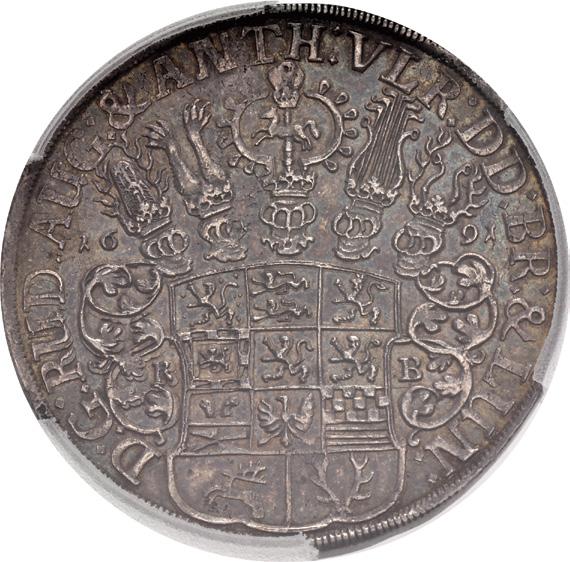
566927. GERMANY, Braunschweig-Wolfenbüttel. Rudolf August and Anton Ulrich. 1685-1704. AR Taler (45mm, 5h). Wildman type. Zellerfeld mint. Dated 1691 RB. D G RUD AUG & ANTH VLR DD BR & LUN, coat-of-arms surmounted by five crested helmets; 16 91 and R B flanking shield; diamond and double diamond stops / ნ UT FRONTIBUS ITA FRONDIBUS CONIUNCTISSIMI, pair of wildmen, each looking at the other, standing facing, each holding pair of crossed trees. Welter 2068B; Davenport 6393. In PCGS encapsulation, 38794404, graded AU58 Gold Shield. Well struck with iridescent toning. $1395
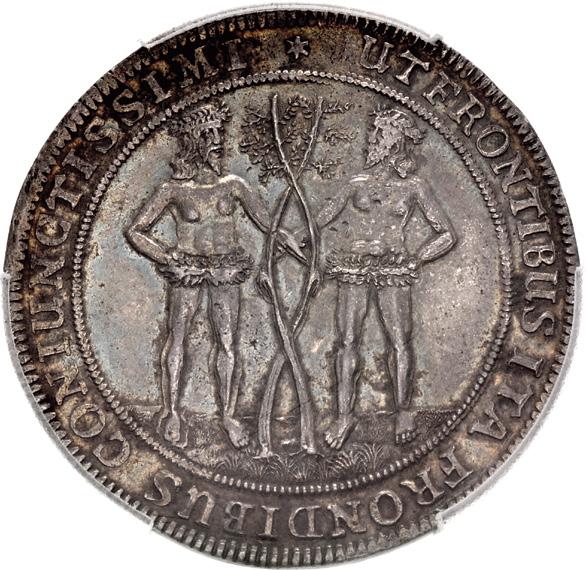
WORLD MEDALS
Of Colonial Algerian Interest
566921. FRANCE, Second Empire. Napoléon III. 1852-1870. AV 100 Franc Medal (36.5mm, 33.40 g, 12h). Premium of the General Agricultural Exposition at Oran, Algeria (24 September -2 October 1864). Prize for Animal Husbandry. By Barre. Dated 1864. NAPOLEON III EMPEREUR, laureate head right; BARRE below / GOUVERNEMENT GÉNÉRAL DE L´ ALGÉRIE Ⴛ , EXPOSITION/GÉNÉRALE AGRICOLE/A ORAN/(spacer)/ANIMAUX/REPRODUCTEURS/ ET AUTRES/1864 in eight lines. Edge: (bee) OR. Page-Divo –, but cf. 477 (for obverse in bronze). In PCGS encapsulation, 36683819, graded SP62 Gold Shield. Very rare. $5450
Ex iNumis (5 December 2018), lot 81.

566953. GERMANY, Frankfurt (Stadt). Cast Æ Plaquette (49x61mm, 65.22 g, 12h). Inauguration of the Synagogue of the Israelitische Religionsgesellschafton Friedberger Anlage, 29 August 1907. By Karl Goetz. Dated 1907. Sun rising behind façade of new synagogue, seen in perspective; above, House of Prayer Yeshurun in Hebrew; all within ornate arched widow set on four steps; NEUE SYNAGOGE DER JSR. RELIGIONSGES. ZU FRANKFURT A.M above; in two lines in exergue, EINGEWEIHET AM 29. AUGUST 1907 and corresponding date in Hebrew with additional quote from Isaiah 54:2, Blank. Edge: K · GOETZ. Kienast 394. Brown surfaces. EF. Of important historical interest. $695

Providing for 1600 worshippers, the Synagogue of the Israelitische Religionsgesellschaft on Friedberger Anlage was Frankfurt’s largest synagogue at the time. Designed by the renowned Berlin architects Peter Jürgensen and Jürgen Bachmann, the building incorporated contemporary decorative elements. Representatives of the Prussian Government and the City of Frankfurt took part in the ceremonies. During Kristallnacht in November 1938, the synagogue was set ablaze. While the synagogue was not completely destroyed, the Nazis claimed that it was in so great a danger of collapsing and threatening the public, that the remains had to be demolished. The Jewish Community was ordered to do so at its own cost. During World War II, a high-rise bunker was built on the foundations of the synagogue. While the bunker still exists today, it is now used for a permanent exhibition documenting Jewish life in Frankfurt’s Ostend.

566922. GERMANY, Hamburg. AV 10 Dukat Medal (41mm, 36.61 g, 12h). Restoration of the Spire of the Hauptkirche St. Petri, Destroyed in the Great Fire of Hamburg, 7 May 1842. By J. Lorenz. Dually dated 1842 and 1878. View of the Hauptkirche St. Petri, seen in perspective and set on entablature; J. LORENZ F. on entablature; 7. MAI.1842. 1878. in two lines in exergue / HERR/WOHIN SOLLEN/WIR GEHEN/DU HAST WORTE/DES/EWIGEN LEBENS. in six lines; EV. JOH. C. 6. V. 68. in exergue. Gaedechens Suppl. 2183. In PCGS encapsulation, 36683819, graded SP62 Gold Shield. Light hairlines. $4950


565856. GERMANY, Harz. AR Double Tauftaler (64mm, 52.18 g, 4h). Zellerfeld mint. Struck circa 1680. Ⴛ tauffet ſie im nomen nomen des vaters undt des ſohnes undt des h ·Geistes ·Mat · 28 · 19 Ⴛ (in Fraktur), baptism of Christ in the River Jordan by John the Baptist / Ⴛ wer glaubt undt getaufft wirdt der wirdt ſelig werden Marci · 16 · 16 (in Fraktur), Gott vater durch die tauff/zum kinde nimt mich auff/Gott ſohn mit ſeinem blut/macht mich gerecht und gut/Gott h · Geiſt zeucht ein/ mein lehrer troſt zu seyn/biſs aus der eitelkeit/ich komm zur ewigkeit/Gal · 3 · 26 · 27 · Tit · 3 · 5 · 6 · 7 ·/1 Pet · 3 · 2 · 1 in ten lines (in Fraktur); ornate scrollwork above; three rosettes, one obliterated by numeral 2 in incuse. Knyphausen 7295 var. (with mintmaster’s initials); Fassbender 2828 var. (same). Iridescent toning, slightly double struck, field marks and scratches, edge marks, evidence of having been placed in a bezel. EF. $3950

BRITISH
560902. ANGLO-SAXON, Kings of Wessex. Eadwig. 955-959. AR Penny (20mm, 1.31 g, 2h). Small cross/HorizontalTrefoil 1 (HT 1) type (BMC i). York mint; Heriger, moneyer. ส ዞ ± ዝ Ă Ɨ ŭ ያ ዞ ᛸ ณ , short cross pattée / ⎳ ያ Ɨ ű /ዞ ያ ዹ ɭ in two lines; three crosses pattée between, trefoils above and below. Tetny 87 (this coin?); CTCE 68; North 724; SCBC 1122. Attractively toned, a little off center and soft in parts. Near EF. Rare. $3950
Ex Dr. E Curti (Künker 227, 11 March 2013), lot 2349; Künker 159 (28 September 2009), lot 1755. Possibly ex Tetney, Lincolnshire, May 1945 Hoard.
Though not illustrated, the types and weight are a match for the coin in the Tetney Hoard.
560903. ANGLO-SAXON, Kings of All England. Eadgar. 959-975. AR Penny (20mm, 1.27 g, 7h). Small cross/HorizontalTrefoil 1 (HT 1) type (BMC i). North-Eastern mint; Manan, moneyer. Struck circa 959-968/9. ม ዞ © ዝ ű © ያ ያ ዞ ҟ + , short cross pattée / ҇ © n /© ዡ n ɭ in two lines; three crosses pattée between, trefoils above and below. CTCE 65; SCBI 9 (Ashmolean), 398 var. (same rev. die; pellets in obv. legend); North 741; SCBC 1129. Rich old toning. Good VF. $1650
559040. ANGLO-SAXON, Kings of All England. Æthelred II. 978-1016. AR Penny (20mm, 1.67 g, 12h). Long Cross type (BMC iva, Hild. D). Canterbury mint; Eadweald, moneyer. Struck circa 997-1003. ม ®Tዞ ⌦ ያ ዞ ዝ ያ ዞ ҟ © n ű ⌦ Tዝ ያ ዞ ҟ © é⌦ j, draped bust left; pellet behind head / ม ዞ ⍒ ዝ ዩ ɭ ዥ ዝ ȵ / ቸ / ɭ ü ®n ˶ , voided long cross, with pellet at center and triple-crescent ends. SCBI 7 (Copenhagen), 58 (same dies); North 774; SCBC 1151. A few light marks on reverse. Bold portrait. Toned. Good VF. $1950
Considered Hiberno-Norse by Dolley
560976. ANGLO-SAXON, Kings of All England. Æthelred II. 978-1016. AR Penny (18.5mm, 1.42 g, 4h). Helmet type (BMC viii, Hild. E). Ipswich mint; Godric, moneyer. Struck circa 1003-1009. ม ዞ ዝ ዞ ⌦ / ያ ዞ ዝ ያ ù ม ¨ ù ዢ , helmeted bust left / ม ű ዢ ∂ Ḧ ዝ ያ ዢ ù ዦ ∂ ű ዢ ዩ ዞ Ӳ , voided long cross with triple-crescent ends and pellet at center; in each quarter, trefoil on pile. Blackburn, Helmet p. 15, fig. 2a (same dies); Dolley, Michael, “An Unexpected ‘Mint’ in the Hiberno-Norse Imitative Series,” in NumCirc LXXXI.2 (February 1973), p. 44, fig. 1 (same dies); Sadler I 227-9 (dies 1/1); SCBI 7 (Copenhagen), 338 (same dies); North 775; SCBC 1152. A few peck marks. Toned. VF. Very rare and unusual. $1650
This issue was once believed to have been a part of the Hiberno-Norse series struck in Dublin, based on the distinctive style of the dies and, in part, on the fact that the spelling of the moneyer’s name as Giodric may be indicative of Middle Irish influence. Blackburn contends that it is instead an official English issue from East Anglian-style dies.
565835. ANGLO-SAXON, Kings of All England. Edward the Confessor. 1042-1066. AR Penny (18mm, 1.02 g, 4h). Trefoil Quadrilateral type (BMC iii, Hild. C). London mint; Beorthræd, moneyer. Struck circa 1046-1048. ม ዞ ዝ ዩ © / ያ ዝ ያ Ḧ ዞ Ḧ , diademed and draped bust left; scepter pommée to left / ม ዛ ያ ዢ ዡ ˸ ያ ዞ ዝ ɭ n ⌦ ⎍ n / Ḧ , quadrilateral, with pellet in center and trefoils at angles, over voided short cross. Freeman 172; SCBI 42 (South-Eastern), 1158 var. (legends); North 817; SCBC 1174. Minute striking perforation in legend. Rich cabinet toning with hints of iridescence. Near EF. $1150
539297. ANGLO-SAXON, Kings of All England. Edward the Confessor. 1042-1066. AR Penny (19mm, 1.72 g, 6h). Modern replica of the Sovereign/Eagles type (BMC ix, Hild. H) of the Horndon mint; Duding, moneyer, circa 1056-1059. ม ዞ © ዝ ⎍ ⎍ ያ ዝ ያ © ҟ © n ű ɭ ያ ⎍ Ḧ , Edward seated facing on throne, holding scepter and globus cruciger / ม ዝ ⎍ ዝ ዢ n ù ɭ n ዡ ɭ ያ n ዢ ዝ ⎍ ɉ Ḧ , voided cross, with martlet in each quarter. For original: Freeman p. 218 = BMC 554 (this coin); North 827; SCBC 1181. As made. A modern replica of the example in the British Museum, the only known coin of the Horndon mint. $425
565845. ANGLO-SAXON, Kings of All England. Edward the Confessor. 1042-1066. AR Penny (20mm, 1.27 g, 3h). Hammer Cross type (BMC xi, Hild. G). Exeter mint; Leofing, moneyer. Struck circa 1059-1062. ม ዞ © ዝ ዩ © ያ ያ ዝ ያ ዞ ҟ , crowned bust right, scepter before / ม ⌦ ዢ ዟ ዢ n ű ɭ n ዞ ҟ ዞ ù ዞ ˞ ˶ , voided cross, arms terminating in inward-facing crescents. Freeman 108; SCBI 2 (Hunterian), 1124 (same rev. die); North 828; SCBC 1182. Toned. VF. $725
543948. ANGLO-SAXON, Kings of All England. Edward the Confessor. 1042-1066. AR Penny (17mm, 1.40 g, 10h). Pyramids type (BMC xv, Hild. I). Stafford mint; Godwine, moneyer. Struck circa 1065-1066. ዞ © ዝ ዩ © ያ ዝ ያ ዞ , crowned bust right; scepter to right / ม ű ɭ ዝ ዩ ዢ n ዞ ɭ n S Ϳ ዢ ዞ , voided cross with annulet in center; pyramid in quarters. Freeman 30 (this coin cited); SCBI 1 (Fitzwilliam), 964 (same dies); North 831; SCBC 1184. Richly toned. Near EF. Rare. $1350
Ex Hodgson (Spink 230, 15 July 2015), lot 358, purchased from Spink, March 1975; F. Elmore-Jones (12 May 1971), lot 779.
543568. ANGLO-SAXON, Kings of All England. Edward the Confessor. 1042-1066. AR Penny (17mm, 1.37 g, 6h). Pyramids type (BMC xv, Hild. I). Tamworth mint; Coling, moneyer. Struck circa 1065-1066. ዞ © ዝ ዩ © ያ ዝ ያ ዞ ҟ , crowned bust right; scepter to right / ม ù ɭ ⌦ ⌦ ዢ n ű ɭ n Ϳ © ȵ ⎍ ⎍ , voided cross with annulet in center; pyramid in quarters. Danson 68a-c (same rev. die); Freeman 30; SCBI 17 (Midlands), 504 (same rev. die); North 831; SCBC 1184. Rich glossy toning, small spot of weakness. Good VF. Very rare. $2750
Ex R.J. Eaglen (Baldwin’s 18, 12 October 1998), lot 1539; Glendinings, 30 September 1987, lot 226.
559041. NORMAN. William I ‘the Conqueror’. 1066-1087. AR Penny (19mm, 1.25 g, 6h). Profile/Cross Fleurée type (BMC i). Romney mint; Wulfmær, moneyer. Struck 1066-1068. ม ዢ ⌦ ⌦ ዞ ȵ ዢ ዢ ያ ዞ ҟ ዢ , crowned bust left; scepter to left / ม ዩ ⎍ ⌦ ዟ ʼ ®ʼ ɭ n ʼ ዢ ዢ , cross fleurée, with pellet-in-annulet at center. SCBI –; BMC 39; North 839; SCBC 1250. Slight weakness in reverse legend. Toned. Good VF. $3950
554622. NORMAN. William I ‘the Conqueror’. 1066-1087. AR Penny (20mm, 1.36 g, 12h). Paxs type (BMC viii). Nottingham mint; Mann, moneyer. Struck circa 1083-1086. ม ዩ ዢ ⌦ ⌦ ዞ ⌦ ȵ ያ ዞ ҟ , crowned facing bust, holding lis-tipped scepter in right hand; trefoil on shoulder / ม ȵ ዢ ዢ n ዢ ዢ ɭ n S n ɭ ˸ ዢ , cross pattée; letters of P A X S in annulets within quarters. SCBI 20 (Mack), 1349 (this coin); BMC 854; North 850; SCBC 1257. Weak below bust as usual for this die. Toned. VF. Very rare. $2150
Ex R.P. Mack (Part I, Glendining’s, 18 November 1975), lot 249, purchased from Spink, October 1953.
554623. NORMAN. Stephen. 1135-1154. AR Penny (20mm, 1.47 g, 8h). Cross Moline (‘Watford’) type (BMC i). ‘Delca’ mint (in East Anglia?); Willelm, moneyer. Struck circa 1136-1145. ม [S ]Ϳ ዢ ዞ [ዟ ]n ዞ ያ , crowned bust right, holding lis-tipped scepter / ม [...]ዢ ⌦ ⌦ ዞ ȵ Ḧ ɭ n Ḧ ዝ ዞ ⌦ ü ¥ , cross moline. EMC 2009.0267 = Coin Register 2010, 299 (this coin); Mack –; SCBI –; North 873; SCBC 1278. Some porosity and areas of weak strike, clear legends. Near VF. Extremely rare. $1750
Found Clifton Reynes, Milton Keynes, 2009.
555820. PLANTAGENET. Edward III. 1327-1377. AV Quarter Noble (19mm, 1.96 g, 10h). Fourth coinage, Treaty Series B, Group a. Tower (London) mint. Struck 1363-1369. ๘ Ě ĕ Ѿ ¨ ʽ ĕ Ḻ ĕ Ě Ʊ Ḻ ŷ ʽ ¨ Ḻ ʽ Ě Ҡ Ḻ ¨ N ŷ ǭ , coat-of-arms within tressure of eight arcs; trefoil at end of each arc / ๘ Ě Ҡ ¨ ǭ ˸ ¨ B Ʊ ˸ ѝ ʽ Ḻ Ʊ N Ḻ ŷ ǭ ɨ ʽ Ʊ ¨ , cross fleurée et fleurdelisée; in each quarter, lion passant left over trefoil; at center, lis within quadrilobe; all within tressure of eight arcs. Lawrence 1/1; Schneider 82; North 1243; SCBC 1510. Hint of luster. Good VF. $1350
Heavy Coinage Halfgroat
561967. LANCASTER. Henry IV. 1399-1413. AR Halfgroat (21.5mm, 2.16 g, 12h). Heavy coinage. London (Tower) mint. Struck 1399-1412. ๘ ƌ Ě N ˊ Ʃ ý ⎡ ĕ Ʃ ⎡ ŷ ˊ ¨ ⎡ ˊ Ě Ң ᚤ ¨ N ŷ ǭ ⎡ Ԥ ⎡ ō = , crowned facing bust within tressure of arches; lis at cusps; star on breast / ๘ P ɨ ˫ ѝ Ʃ ĕ Ě ѝ ⍴ ᚤ ¨ ĕ Ʃ ѝ ˸ ɨ ˊ Ě ⍴ ᚤ ⍴ Ě ѝ / ý Ʃ ѝ Ʃ ˸ ¨ ˫ ǭ ɨ Ʃ Ʃ ĕ ɨ Ʃ Ʃ , cross pattée; trefoils in angles. MHG 1/1; North 1346; SCBC 1718. A few light marks. Near VF. Extremely rare – one of eight known, three of which are in museums. $5500
565846. LANCASTER. Henry VI. First reign, 1422-1461. AR Groat (27mm, 3.81 g, 12h). Annulet issue. Calais mint; im: pierced cross 2. Struck 1422-1430. 2 ƌ E N R i ý ⎡ D i = ⎡ ŷ ˆ ¨ ⎡ ˆ E Ҟ ⎡ ¨ N ŷ Ȅ ⎡ ⎜ ᚤ f ˆ ¨ N ý , crowned facing bust within tressure of arches; lis at cusps; annulets flanking neck / 2 ʏ ɨ S ѝ i ი D E ѝ M Ḻ ¨ D i ѝ T ɨ R E = M E ѝ M / ѝ i Ȅ Ȅ ¨ Ḻ ý ¨ Ȅ i S i E Ḻ , long cross; trefoil in quarters, annulets within second and third trefoil. Whitton, Heavy 10 var. (unbroken Є on reverse); North 1424; SCBC 1836. Deep cabinet toning. Good VF. $395
556639. LANCASTER. Henry VI. First reign, 1422-1461. AR Halfgroat (22mm, 1.63 g, 8h). Annulet issue. York mint; im: pierced cross 2. Struck 1422-1430. 2 ƌ Ě N ˊ Ʃ ý ⎡ ĕ Ʃ ⎡ ŷ ˊ ¨ ⎡ ˊ Ě Ң ᚤ ¨ N ŷ ǭ ⎡ Ԥ ⎡ ō = , crowned facing bust within tressure of arches; lis at cusps; lis flanking neck / 2 P ɨ ˫ ѝ Ʃ ი ĕ Ě ѝ ⍴ Ḻ ¨ ĕ Ʃ ѝ ˸ ɨ ˊ Ě ⎡ ⍴ = / ý Ʃ ѝ Ʃ ˸ ¨ ˫ Ḻ Ě B ɨ ˊ ¨ ý Ʃ ი , long cross; trefoil in quarters, annulets within first and third trefoil. Whitton, Heavy 4; MHG 1ii/2ii; North 1430; SCBC 1843. Edge slightly frayed at 7 o’clock, otherwise struck on a full flan. VF. Very rare. $3750
Found near Bishop’s Lydeard, Somerset, August 2020.
559043. LANCASTER. Henry VI. First reign, 1422-1461. AR Halfgroat (21mm, 1.90 g, 4h). Rosette-mascle issue. Calais mint; im: cross V. Struck 1430-1431. ม ƌ Ě N ˊ Ʃ ý = ḥ ĕ Ʃ = ḥ ŷ ˊ ¨ = ḥ ˊ Ě Ң ℽ ¨ N ŷ ǭ = ḥ Ԥ ḥ ō , crowned facing bust within tressure of arches; trefoils at cusps / ม P ɨ ˫ ѝ Ʃ ḥ ĕ Ě ѝ ⍴ Ḻ ¨ ĕ Ʃ ѝ ˸ ɨ ˊ Ě ⎡ ⍴ Ě ѝ ⍴ / ѝ Ʃ ǭ ℽ ǭ ¨ Ḻ ý ¨ ǭ Ʃ ˫ Ʃ Ě ḥ , long cross; trefoil in quarters. Whitton, Heavy 18; MHG 5/2; North 1448; SCBC 1862. Good VF. $425
Ex CNG inventory 866825 (March 2010).
536819. LANCASTER. Henry VI. First reign, 1422-1461. AR Groat (26mm, 3.55 g, 2h). Leaf-mascle issue. London (Tower) mint; im: voided cross/cross pattée. Struck 1432/3-1436. ม ƌ Ě N ˊ Ʃ ý ⎡ ĕ Ʃ ⎡ ŷ ˊ ¨ ⎡ ˊ Ě Ң ℽ ¨ N ŷ ǭ ⎡ Ԥ ᚤ ō ˊ ¨ N = , crowned facing bust within tressure of arches with trefoils at cusps; leaf below bust / ม P ɨ ˫ ѝ Ʃ ĕ Ě ѝ ⍴ Ḻ ¨ ĕ Ʃ ѝ ˸ ɨ ˊ Ě ⎡ ⍴ Ě ѝ ⍴ / ý Ʃ ѝ Ʃ ˸ ¨ ˫ ǭ ɨ N Ḻ ĕ ɨ N , long cross pattée; trefoils in quarters. Whitton, Heavy 20c (this coin?); North 1474; SCBC 1889. Toned. VF. A very rare coin with a good provenance. $650
Ex I. Buck (Spink 176, 30 November 2005), lot 211, purchased from Spink, November 2004; Dr. E. Burstall (Glendining’s, 15 May 1968), lot 81; R.C. Lockett (English Part II, 11 October 1956), lot 1463 (part of).
559044
556968 559044. YORK. Edward IV. First reign, 1461-1470. AR Groat (27mm, 3.69 g, 2h). Heavy coinage, group III. Tower (London) mint; im: rose. Struck 1464. ḥ Ě ĕ Ѿ ¨ ˊ ĕ ⎡ ĕ Ʃ ⎡ ŷ ˊ ¨ ⎡ ˊ Ě Ң ᚤ ¨ N ŷ ǭ ⎡ Ԥ ᚤ ō ˊ ¨ N = , crowned facing bust within tressure of arches with trefoils at cusps; quatrefoils at neck, trefoil on breast / ม P ɨ ˫ ѝ Ʃ ĕ Ě ѝ ⍴ Ḻ ¨ ĕ Ʃ ѝ ˸ ɨ ˊ Ě ⎡ ⍴ Ě ѝ ⍴ /ý Ʃ ѝ Ʃ ˸ ¨ ˫ (eye) ǭ ɨ N ĕ ɨ N , long cross pattée; trefoils in quarters. Blunt & Whitton type IIId; North 1532; SCBC 1972. Slightly double struck in parts. Toned. Good VF. $595
Ex Classical Numismatic Group 46 (24 June 1998), lot 1948.
556968. TUDOR. Henry VII. 1485-1509. AR Groat (25mm, 3.11 g, 5h). Type II. London (Tower) mint; im: none. ƌ Ě N ˊ Ʃ ý $ ĕ Ʃ $ ŷ ˊ ¥ $ ˊ Ě Ң $ ¥ N ŷ ǭ $ Ԥ $ ō ˊ ¥ N ý , crowned facing bust within tressure of arches with trefoils at cusps; saltires my neck / $ P ɨ ˫ ѝ Ʃ ĕ Ě ѝ ⍴ $ ¥ ĕ Ʃ ѝ ˸ ɨ ˊ Ě ⍴ Ě ѝ ⍴ / ý Ʃ ѝ Ʃ ˸ ¥ ˫ ǭ ɨ N ĕ ɨ N , long cross pattée; trefoils in quarters. SCBI 23 (Ashmolean), 188 (same dies); North 1704; SCBC 2196. Toned. Good VF. $750
565847. TUDOR. Henry VII. 1485-1509. AR Groat (26mm, 3.08 g, 7h). Profile issue. Tower (London) mint; im: crosscrosslet with two pellets. Struck 1504-1505. (cross-crosslet) Ƈ Ě N ˊ Ʃ ý ⎡ ѝ Ʃ Ʃ ᚤ ĕ Ʃ ⎡ ŷ ˊ ¨ ⎡ ˊ Ě Ң ᚤ ¨ ŷ Ȅ ⎡ Z ᚤ f ˊ = , crowned bust right / (cross-crosslet) P ɨ ˫ ѝ Ʃ ĕ Ě ѝ ⍴ = Ḻ ¨ ĕ Ʃ ѝ ˸ ɨ ˊ Ě = Ḻ ⍴ Ě ѝ ⍴ , coat-of-arms over long cross fourchée. SCBI 23 (Ashmolean), 816-7; North 1747; SCBC 2258. A few light marks, legend weak in part. Rich old tone. Good VF. Pleasing portrait. $1350

565848. TUDOR. Henry VII. 1485-1509. AR Halfgroat (20mm, 1.31565848 g, 5h). Profile issue. York mint, under Archbishop 565849 Christopher Bainbridge; im: martlet. Struck 1504-1509. (martlet) Ƈ Ě N ˊ Ʃ ý ⎡ ѝ Ʃ Ʃ ᚤ ĕ Ʃ ⎡ ŷ ˊ ¨ ⎡ ˊ Ě Ң ᚤ ¨ ŷ Ȅ ⎡ Z ᚤ , crowned bust right / (martlet) P ɨ ˫ ѝ Ʃ ĕ Ě ѝ ⍴ ⎡ ¨ ĕ Ʃ ѝ ˸ ɨ ˊ Ě ⎡ ⍴ Ě ѝ ⍴ , coat-of-arms over long cross fourchée; crossed keys below. North 1751/1; SCBC 2262. Attractively toned with hints of blue. VF. $475 565849. TUDOR. Henry VIII. 1509-1547. AR Halfgroat (17.5mm, 1.42 g, 9h). Second coinage. Canterbury mint, under Archbishop William Warham; im: uncertain mark. Struck 1526-1544. (uncertain mark) Ƈ Ě N ˊ Ʃ ý ⎡ ѝ Ʃ Ʃ Ʃ ⎡ ĕ Ʃ ⎡ ŷ ⎡ ˊ ⎡ Z ᚤ f ˊ , crowned bust right / (uncertain mark) ý Ʃ ѝ Ʃ ˸ ¨ ˫ ý ¨ N ˸ ɨ ˊ , coat-of-arms over long cross fourchée, with saltires by forks; Ѿ ¨ flanking. Whitton p. 209, (i); North 1802; SCBC 2343. Deeply toned. VF. $325
565941
559045 565941. TUDOR. Henry VIII. 1509-1547. AR Groat (25mm, 2.46 g, 2h). Third coinage. Tower (London) mint; im: lis. Struck 1544-1547. ჭ Ƈ Ě N ˊ Ʃ ý ⎡ ⎡ ĕ ⎡ ŷ ⎡ ¨ ŷ Ȅ ⎡ f ˊ ¨ ⎡ Z ᚤ Ƈ Ʃ B ⎡ ˊ Ě Ң , crowned and mantled bust facing slightly right (Laker A) / ჭ P ɨ ˫ ѝ Ʃ ĕ Ě ѝ = Ḻ ¨ ĕ Ʃ ѝ ˸ ɨ ˊ Ě = Ḻ ⍴ Ě ѝ ⎡ , coat-of-arms over long cross fourchée, with annulets in forks. Whitton p. 207, (iv); North 1844; SCBC 2369. Slightly double struck. Toned. Good VF. Good metal. $1250 559045. TUDOR. Edward VI. 1547-1553. AR Shilling (33mm, 6.56 g, 9h). Third period, fine silver issue. Tower (London) mint; im: tun. Struck 1551-1553. Ḧ (tun) Ḧ Ě ĕ Ѿ ¨ ˊ ĕ = / ѝ Ʃ Ḧ ĕ = / ŷ = / ¨ ŷ Ȅ = / f ˊ ¨ = / Z / Ƈ Ʃ B = / ˊ Ě Ң , crowned and mantled bust facing slightly left; rose to left, XII to right / P ɨ ˫ ѝ Ʃ ĕ Ě ѝ = / ¨ ĕ Ʃ ѝ ˸ ɨ ˊ Ě = Ḧ ⍴ Ě ѝ = / , coat-of-arms over long cross fourchée. North 1937; SCBC 2482. Toned. Good VF. Struck on a broad flan. $1450
562218. TUDOR. Philip & Mary. 1554-1558. Electrotype AR Halfcrown (31mm, 13.52 g, 6h). Tower (London) mint. Dated 1554. Electrotype by Robert Ready. · PHILIPVS · D · G · R · ANG · FR · NEAP · PR · HISP ·, armored bust right, wearing ruff / · MARIA · D · G · R · ANG · FR · NEAP · PR · HISP ·, bust left, wearing ruff and head covering. Edge: stamped RR (Roberty Ready). SCBC 2497A (for original). Toned. Near Fine. A handsome electrotype of the British Museum example of this great rarity. $1450
Ex C. Adams (Spink 177, 1 December 2005), lot 41.

565986. TUDOR. Elizabeth I. 1558-1603. AR Halfcrown (35mm, 15.02 g, 9h). Seventh issue. Tower (London) mint; im: 1. Struck 1601-1602. : 1 : ELIZABETH : D’· G’· ANG’· FRA’· ET L HIBER’· REGINA, crowned bust left, wearing ruff, holding lis-tipped scepter in right hand / : 1 : POSVI : DEVM : AD IVTORE M : MEVM :, coat-of-arms over long cross fourchée. BCW 1-1/1-a1; North 2013; SCBC 2583. Some minor metal stress in parts. Richly toned. Good VF. A pleasing coin with a strong portrait. $8950
565942 565943 565942. TUDOR. Elizabeth I. 1558-1603. AR Sixpence (25mm, 2.84 g, 7h). Milled coinage. Tower (London) mint; im: star. Dated 1562. (star) ELIZABETH · D · G · ANG · FRA · ET · HIB · REGINA, crowned bust left, wearing ruff and plain dress; rose to right / (star) POSVI DEVM · AD IVTORE · MEVM, coat-of-arms over long cross fourchée; · 1562 · above. North 2025/1; SCBC 2594. Light scratch under colorful light tone. VF. $950 565943. TUDOR. Elizabeth I. 1558-1603. AR Sixpence (25mm, 2.96 g, 7h). Milled coinage. Tower (London) mint; im: star. Dated 1562. (star) ELIZABETH · D · G · ANG · FRA · ET · HIB · REGINA, crowned bust left, wearing ruff and elaborately decorated dress; rose to right / (star) POSVI DEVM · AD IVTORE · MEVM, coat-of-arms over long cross fourchée; · 1562 · above. North 2026; SCBC 2595. Toned. VF. $1100
565987 565946
565987. STUART. Charles I. 1625-1649. AR Halfcrown (32mm, 14.91 g, 4h). Group II, type 3a3. Tower (London) mint im: P in brackets. Struck under Parliament, 1643-1644. (P) CAROLVS · D’· G’· MAG’· BRI’· FR’· ET · HI’· REX, Charles on horseback left, holding reigns and sword / (P) CHRISTO · AVSPICE · REGNO, coat-of-arms. Bull 496b/36 (this coin illustrated); Francis 3c-5, pl. V, fig. 1 (this coin illustrated); Brooker 354-6 var. (obv. legend); North 2213; SCBC 2778. Slightly double struck on reverse and weak on horse’s legs. Richly toned. Near EF. Strong portrait. $1350
Ex J.M. Ashby (Spink 145, 14 July 2000), lot 2068, purchased from Seaby, 1960; G.R. Francis (Glendining, 24 March 1920), lot 147; B. Roth Collection (Sotheby, Wilkinson & Hodge, 14 October 1918), lot 310; H. Montagu (Sotheby, Wilkinson & Hodge, 18 November 1895), lot 322.
565946. STUART. Charles I. 1625-1649. AR Sixpence (25mm, 3.06 g, 6h). Group F, type 4.3. Tower (London) mint; im: triangle. Struck 1639-1640. Δ CAROLVS · D’· G’· MAG’· BRI’· FRA’· ET · HI’· REX, crowned bust left; VI to right / · Δ · CHRISTO · AVSPICE · REGNO, coat-of-arms over short cross fourchée. Brooker 645-6; North 2246; SCBC 2817. Double struck on reverse. Toned. Near EF. $425
565945. STUART. Charles I. 1625-1649. AR Shilling (30mm, 6.08 g, 6h). Second milled (Nicholas Briot’s) issue. Tower (London) mint; im: anchor and в. Struck 1638-1639. (anchor with в) CAROLVS · D : G · MAG · BRIT · FR · ET · HI · REX ·, crowned bust left; XII · to right / (anchor with в) CHRISTO · AVSPICE · REGNO ·, coat-of-arms over short cross fourchée. Brooker 725-6 (same dies); North 2305; SCBC 2859. Toned, minor adjustment marks on reverse. Good VF. $1650

529570. STUART. Charles I. 1625-1649. Reproduction AR Crown (43mm, 29.78 g, 5h). Declaration type. Oxford mint Dies by T. Rawlins. Dated 1644. (rosette) CAROLVS : D : G : MAG : BRIT : FRAN : ET · HIBER · REX, Charles on horseback left, holding sword and reigns; below, OXON and view of Oxford / (floral spray) DEVS (floral spray) DISSIPENTVR (floral spray) INIMICI (floral spray) EXVRGAT, RELIG • PROT • LEG/ ANG • LIBER • PARL between floral scrolls; three crowns and V above, 1644 and OXON below. For original: Morrieson, Oxford A/1; Brooker 876; North 2407; SCBC 2948. Toned, flan crack. VF. Cast copy (?) of this famous type. $2250
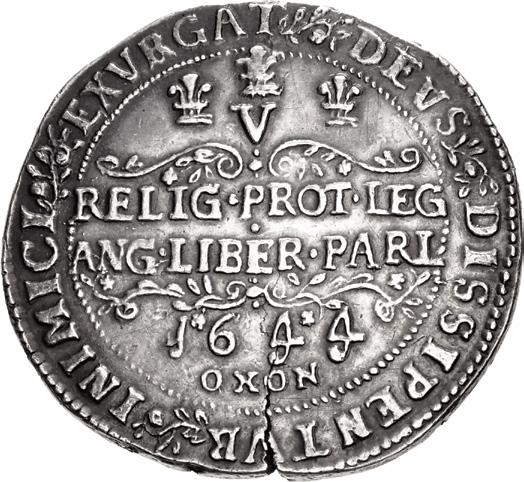
Ex Mark Freehill Collection; W.J. Lawson Collection.
A ‘die duplicate’ of this curious imitation was published in the International Bureau for the Suppression of Counterfeit Coins Bulletin, Vol. 3, No. 4 (Winter 1978). That specimen was described as ‘struck’ and ‘probably the work of a nineteenth century forger’. Like our coin the specimen published in the ISBCC Bulletin has striking splits which are anomalous for a cast coin. However both the ISBCC coin and this coin lack the sharpness of detail to be expected from a struck coin. From the small corpus of genuine specimens of this celebrated type it has been impossible to trace the the original coin from which these forgeries were cast, if indeed they were.
565947. STUART. Charles I. 1625-1649. AR Groat (21mm, 1.60 g, 5h). Exeter mint; im: rose. Dated 1644. (rose) 1644 CAROLVS · D · G · M · B · F · ET · HI · REX, crowned bust left; IIII to right / (rose) : CHRISTO · AVSPICE · REGNO, coatof-arms. Brooker 1071 (same dies); North 2579; SCBC 3088. Attractively toned. Good VF. $1050

564088. COMMONWEALTH. 1649-1660. AR Crown (44mm, 29.94 g, 5h). Tower (London) mint; im: sun. Dated 1656/4. (sun) · THE · COMMONWEALTH · OF · ENGLAND ·, coat-of-arms within wreath / · GOD · WITH · VS · 1656, two coats-ofarms; · V · (mark of value) above. ESC 9; North 2721; SCBC 3214. Richly toned, a little soft at center. Good VF. Well struck on a full round flan. $6750

565991. STUART. Charles II. 1660-1685. AV Half Guinea (21mm, 4.21 g, 6h). Milled coinage. Tower (London) mint. Dated 1670. CAROLVS · II · DEI · GRATIA, laureate first bust right / · MAG · BR · FRA · ET · HIB · REX · 16 70, crowned cruciform coats-of-arms with scepters in angles; interlocking Cs at center. MCE 93; SCBC 3347. Small mark on reverse. Attractive orange-red toning. VF. Rare. $2750
565948. STUART. Charles II. 1660-1685. AR Halfcrown (32mm, 14.80 g, 6h). Milled coinage. Tower (London) mint. Dated 1663. CAROLVS · II · DEI · GRATIA (V over S), laureate and draped first bust right / · MAG · BR · FRA · ET · HIB · REX · 16 63, crowned cruciform coats-of-arms with interlocking Cs in angles; rayed Garter star at center. ESC 457A; SCBC 3361. Richly toned, tiny edge ding. VF. Rare engraver’s error. $1050

559263. STUART. James II. 1685-1688. AV Guinea (25mm, 8.36 g, 6h). Tower (London) mint. Dated 1688. IACOBVS · II · DEI · GRATIA, laureate head left / · MAG · BR · FRA · ET · HIB · REX · 16 88, crowned cruciform coats-of-arms with scepters in angles. MCE 130; SCBC 3402. Lightly toned with significant luster. Choice EF. Rare. A most attractive specimen. $16,500
PF 70 Ultra Cameo – Total Mintage of 500 Specimens

566931. WINDSOR. Elizabeth II. 1952-present. Proof AV One hundred pounds (33mm, 12h). Commemorating the Quatercentenary of the Sailing of the Mayflower. Royal Mint. Dually dated 1620 and 2020. ELIZABETH · II · D · G · REG · F · D · 100 POUNDS ·, crowned head right; JC below / 1620 2020 ✬ MAYFLOWER ✬, Mayflower slightly left under full sail. SCBC –, but cf. RMB53 (Twenty five pounds). In NGC encapsulation, 6039445-140, graded PF 70 Ultra Cameo. Only 500 examples struck. $4500

514044. SCOTLAND. Robert III. 1390-1406. AR Groat (27mm, 2.80 g, 8h). Heavy coinage. Edinburgh mint. Struck 1390-circa 1403. ๘ ˊ ɨ B Ě ˊ Ϳ ⎍ S ḧ ĕ Ě Ʃ ḧ Ŷ ˊ a ḧ ˊ Ě Ң ḧ S ý ɨ Ϳ ɨ ˊ ⎍ ⍴ , crowned facing bust within tressure of seven arches; three large pellets at cusps / ๘ ĕ N S Ḻ P Ϳ Ě ý Ϳ ɨ ˊ ⍴ S ᚤ Ԥ ᚤ ǭ Ʃ B a Ϳ ɨ ˊ ⍴ S / ⎍ Ʃ ǭ ǭ a Ě ĕ Ʃ N B ⎍ ˊ Ŷ ƌ Ḻ , long cross pattée; trefoil in quarters. Burns 5 (fig. 348); SCBI 35 (Ashmolean & Hunterian), 540-1; SCBC 5164. Some weakness in legend. Toned. Good VF. $650
566299. SCOTLAND. James III. 1460-1488. AV Rider (24mm, 4.91 g, 9h). Edinburgh mint. Struck 1475-1483. Ʊ ¨ ý ɨ B ⎍ ˫ Ḻ ĕ Ě Ʊ Ḻ g ˆ ¨ Ḻ ˆ Ě Ң ˫ ý ɨ Ϳ ɨ ˆ ⎍ ⍴ , James on horseback right, holding sword and reigns / ˫ ¨ ǭ ⎍ ⎍ ⍴ Ŗ ¨ ý P ɨ P ⎍ ǭ ⎍ ⍴ Ϳ ⎍ ⎍ ⍴ ĕ N Ě , crowned coat-of-arms over long cross pattée. Burns 5 (fig. 601/600; same dies); SCBI 35 (Ashmolean & Hunterian), 7230 var. (obv. legend stops; same rev. die); SCBC 5256. Toned. VF. Well struck on a broad flan. Rare. $12,750
Ex R. Wilson (Spink 189, 27 June 2007), lot 127; Dix Noonan Webb 67 (28 September 2005), lot 1150; Spink Numismatic Circular XCI.7 (September 1983), no. 5581; Clonterbrook Trust Collection (Glendining, 7 June 1974), lot 321; R.C. Lockett (Scottish Part II, Glendining, 26 October 1960), lot 855; R.W. Cochran-Patrick (Sotheby & Co., 30 March 1936), lot 32.
565992. SCOTLAND. James VI. 1567-1625. AR Thistle Merk (32mm, 6.90 g, 9h). Eighth coinage. Edinburgh mint. Dated 1602. IACOBVS · 6 · D · G · R · SCOTORVM, crowned coat-of-arms / REGEM · IOVA · PROTEGIT · 1602, crowned thistle. Burns 33 (fig. 943); SCBI 58 (Edinburgh), 1571/1572 (same obv./rev. dies); SCBC 5497. Iridescent cabinet toning. Good VF. $1450

559012. SCOTLAND. Charles I. 1625-1649. AR Sixty Shillings (43mm, 29.80 g, 6h). Third coinage, Briot’s issue, type I. Edinburgh mint; im: thistle and · в ·. Struck 1637-1642. (thistle and · в ·) CAROLVS · D : G · MAG · BRITANN · FRANC · ET · HIBERN · REX · (lozenge stops), Charles on horseback left, holding sword and reins / QVÆ · DEVS · CONIVNXIT · NEMO · SEPARET · (thistle and · в ·), crowned coat-of-arms. Burns 5 (fig. 1005; same dies); SCBI 35 (Ashmolean & Hunterian), 1424-1426 (same dies); SCBC 5552. A few very minor metal flaws and very light adjustment marks. Toned with hints of luster. Good VF. Rare. $8500

Ex P. Karon (Spink 129, 17 November 1998), lot 128.
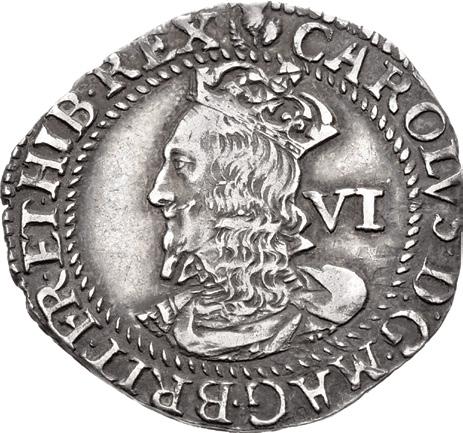
559013. SCOTLAND. Charles I. 1625-1649. AR Six Shillings (24mm, 2.89 g, 6h). Third coinage, Falconer’s second issue, type IV. Edinburgh mint; im: thistle and F. Struck 1637-1642. (thistle) CAROLVS · D : G · MAG · BRIT · FR · ET · HIB · REX, crowned bust left; VI (mark of value) to right / QVÆ · DEVS · CONIVNXIT · NEMO · SEPARE (small F), crowned coat-of-arms; crowned C R flanking. Burns 55 var. (rev. legend); SCBI 35 (Ashmolean & Hunterian), 1513 var. (legends); SCBC 5571. Reverse a little off center. Toned. Good VF. Rare. $825
Ex “Important Collection of Scottish Coins” (Dix Noonan Webb 55, 8 October 2002), lot 820; Lord Grantley (Part V, Glendining, 18 May 1944), lot 1809 (part of), purchased from Baldwin’s.
559015. SCOTLAND. William & Mary. 1689-1694. CU Bawbee (26mm, 8.32 g, 1h). Edinburgh mint. Dated 1691. + GVL · ET · MAR · D · G · MAG · BR · FR · ET · HIB · REX · ET · REGINA, jugate busts of William, laureate and draped, and Mary, draped, left / NEMO · ME · IMPVNE · LACESSET · 1691 ·, crowned thistle. Burns p. 515; SCBI 35 (Ashmolean & Hunterian), 1716; SCBC 5666. Attractive light chocolate brown surfaces, slightly weak on obverse. Good VF. Rare, with an exceptionally well struck thistle. $950
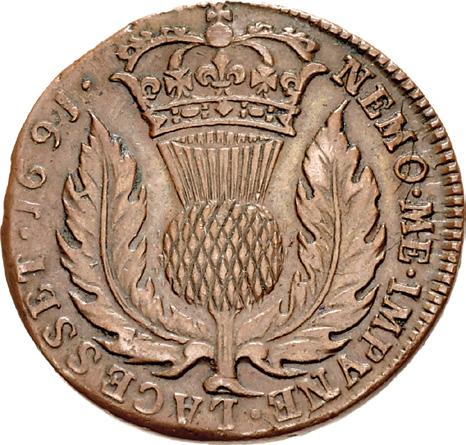
Ex L. LaRiviere (Spink 179, 29 March 2006), 265 (part of); Spink 20 (31 March 1982), lot 319 (part of).
565995. IRELAND. Edward I. 1272-1307. AR Penny (20mm, 1.64 g, 4h). Contemporary imitation of the second (’ЄDW’) coinage form the Dublin mint. / ģ ĕ Ѿ / ʼ / ¨ n ŷ ⌦ ĕ n S ዢ ӎ B , crowned facing bust; two pellets below; all within triangle / ý Ʃ ѝ Ʃ Ϳ ¨ S ĕ ѝ B ⌦ Ʃ n Ʃ Ě , long cross pattée, with trefoil in each angle. North, Anglo-Irish p. 18; cf. Mayhew 380 (for similar imitation); cf. SCBC 6246A (for official issue). Toned. Good VF. An unusual and rare imitation. $450
The Great Rebellion - Inchiquin Shilling
537704. IRELAND, The Great Rebellion. Issues of the Lords Justices. 1642-1649. AR Shilling (26mm, 5.85 g, 6h). “Inchiquin Money” issue. First issue. Dublin mint. Struck 1642. “dwt...gr 3...21” (denomination) in two lines within linear and beaded border / “dwt...gr 3...21” (denomination) in two lines within linear and beaded border. D&F 279; SCBC 6534. A few light marks. Toned. Near VF. Very rare. $10,250
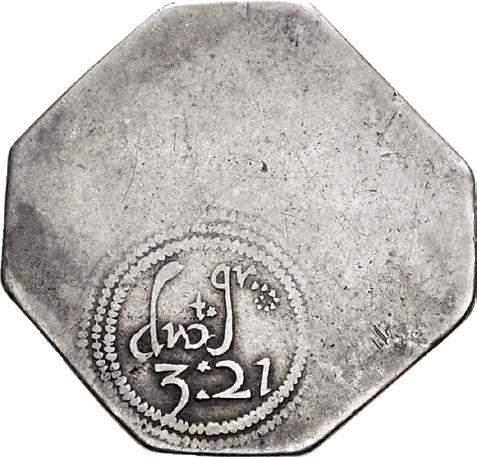
Ex Marvin Lessen Collection; ‘The Coins and Tokens of Ireland From the Earliest Times to the Present Day,’ Spink Numismatic Circular LXXVIII.5 (May 1970) no. 5886.
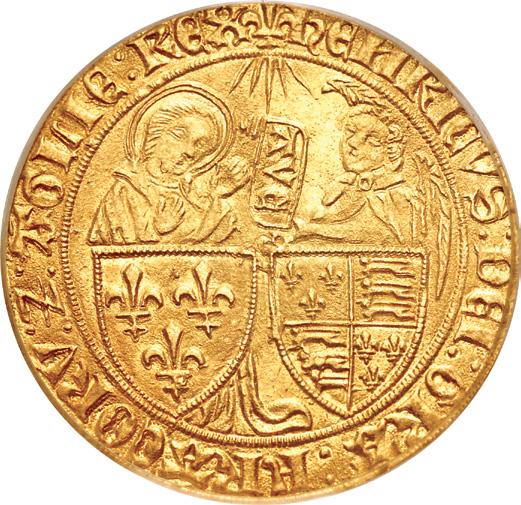
566924. ANGLO-GALLIC. Henry VI. 1422-1461. AV Salute d’or (26mm, 1h). Saint-Lô mint; im: lis. Arnoulet Rame, mintmaster. Second issue, authorized 6 September 1423. ჭ ƌ E Ƀ ˆ i ý V s Ḧ D E i Ḧ ŷ ˆ A Ḧ f ˆ A ý ɨ ˆ ⎍ Ḧ Ӧ Ḧ A ŷ L i E Ḧ ˆ E X , the Annunciation: the Virgin, standing facing, receiving tablet inscribed _ ⎍ ģ from the Archangel Gabriel standing left; heavenly light above, two coats-of-arms below / ჭ X P ý Ṉ V i n ý i ˶ Ṅ X P ý Ṉ ˆ E ŷ n A ˶ Ṅ X P ý Ṉ i M P E ˆ A ˶ , Latin cross; lis to left, lion passant to right; ƌ below; all within tressure of ten arcs; lis at point of each arc. AGC 387A (die combination unlistred); Beresford-Jones, Salutes 12; cf. Beresford-Jones, Anglo-Gallic 550/561; Elias 271; Schneider 119; SCBC 8164. In PCGS encapsulation 14002334, graded MS 64. Well struck. $5250
BRITISH MEDALS

566935. HANOVER. Sir Thomas Gresham. 1519-1579. Æ Medal (73mm, 202.20 g, 12h). Reopening of the Royal Stock Exchange, 28 October 1844. By W. Wyon. Dated 1844. EMPORIVM REGIVM A. THOMA GRESHAM EQ. AVR. CIVE LONDINENSI CONDITVM A. S. MDLXXI., draped bust left, wearing cap and elaborate collar; W.WYON R.A. on truncation of shoulder / REST. ET. APERT. AVSP. VICTORIA REG, statue of Victoria left, with scepter and orb; all set on pediment inscribed A : S. MDCCCXLIV/XXVIII OCT. in two lines; view of the Royal Exchange in background; W : TITE F.R.S. ARCHT W.WYON RA.FECIT. below in forecourt. BHM 2185; Eimer 1390. Rich mahogany brown surfaces. EF. $475
